Japan Itinerary 10 Days: An Amazing Journey Through the Land of the Rising Sun
Last Updated on October 2, 2025 by Audrey
Wondering how to plan your trip to Japan? Here’s your complete Japan Itinerary for 10 days.

I love Japan—so much so that I made a blog dedicated to my travels there! I’ve done two complete 10-day trips to Japan, so I know exactly what a 10-day trip outline should look like.
I’m going to take you down what’s known as “The Golden Route”, a.k.a hitting Tokyo, Kyoto, and Osaka. It’s what almost every first-timer to Japan follows, and for good reason. You get a great mix of city life, cultural heritage sites, and amazing food and shopping without having to travel too far between cities.
I’m going to take you through my personal itinerary of these cities, which I’ve done three times now, tweaking and refining it a bit more with each trip. You’ll get all my travel tips: my must-see sites, my favorite temples, and my must-eat foods. I’ll also fill you in on some attractions that I think are overrated and a tourist trap.
My goal is for your trip to be magical, and for everything to flow smoothly like a waterfall. Will that actually happen? Hard to say. But I can at least set you up for success, right? Let’s start!

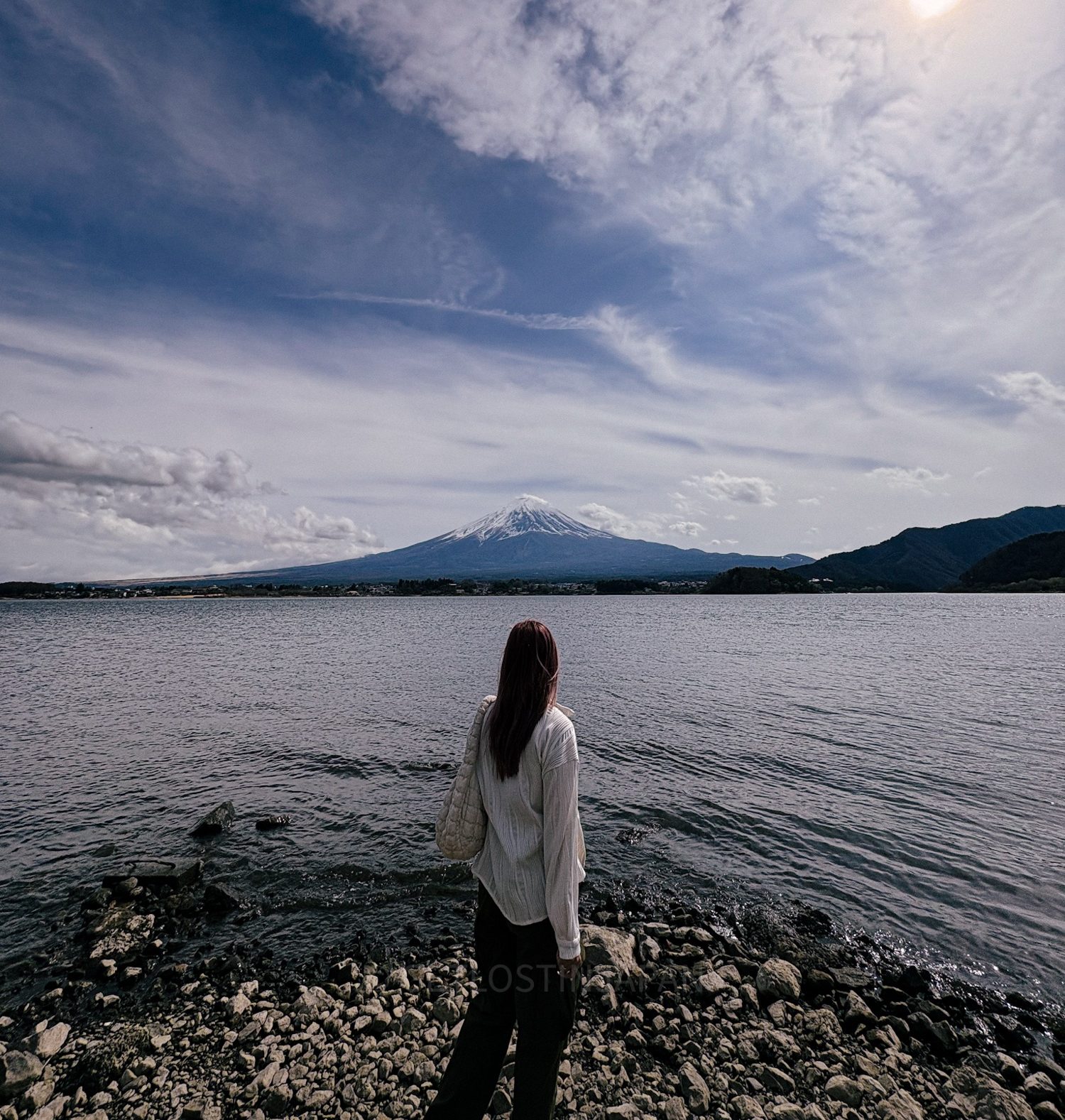
Don't miss out on my top choice!
My favorite part of the trip was seeing Mount Fuji and visiting Gotemba Outlets and Kawaguchiko.
This full day tour will take you to visit Mt Fuji and take care of all the logistics so you can relax and enjoy.

Japan Itinerary: 10 Days Overview
0️⃣ Arrive in Tokyo
1️⃣ Tokyo: Asakusa, Sensoji Temple, Ueno
2️⃣ Tokyo: Shibuya, Meiji Jingu, Harajuku, Shibuya Sky
3️⃣ Tokyo: Teamlab, Tsukiji Market, Ginza
4️⃣Tokyo: Shinjuku, Omoide Yokocho, Golden Gai
5️⃣ Travel Day: Head to Kyoto, Nijo Castle, Gion
6️⃣ Kyoto: Hozugawa Boat Ride, Tenryu-ji, Arashiyama Bamboo Forest
7️⃣ Kyoto: Fushimi Inari, Kiyomizu-dera
8️⃣Day trip to Nara or Uji
9️⃣ Travel Day: Osaka, Shinsaibashi, Dotonbori
🔟 Osaka: Osaka Castle, Umeda, Umeda Sky

Day 1: North Tokyo
For your first day, we’ll start out visiting the northern side of Tokyo, which is considered the “old” Tokyo. You’ll be visiting Asakusa, Ueno, and Akihabara.
Morning: Asakusa
Asakusa is a district in northern Tokyo, most well-known for being home to Sensoji temple, the largest and oldest Buddhist temple in Tokyo. However, temples aside, there's food, arcades, and shops to explore here as well.
Visit Sensoji Temple
When you first arrive in Asakusa, you’ll enter Nakamise-dori street in order to get to the temple entrance. Nakamise-dori street is a lively shopping street with numerous street food stalls and shops, so it’s easy to get distracted.
I recommend visiting the temple first before it gets too crowded, then turn back to the surrounding Nakamise-dori Street to do some browsing afterward.

You’ll know you’re heading towards the right place when you see Kaminarimon, or “Thundergate”. It’s a hallmark temple gate with an enormous, bright red lantern signifying you’re entering Sensoji Temple, and an extremely popular photo spot.
💡 Pro tip: Don’t forget to spot the statues of the god of Thunder and the god of Wind guarding the lantern on either side!
Spend around an hour wandering the temple's main hall and gardens, and get a view of the famous five-story pagoda. You can pray for good luck and health, financial success, and anything else you can think of. The temples also sell unique charms with various protections inside such as a healthy pregnancy or traffic safety.
Browse Nakamise-Dori Street
Spend the rest of the morning and early afternoon around Nakamise-Dori Street. This is the perfect area to grab lunch, sample snacks, and shop a little bit!
The first time I visited Japan, Nakamise Street was the first place I went to. It was my first exposure to Japan and it was exciting to stroll through the shops and eat street food.
I've now realized that this street is quite geared towards tourism and mostly sells souvenirs, but regardless, it's a fun place to walk around.
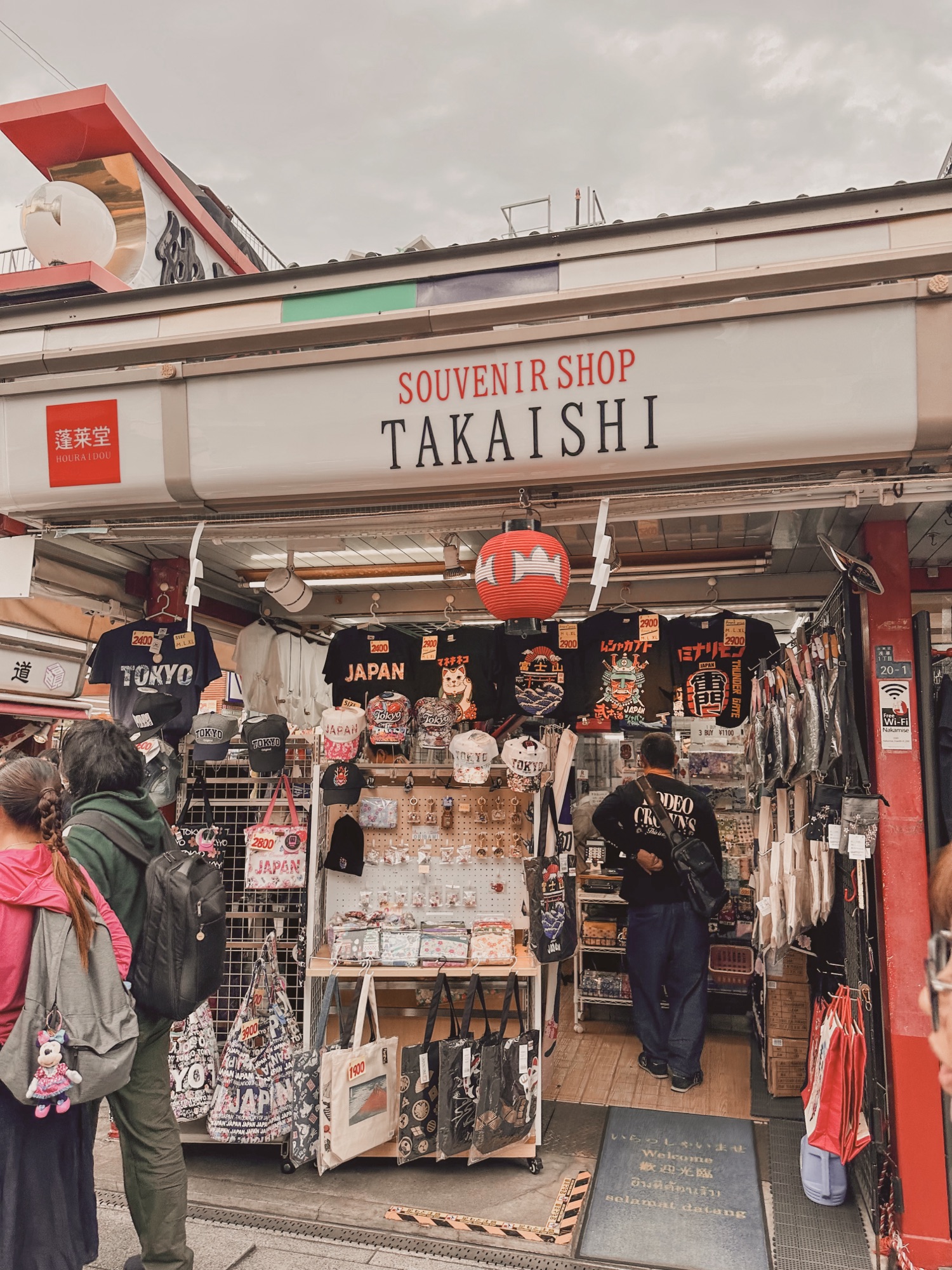
You'll also find great clothing stores, homeware shops, and arcades around the surrounding area. I especially liked Hikeshi Spirit, a shop that sells really unique anime clothing and souvenirs. My brother bought a nice Godzilla shirt here.
Lunch in Asakusa
After you've finished browsing, head over to Rokku Broadway for lunch, one street over from Nakamise. There are tons of great restaurants and cafes. Here’s some of my favorites.
- Kukurihime Coffee: a sit-down cafe with delicious dessert sets
- Torasuzu: delicious izakaya, skewers, and seafood. Perfect for lunch!
- Wagyu Ichinoya Asakusa: A steakhouse that sells amazing wagyu-don for an affordable price.
- Yoroiya Ramen: A Tasty ramen shop that also sells vegan options.
- Ginkado: A dessert stall that sells delicious daifuku mochi desserts! I picked one up on my way to Sensoji Temple, and it was ~delectable~
Afternoon: Ueno Park
Now that you’ve spent some time in Asakusa, Ueno isn’t too far away.
Ueno Park is home to a huge, relaxing park with trees and flowers all around. It looks amazing in March-April when thousands of cherry blossoms bloom, and in mid-July when lotuses bloom in the pond.
You can rent a boat on Shinobazu Pond, walk along the easy trails, or visit one of the many museums that are located inside the park, such as Tokyo National Museum, the Ueno Zoo, the Shitamachi Tanabata Museum, and the National Museum of Western Art, which is a UNESCO World Heritage Site.
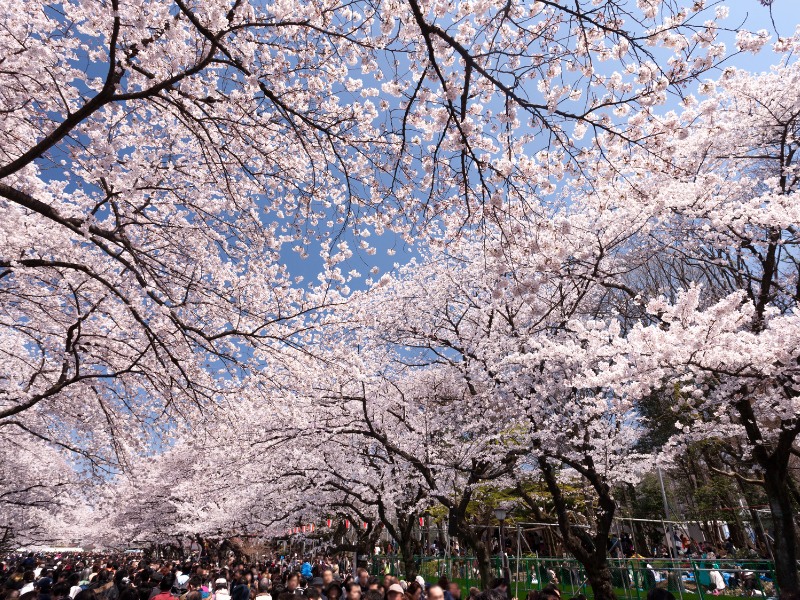
Optional: Tokyo National Museum
If you’re a museum fan, I recommend stopping by Tokyo National Museum, Japan's oldest museum. You’ll find amazing art and Asian antiquities found in Japan and Asia. There are over 120,000 pieces of artifacts and art featuring samurai armor, ancient pottery, and beautiful paintings!
💡 Pro Tip: The museum closes at 17:00, so aim to arrive around 14:00 to walk around for a few hours.
Ueno Ameyoko
Around this area is Ueno Ameyoko, conveniently located just a few minutes walk away from the park.
Ueno Ameyoko is a budget shopper's dream. You’ll find tons of discounted items here like pre-loved luxury items, souvenirs, snacks, cosmetics, and whatever else you can think of.
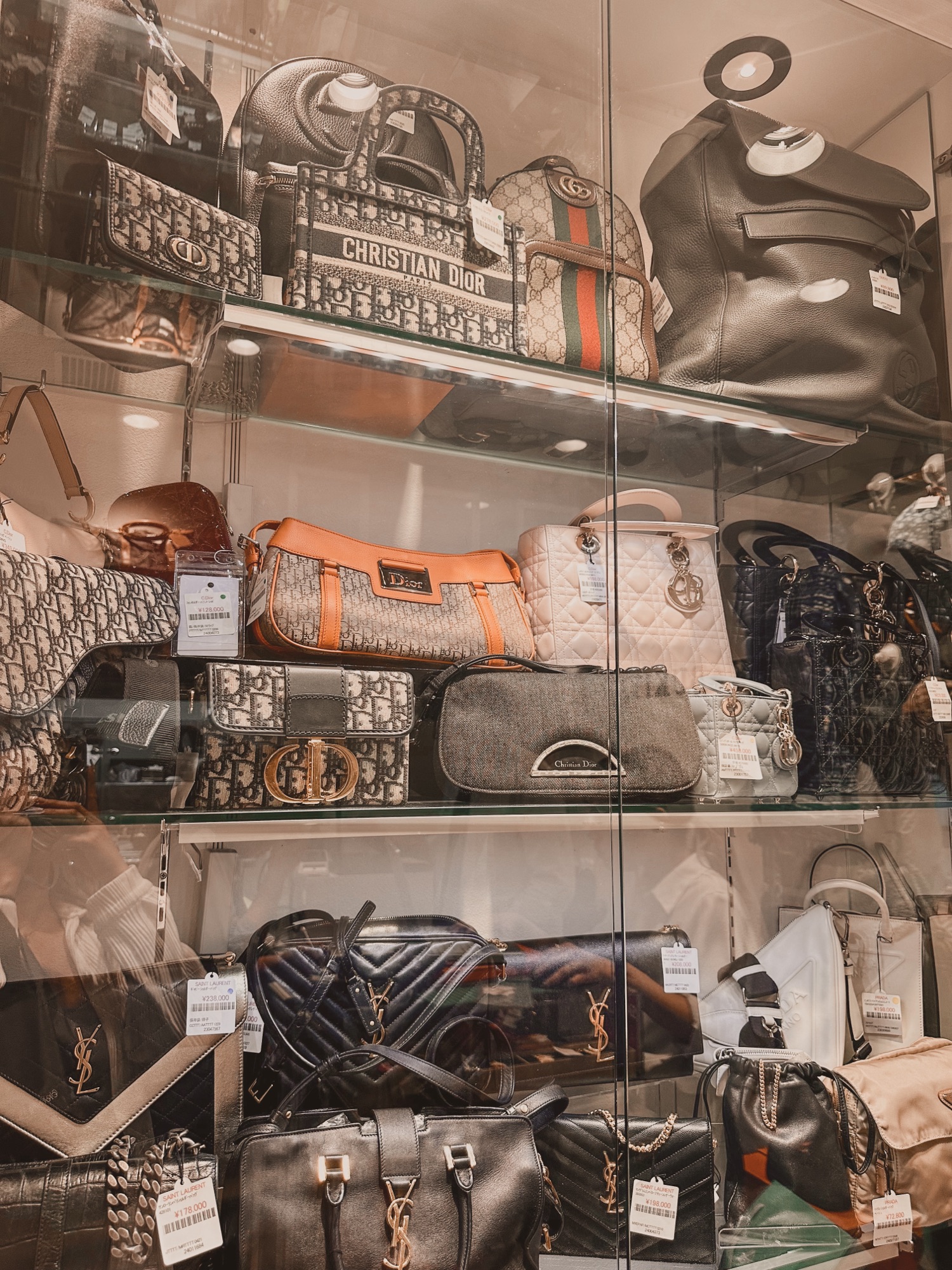
My favorite shops around here are Bookoff Plus and Mode Off. Both are casual thrift stores that sell clothes, manga, books, and shoes. I also liked Daikokuya, a pre-loved luxury goods shop.
If you’re curious about what else you can find in this district, there’s a local food and drink tour that takes you to hidden gems in Ueno.
Dinner: Unagi don at Izuei Main Branch
For dinner in the Ueno area, I recommend Izuei if you’re an unagi fan. The restaurant serves delicious unagi shirayaki-style to bring out the genuine flavors, and has a stunning view of Ueno Park.
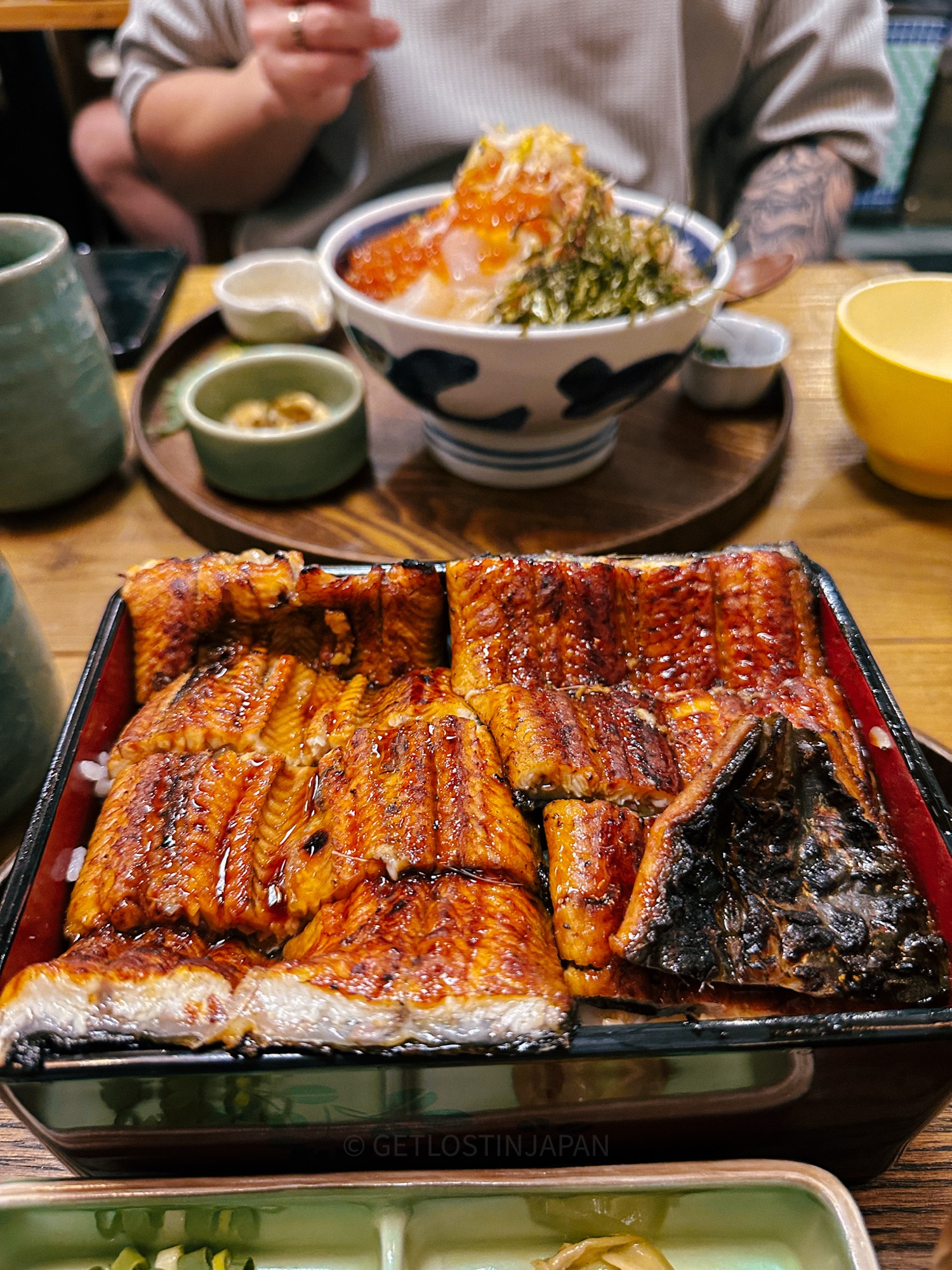
I love unagi, and it’s so much more affordable in Japan, and tastes way better than in the States. The unagi don is served in a fancy lacquer box, with soup and pickled vegetables as the usual sides. I recommend getting the eel with the tempura on the side, another one of my favorite Japanese foods!
Evening: Akihabara
Just a short 12-minute train ride from Ueno is Akihabara, the city’s go-to spot for anime-centric items and tech.
Now, here’s my confession. I thought Akihabara was very underwhelming the first two times I visited, but I wasn’t looking in the right places.
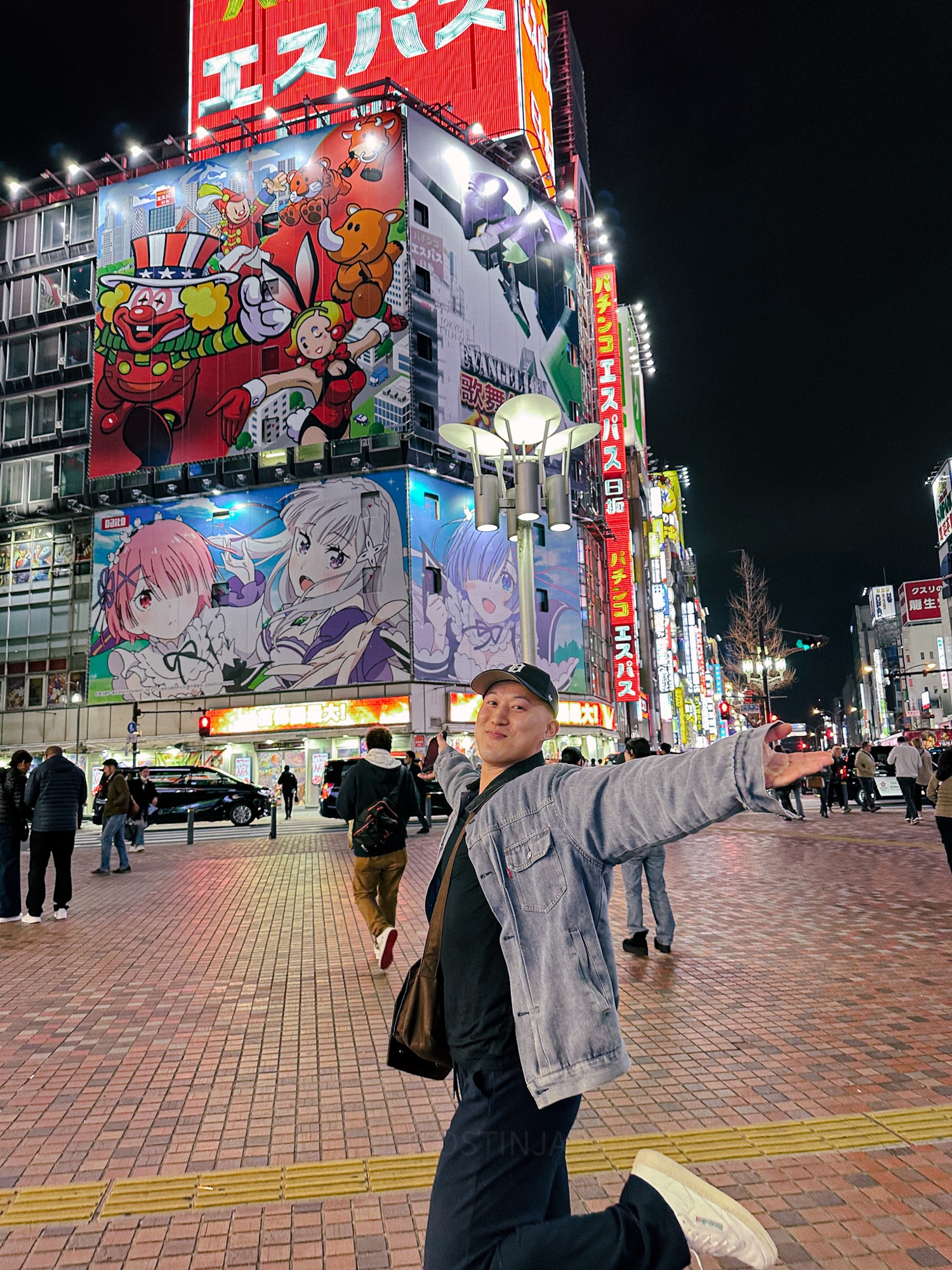
I recently stayed in Akihabara during one of my Tokyo trips, and I have now revised my pessimistic attitude. It’s actually pretty cool here, and worth checking out if you read manga/watch anime/like tech stuff.
Radio Kaikan Station is an otaku’s wonderland, with endless floors of anime stuff. We got a bunch of POPMART blind boxes here for $11 (1,650 yen) each, a pretty good discount compared to $15-20 in the USA. You’ll also find a ton of slutty anime girls on display with a good number of boys eyeing them with no shame. My boyfriend and I followed suit and also oogled the anime girls for a little while, too, because why not?
The store was pretty hard to navigate because there were endless rows of anime merch with no distinguishable signs, and the store was PACKED all day. Still worth checking out, though.
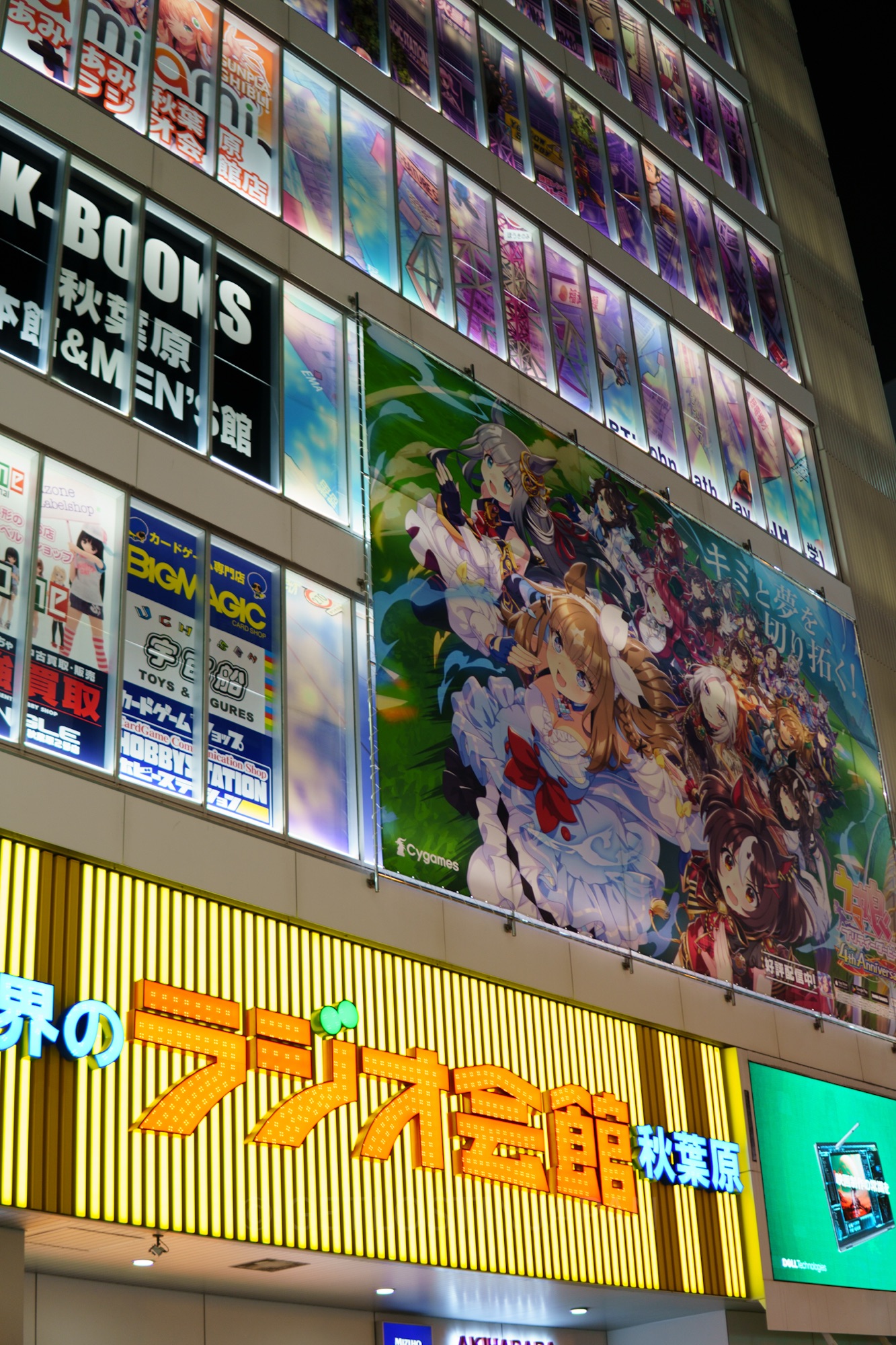
We also went to Yodobashi Akiba, a huge electronics store with I think 6-7 levels of tech. I wandered in looking for camera accessories and left with beauty products and hair rollers, completely unrelated items, yet somehow, just as necessary in their own way. What I mean to say is, they have everything there!

Where To Stay In Tokyo
Now, Tokyo is a massive city, so it can be pretty hard trying to figure out which area you want to stay in. I have an entire post dedicated to choosing the best area to stay based on your preferences, which you can check out.
Most people prefer staying in Shinjuku for a good mix of everything, and convenient transportation around the rest of Japan. It’s a bustling area with Shinjuku Gyoen Garden, Omoide Yokocho, and Golden Gai.

My personal favorite area is Shibuya, because I like to be where the action is, and I love the shops there. Shibuya has tons of thrift and vintage stores, lots of fun bars and clubs, as well as top attractions like Shibuya Sky and Meiji Jingu.
I’ve also stayed in Ginza, which is great for luxury shopping, luxury vintage, and the Tsukiji Fish Market.
Asakusa is another great place to stay, but it’s not very close to the other areas, so it would fit those who prefer a quieter place to stay or have kids, so you’re close by to Ueno Park.
Tokyu Stay Shibuya
I’m a huge fan of Tokyu Stay, having stayed in their Tsukiji location before. I love this hotel due to the in-room washer/dryer, which is a total lifesaver, so you don’t have to share with the rest of the hotel guests or go back and forth outside to wash your clothes. Trust me, I’ve had to do laundry in the rain back when I stayed in a hostel in Hakone, and it was the worst.
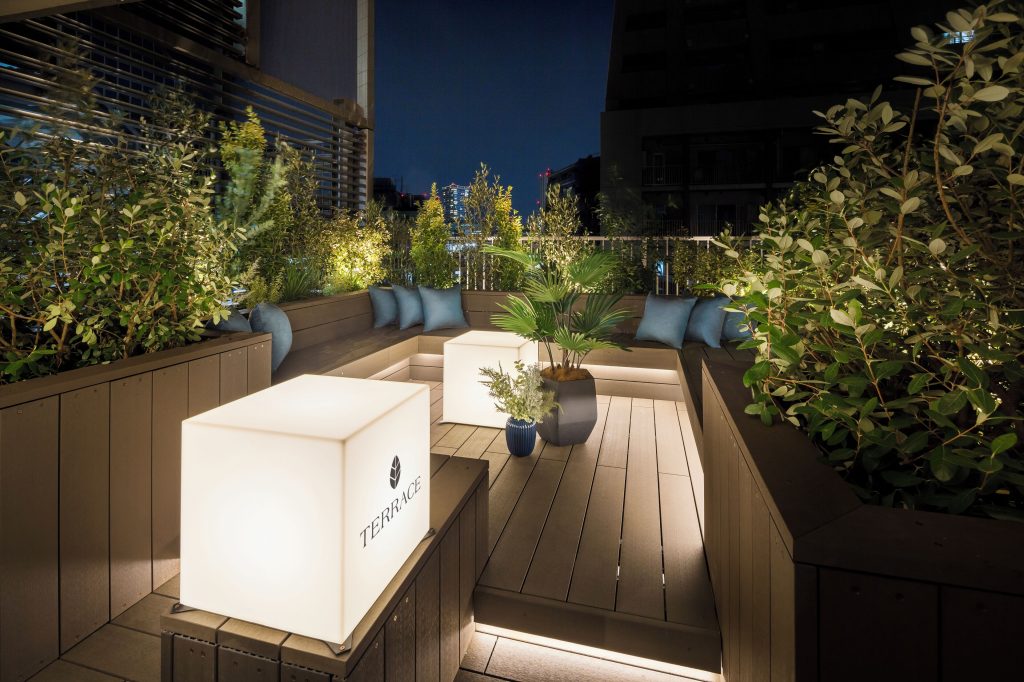
There are a ton of other thoughtful amenities, like the rooftop lounge with views of Tokyo Skytree, and the humidifier and microwave in the room. They also offer dry cleaning, photocopying, and even courier services if you need them.
The rooms come in all types, perfect for any kind of traveler. The location is super convenient too, being just a 3-minute walk to Shinsen Station and about 10 minutes to the nearest JR line. You’re also only 10 minutes by train to Harajuku and Shinjuku, and 15 to Yoyogi Park and Meiji Shrine, so you’re already close to half of Tokyo’s main sights!

Day 2: Tokyo (Shibuya)
Today we’re going to explore my favorite area, Shibuya! You get a nice mix of relaxing nature, culture, and shopping here. We’ll visit a scenic shrine, go thrifting, and end the day with a sunset view at Shibuya Sky. I'll also include some great nightlife spots, you know, if you’re interested…
Morning: Meiji Jingu Shrine
Meiji Jingu is a popular Shinto shrine that almost feels hidden away from the craziness of Tokyo. It’s a large shrine dedicated to the late Emperor Meiji and his wife, Empress Shoken. It’s surrounded by a dense forest, right behind Harajuku Station and opposite of Harajuku.
I absolutely loved Meiji Jingu, even more than Sensoji Temple. The forest is large and takes about 10-15 minutes to walk to the shrine, so it felt less crowded due to its sheer size. It’s a very scenic walk getting to the shrine. Also, I bet you didn’t know that the forest is actually man-made! It was planted with donations from regions all over the country during the shrine’s construction in 1920!

The shrine and the torii gates are a natural wooden color, and bring a calming, peaceful energy surrounded by all the trees. Take a peek at the sake and wine barrels at the side of the entrance that were given as offerings to the temple.
Meiji Jingu Museum
Also nearby is the Meiji Jingu Museum, where you can see personal items from the emperor and empress. There’s also the inner garden, which is especially popular in mid-June when the irises are in full bloom. The garden is 500 yen to enter. Yoyogi Park is also nearby, but I think you’ll get enough exercise from walking to the shrine.
💡 Pro tip: To pray during your temple visit, first throw a coin offering into the offering box, then bow deeply twice. Clap twice, and after the second clap, put your hands in prayer and make your prayer.
⛩️ Best Meiji Temple Tours ⛩️
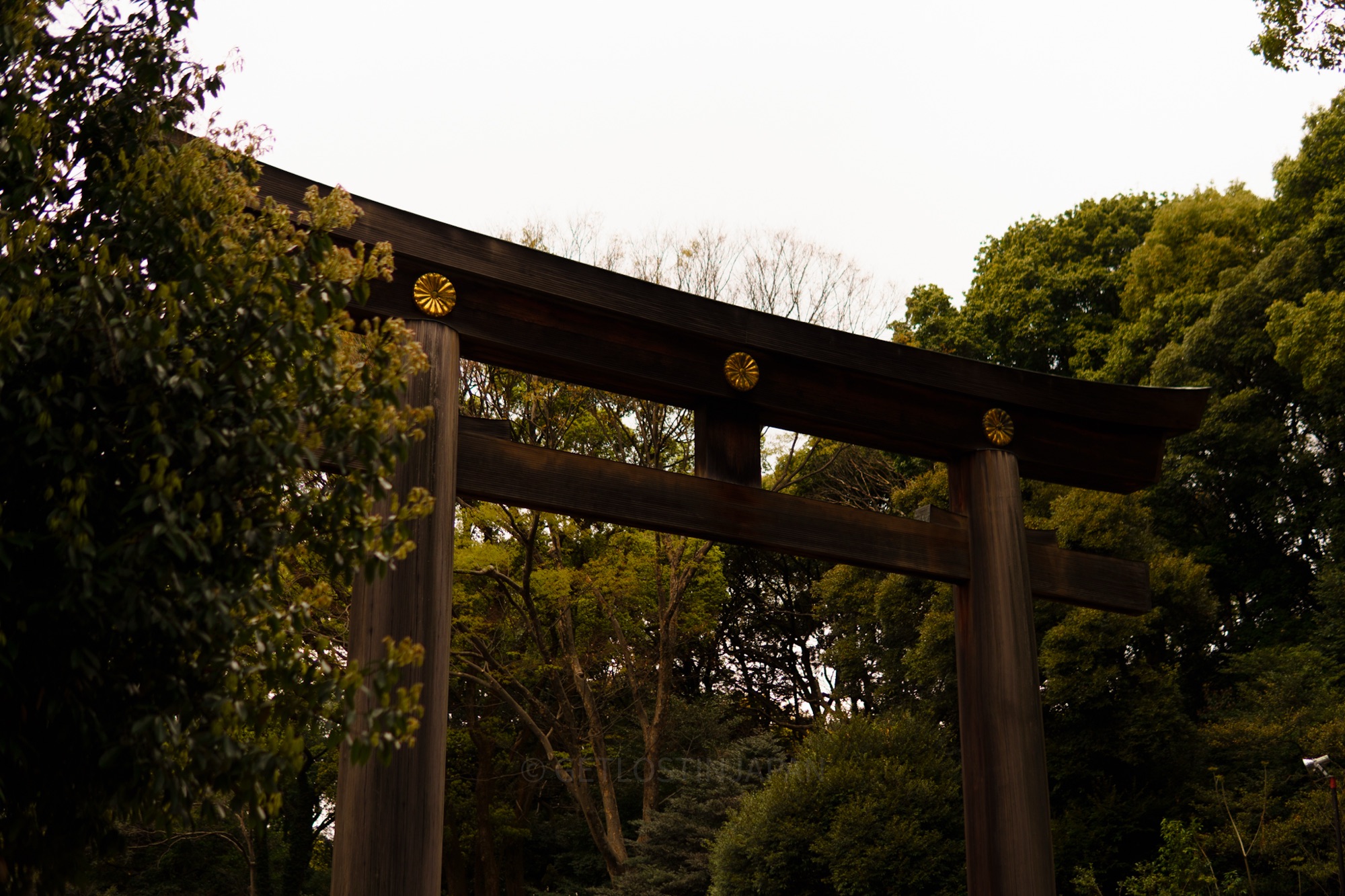
Tokyo Highlights Private Day Tour
This personalized tour takes you to some of Tokyo’s most iconic spots, including Sensoji Temple and Nakamise in Asakusa, and Meiji Shrine and Omotesando. It's an all-day adventure designed to cover the best of Tokyo!
Tokyo Amazing Sightseeing Bus Day Tour
Ideal for families or those who prefer a relaxed pace, this bus tour covers Tokyo’s top attractions so you can skip walking 20,000 steps. You’ll visit the Meiji Shrine, Sensoji Temple, and the Imperial Palace, with skip-the-line access to the Tokyo Skytree.
Lunch: Udon in Harajuku
After Meiji Jingu, start walking back to Harajuku and Takeshita Street. I recommend eating lunch in the area so you can shop for as long as you want afterward.
You could check out Menchirashi, an udon restaurant that serves carbonara udon with mentaiko, or grab some ramen at Oreryu Gyoza Meshi Harajuku (hint: get the gyoza!).
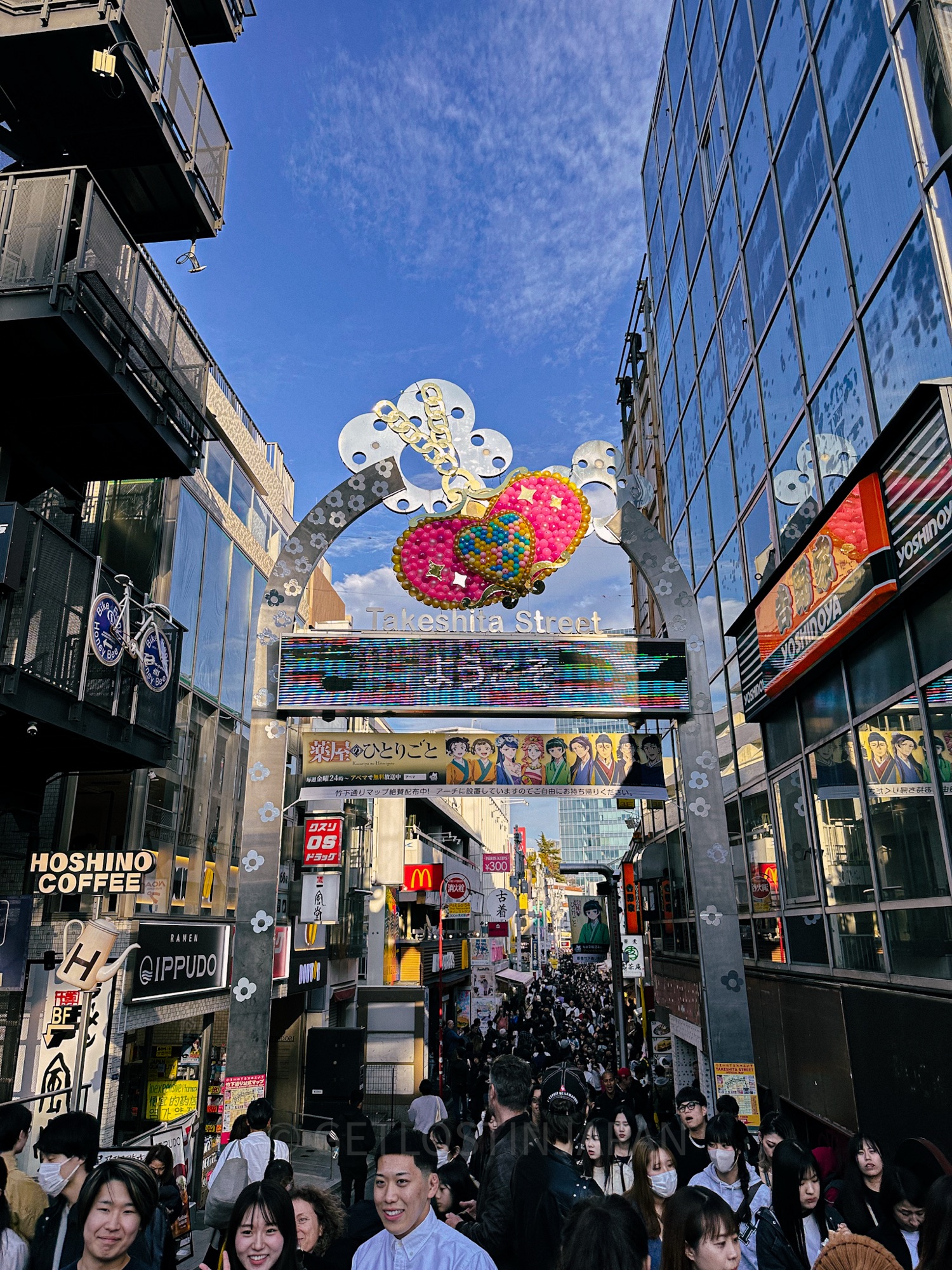
Afternoon: Shop till You Drop in Harajuku
Ahhhh, Harajuku. I could spend hours here. Actually, I have. Multiple times, in fact. I just really like shopping here! Harajuku is geared more towards the younger crowd and has tons of streetwear stores, vintage shops, and all sorts of unique, trendy places.
Also located next to Harajuku is Omotesando, another shopping district that is considered more luxurious and high-end, similarly to Ginza. So you have two great shopping areas within walking distance.
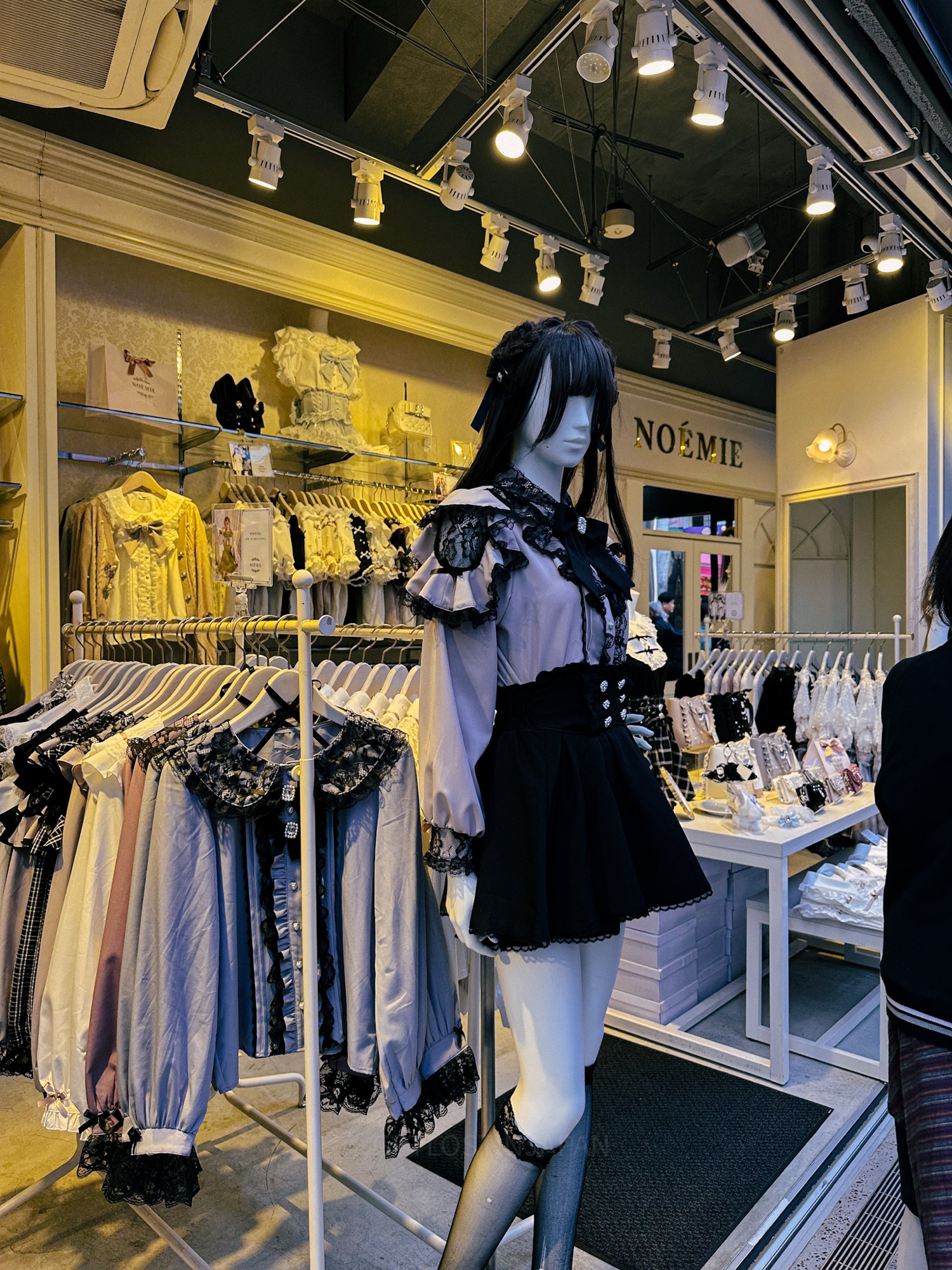
I do the majority of my clothes shopping whenever I go to Japan, and always come back with special styles that America doesn’t really make (or charges a premium price for)!
My favorite stores in Harajuku and Omotesando:
- WEGO: A youth clothing store that has trendy pieces (think Y2K) for an affordable price.
- Cosme: The Japanese equivalent of Sephora with tons of cosmetics, hair products, and skincare. My favorite part is the walls promoting the most popular products in the country.
- X-Girl: A women's clothing shop that is a little pricey, but high quality. It's definitely popular as I saw a bartender in Harlem wearing their shirt! I bought some really soft pants here for $70.
- Kindal: A pre-loved luxury store that also sells a lot of thrifted clothing. I bought my pre-loved Celine bag here for less than $700!
- 2nd street: Pre-loved luxury and casual thrift store.
- Charles & Keith: Really nice shoes and bags for an affordable price. I bought some black wedges and white athleisure heels here.
- Laforet: A huge shopping mall that has really unique stores with alternative fashion and unusual boutique stores (think "kawaii" and streetwear).
- The Shel'tter Tokyu Plaza: A really big department store that has very trendy Japanese brands loved by locals such as Moussy and Sly!
- Tokyu Plaza Harajuku: The interesting silver architecture of this building and the beautiful garden on the top floor will catch your eye. I didn't get a chance to go in, but I hear the food court is great.
Evening: Shibuya Sky
After you burn some money in Harajuku, head over to Shibuya to see the famous Shibuya Scramble Crossing. It's one of the must-do things when you visit Tokyo!
But before you leave Shibuya Station, make sure to visit the Hachiko dog statue before heading out to the crossing!
When you’re ready to leave the station, you’ll spot the iconic crossing almost immediately. This 5-way intersection crossing is famous for how busy and chaotic it becomes when it’s time to cross.
While it’s quite fun (and very overwhelming) being one with the people as you cross the intersection, it’s better to get to a higher viewpoint to see the scramble from a bird’s eye view.

There are a couple of places where you can get a good view, and almost all of them require some sort of payment. Even the Starbucks in Shibuya Tsutaya requires a purchase to be able to get to the viewing side. For the best view of the scramble and the cityscape, I recommend going to Shibuya Sky.
Shibuya Sky
Shibuya Sky offers one of the best views of Tokyo and the Shibuya Scramble Crossing, and is often booked out.
I plan to make a separate post on how to purchase Shibuya Sky tickets in the future, because it can be pretty difficult to nab tickets for golden hour, but it is doable! I was able to get 8 tickets for sunset, but I had to check for tickets every day over the course of 5 days.

You can either purchase on the original site or Klook, and tickets come out 2 weeks before the date you want to go at 10:00 Japan time (18:00 the day before if you’re PST). I recommend buying on the site because tickets come out there first.
You’ll buy a timeslot that specifies when you can enter, but once you’re inside, there’s no time limit. Tickets are 2,700 yen before 15:00, and 3,400 yen after 15:00.
There are two widely Instagram-famous photo spots, the glass escalator to the rooftop and the Sky Edge, which is a glass corner with a beautiful view. Expect to spend 1-1.5 hours there.
💡 Pro tips:
- No hats or sunglasses are allowed at the top.
- Tickets sell out extremely quickly, so I recommend setting a reminder and booking it as soon as it comes out 2 weeks prior.
- The best time to go to Shibuya Sky is at 17:00 (if sunset is at 18:00) to enjoy golden hour. This amount of time leaves room for waiting in line.
Dinner: Conveyor Belt Sushi at Uobei Shibuya Dogenzaka
You should try conveyor belt sushi at least once during your trip, especially if you don’t have it in your hometown! The quality isn’t as high as a traditional sushi restaurant, but it’s a super fun experience watching your sushi zoom over and picking it up from the conveyor belt.
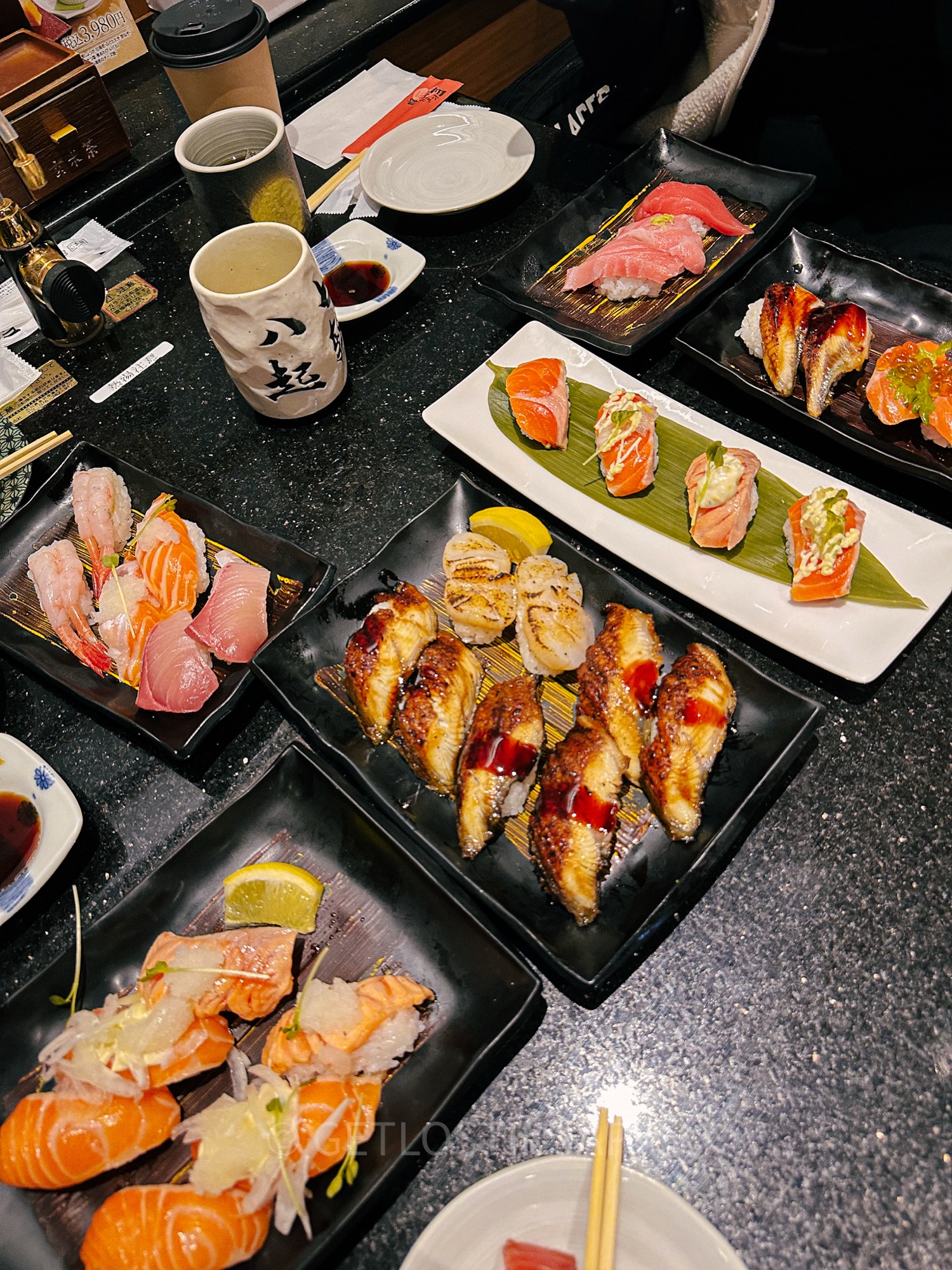
I recommend Uobei Shibuya Dogenzaka, it’s a large conveyor belt restaurant that serves good quality sushi at a great price. There is typically a wait but you’ll get seated pretty quickly, and it’s an 8 minute walk from Shibuya Sky.
Optional: Clubbing in Shibuya
If you want to go clubbing in Tokyo, I highly recommend clubbing in Shibuya. I’ve been to Atom and Harlem, two very popular clubs that are side by side with each other. I’ve also heard good things about Womb, too.
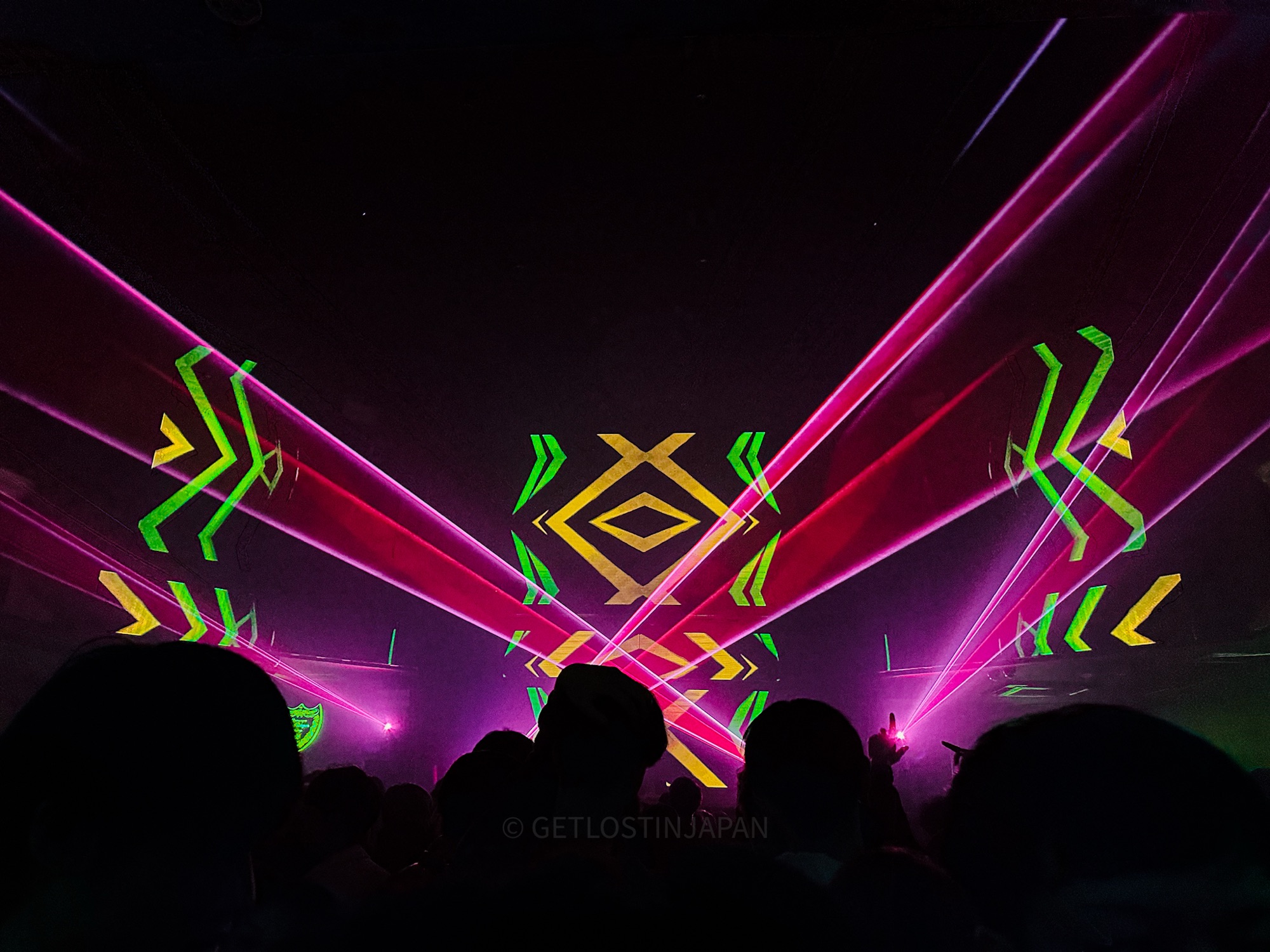
Atom plays EDM music while Harlem plays rap and hip hop. Both are equally crowded, so you can decide which one you want to visit when you get there. I think I preferred the music in Harlem a bit better because it felt more current (or maybe I just like how Harlem played a lot of 21 Savage). It depends on the DJ that is playing that night, too.
The drinks are pretty affordable (around $7-8), and shots are quite cheap as well.
💡 Pro tip: Bring 400 yen in 100 yen coins if you plan on storing your jackets or bags in a locker!

Day 3: Central Tokyo
For day 3 of your journey, we’ll explore central Tokyo. This includes Teamlab (either Borderless or Planets), some eats at Tsukiji Market, walking the Imperial Palace Gardens, and strolling around Ginza.
Morning: TeamLab
You can choose to visit either Teamlab Borderless or Teamlab Planets to start off your day. They’re both equally a bit far from the main areas of Tokyo, so distance-wise it doesn’t really matter. TeamLab Borderless is located in Roppongi, while Planets is located in Toyosu.
Both are amazing, and it comes down to a matter of personal preference. You can check out a comparison between the two here.
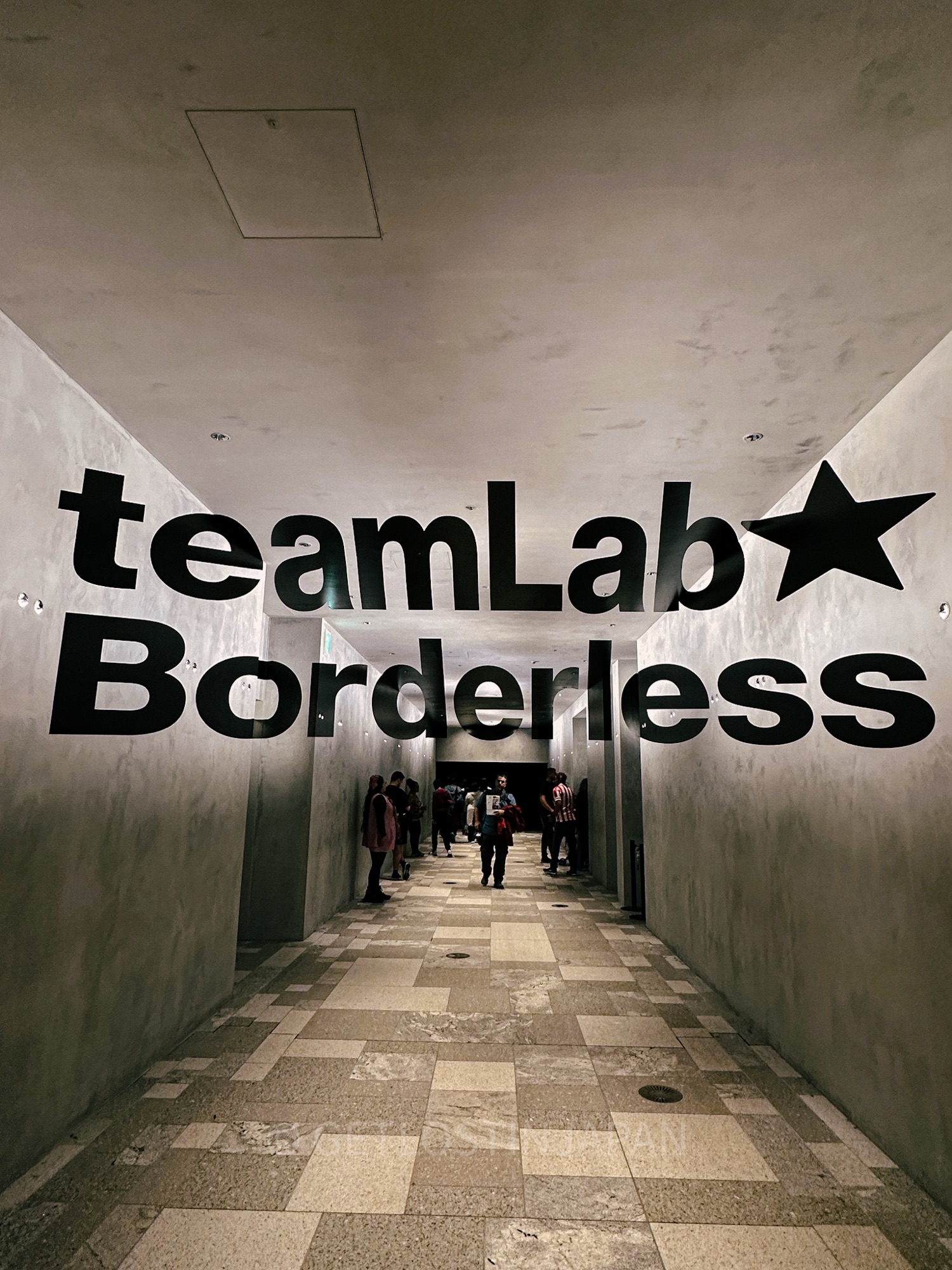
Personally, I prefer Planets because I found it to be more fun and interactive versus Borderless, which is more visual. That being said, Borderless is more accessible while Planets does require you to walk through water and has some uneven grounds at times, requiring you to dress comfortably.
Expect to spend around 2 hours at either exhibit to fully explore the museum (and take some amazing photos, of course)!
Lunch: Street food at Tsukiji Market
For lunch, you’ll head over to Tsukiji Market, the famous fish market where you’ll find delicious sashimi, savory wagyu skewers, and many more street snacks as you wander the quaint stalls.
I love Tsukiji Market for its bustling energy, though it can get very crowded, and realistically, you could probably find cheaper food elsewhere. It is a tourist attraction after all, but I think it’s still worth a visit. It’s fun to wander between the food stalls and try a variety of different foods, and there are sit-down restaurants as well.
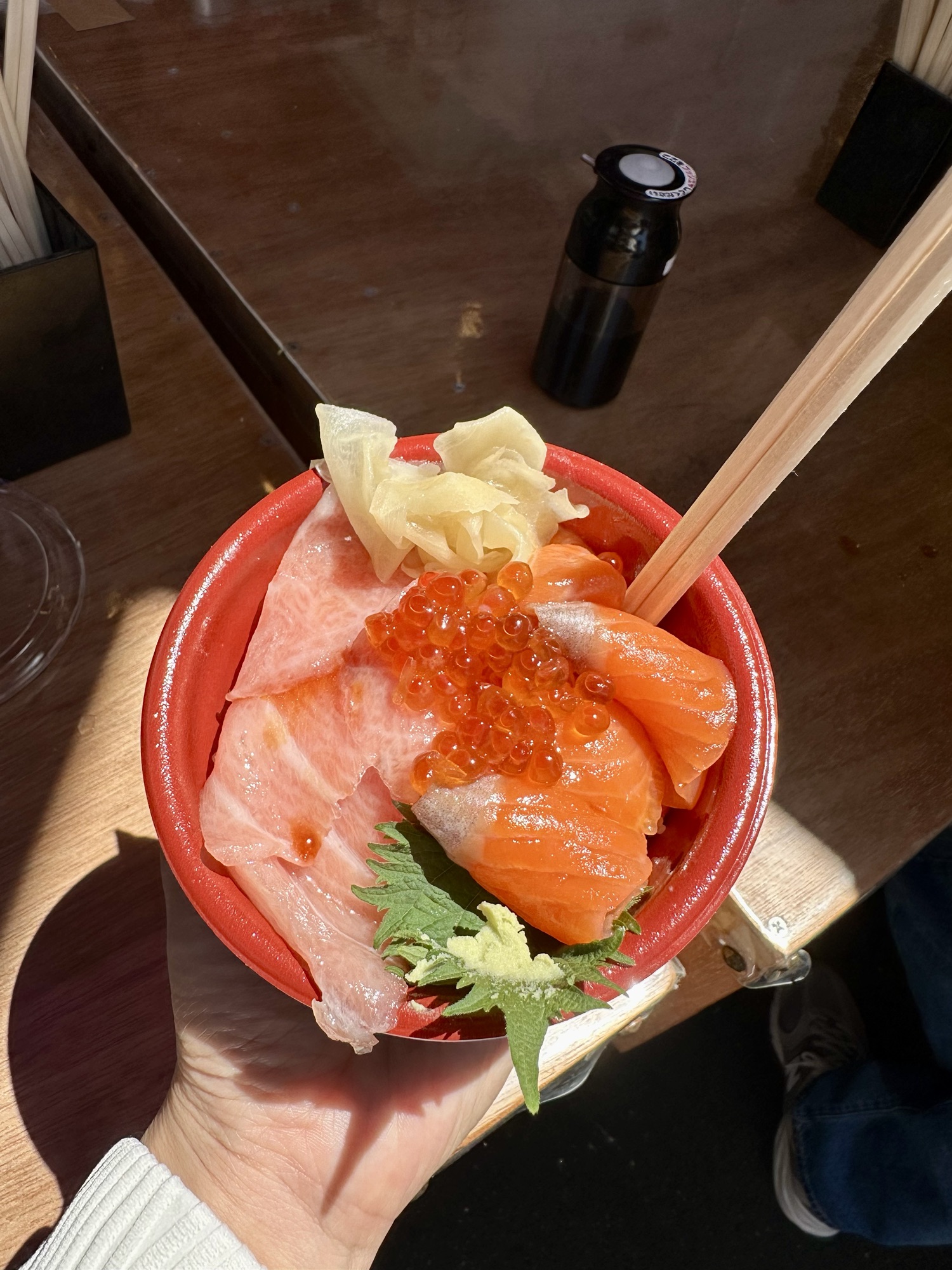
The best times to visit Tsukiji are early morning for breakfast around 8:00 and 11:00 for lunch, but it's always busy regardless. The shops start opening as early as 05:00 and will operate until around 14:00, though regular restaurants may stay open later.
If you’re a foodie, you could even stay around Tsukiji Market to visit as many of the 400 shops as you can!
💡 Pro tip: Keep in mind that many stores are closed on Wednesdays and Sundays or will operate with shorter hours.
Afternoon: Imperial Palace Gardens
If you have the time and energy, you may want to visit the Imperial Palace Gardens on this day. The Imperial family currently live in the palace, so while the palace itself is off limits, visitors are welcome to explore the impeccably maintained palace gardens.
To get into the inner palace, there are 70-minute guided tours that will take you into the inner palace gardens. Tours run twice daily at 10:00 and 13:30 in English and Japanese, and are free. You may have to switch your day around to make the timeslot.
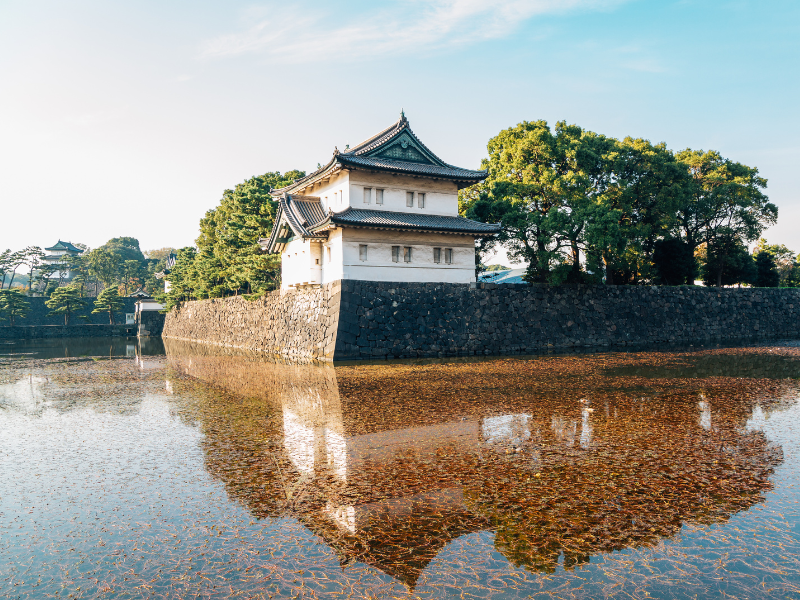
If you can't get a tour of the inner palace gardens, you can still tour the East Gardens with a guide. You’ll cross the Nijubashi Bridge, the most famous bridge of Japan, take in the serene lotus moat, and possibly catch a glimpse of Mount Fuji if it’s a clear day.
💡 Pro tip: If you’re hoping to tour the inner gardens, try to plan your visit for a Tuesday, Wednesday, Thursday, or Saturday. The East Gardens are closed on Mondays and Fridays, and inner garden tours aren’t held on Mondays or Sundays.
Evening: Shop in Ginza
Spend the rest of the day exploring Ginza, Tokyo’s luxury shopping ward. For all my fellow luxury lovers, this is the perfect place to buy new and preloved luxury!
They also have tons of other shops, like the Uniqlo and Muji Flagship stores. I found that the prices were 20-30% cheaper than the same items being sold in stores in America, so I highly recommend checking them out.
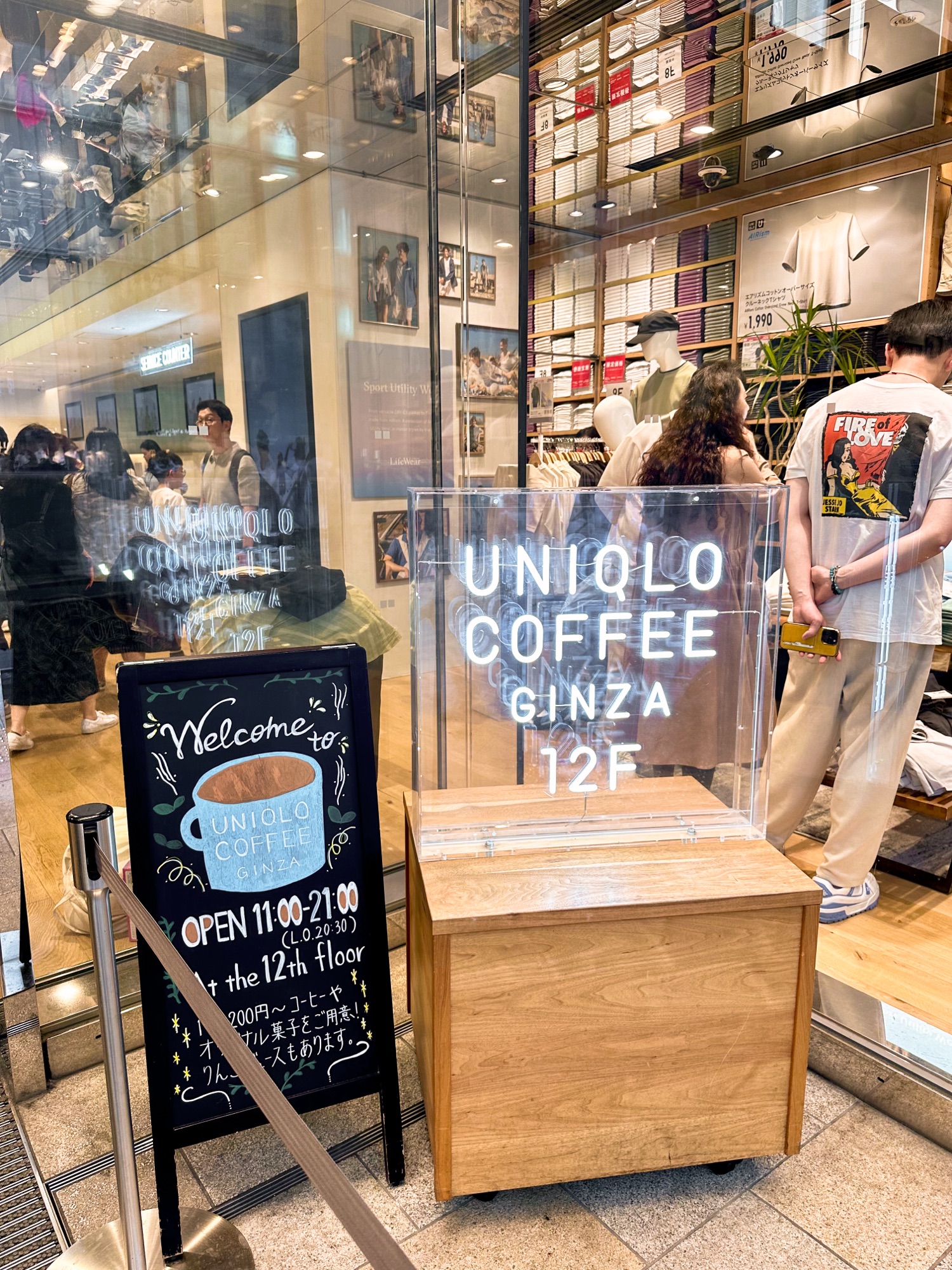
Art Aquarium Museum is also located here, a unique attraction that blends art with aquatics to create a visually stunning world featuring vibrant and colorful fish displays. They’re open until 19:00, so you could potentially squeeze in an evening visit.
My favorite shops in Ginza
- Allu: Pre-loved luxury. I bought a Preloved Van Cleef necklace here!
- Brand Off: Pre-loved luxury. I purchased matching Cartier rings here for around $670 each (retail is $2,000).
- Uniqlo Flagship Store: With 12 levels of great quality clothing, you will spend a good amount of time here.
- Muji: Flagship store selling stationery, home decor, and apparel.
- Dover Street Market Ginza: if you like brand names, Dover Street has a ton of shops and high-end brands.
- Chrome Hearts: An upscale streetwear brand that's very popular right now.
Dinner: All-You-Can-Eat Buffet at Ginza Happo
For dinner, I highly recommend visiting Ginza Happo. It’s a huge buffet that serves high quality seafood and barbecue meat. You’ll find endless crab legs (even red king crab), oysters, tons of meat, even delicacies like duck bao buns and (eep) shark fin soup.
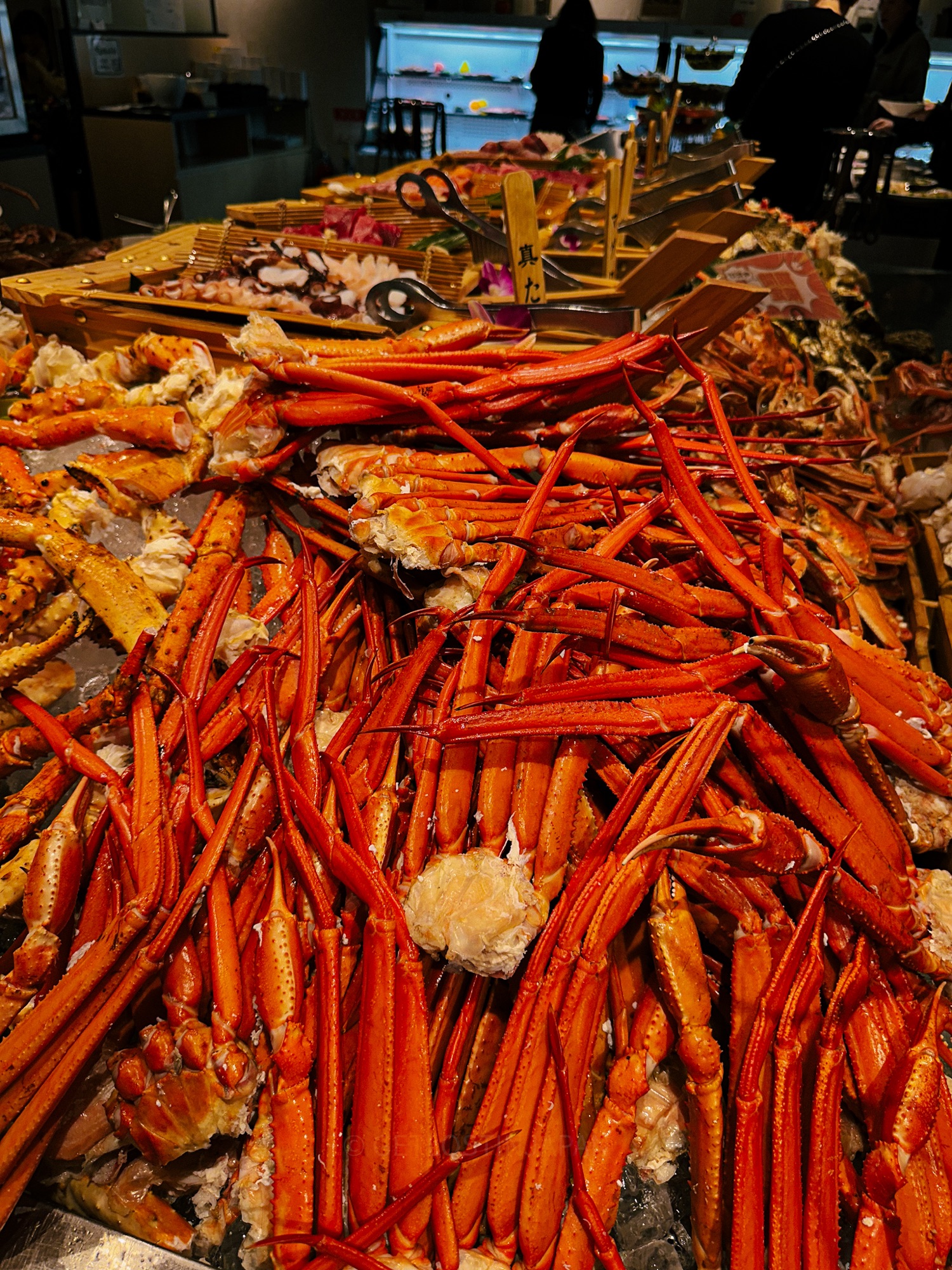
If you’re a foodie and enjoy buffets, definitely include this in your trip! There are over 150 dishes served, and dinner costs approximately $83 per person. Everything is super delicious and high quality. My personal favorites were the barbecue meats (I think the ribeye), the tuna belly, and the desserts. The crab legs were incredible, but honestly, I got a little lazy cracking them after a while.
We made a reservation around 2-3 weeks in advance, which I recommend doing. After that, the night is yours! Just make sure to take advantage of the endless free alcohol, beer, and soju that they have on tap if you plan on going out after.

Day 4: Tokyo (Shinjuku)
For your last day in Tokyo, you’ll be visiting Shinjuku, the northwest area of Tokyo. I’ll be showing you around Shinjuku Gyoen National Garden, Tokyo Metro Building, Omoide Yokocho, and Golden Gai. This day isn’t too packed, so feel free to also use the first half of the morning to revisit any areas you wanted to come back to, if any.
Morning: Shinjuku Gyoen National Garden
Start the day off by visiting Shinjuku Gyoen, one of Tokyo’s most popular parks. It’s also one of the best places to see cherry blossoms in bloom from late March to early April.
Shinjuku Gyoen has three different gardens to explore. There’s a traditional Japanese landscape garden with bridges and seasonal flower displays, a French garden, and an English-style lawn area. There's also a lush greenhouse filled with tropical plants.

I definitely recommend coming in late March-April for hanami season, or in mid-November when the autumn leaves start changing colors.
Afternoon: Explore Shinjuku
Spend the day walking around Shinjuku, Tokyo’s busiest neighborhood. During the day, it’s a business district, and then transforms into a wild entertainment area once the sun sets. Here are a couple of spots you can check out in Shinjuku.
Tokyo Metropolitan Government Building
The Tokyo Metro Building is another great viewing spot in the city, and best of all is that it’s free! The building consists of two towers, and there is an observatory in both, standing at 202 meters tall.
Here, you'll be able to spot Tokyo Skytree, Tokyo Tower, Meiji Shrine, Tokyo Dome, and potentially even Mount Fuji.
If you have already gone to Shibuya Sky or any of the other popular viewing points in Tokyo, like Tokyo Skytree, Tokyo Tower, or the Roppongi Hills Observatory, then feel free to skip this attraction.
Samurai Restaurant Time
Back in 2019, I visited the super popular Robot Restaurant, which is now permanently closed (Nooo)! It’s now been revamped and reopened as Samurai Restaurant Time, still incorporating vibrant, colorful theatrics to bring you a show with your meal, but now with samurai!

It’s super popular with kids and is fun if you want to watch a show with lunch. If you book tickets online, you get two free drinks. The food here is pretty good too, with plenty of choices such as udon or ramen.
Make sure you’re prepared for some crazy, colorful visuals and action-packed sword fights!
Ninja Trick House
A short distance from the Samurai Restaurant is also the Ninja Trick House, where you can practice throwing ninja stars, master the sword, and learn undercover espionage tactics that rival what you would learn in Hidden Leaf Village.
Shopping in Shinjuku
There are a ton of great stores in Shinjuku, like Chrome Hearts, Kinokuniya, and Yodobashi Camera. You’ll also find pre-loved luxury stores like Rinkan Shinjukuten and Okura here.
💡 Pro tip: As you walk around Shinjuku, make sure to keep an eye out for the famous Godzilla Head above Hotel Gracery Shinjuku! He breathes fire every hour (or at least, he’s supposed to. Maybe he was a little cold when I saw him).
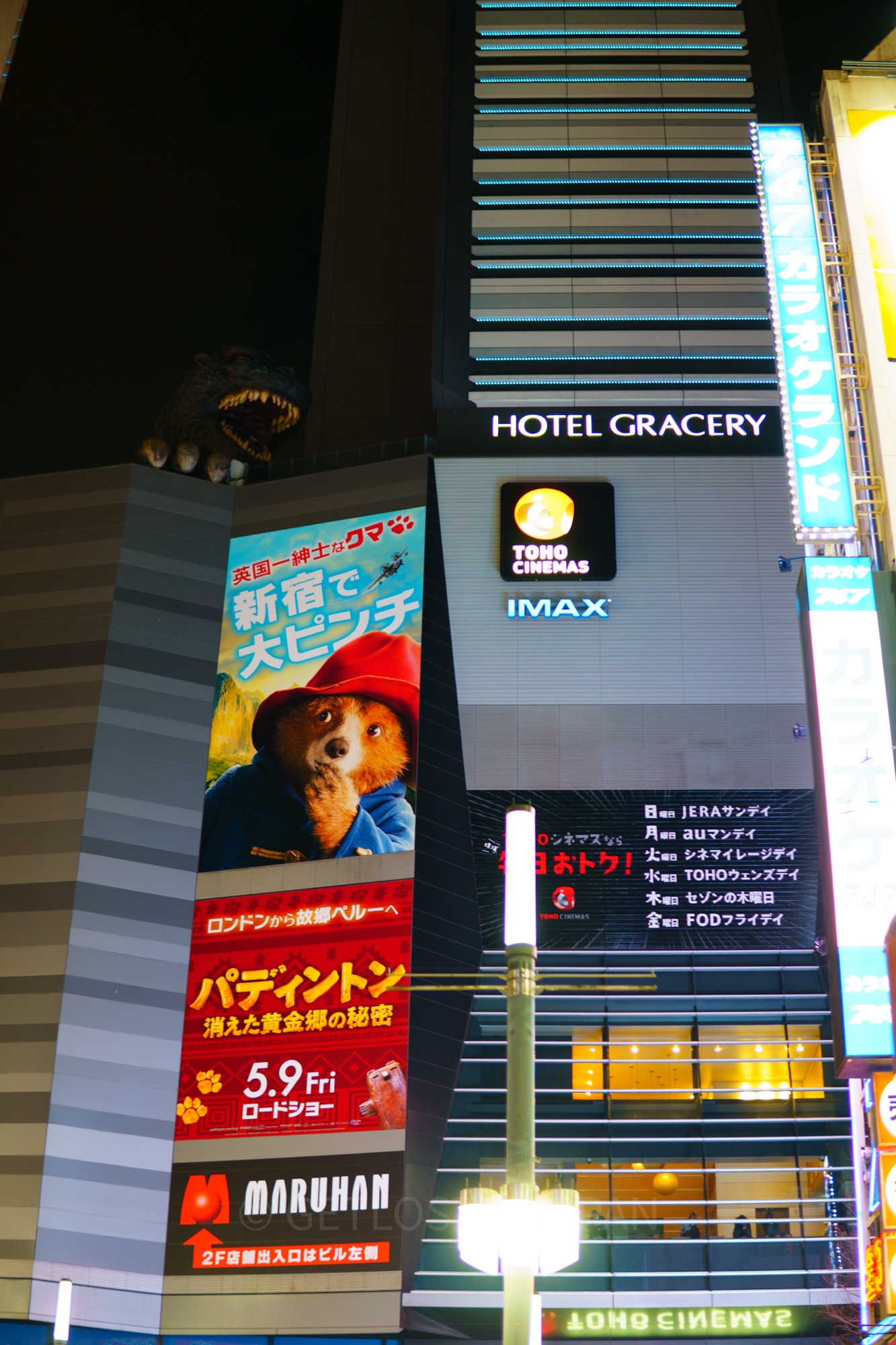
Dinner: Omakase at Sushi Tokyo Ten
For a great value omakase for only $60, stop by Sushi Tokyo Ten. If you haven’t experienced eating at an omakase yet, it is the Japanese tradition of letting a chef choose what you eat. Omakase means “I will leave it to you”! It’s a unique take on fine dining that grants creative freedom, a memorable experience, and a delicious meal..
I guarantee that after you experience an omakase, you’ll never look at sushi the same way again. The chef knows the perfect amount of soy sauce and wasabi to bring out the best flavors of the fish that is served.
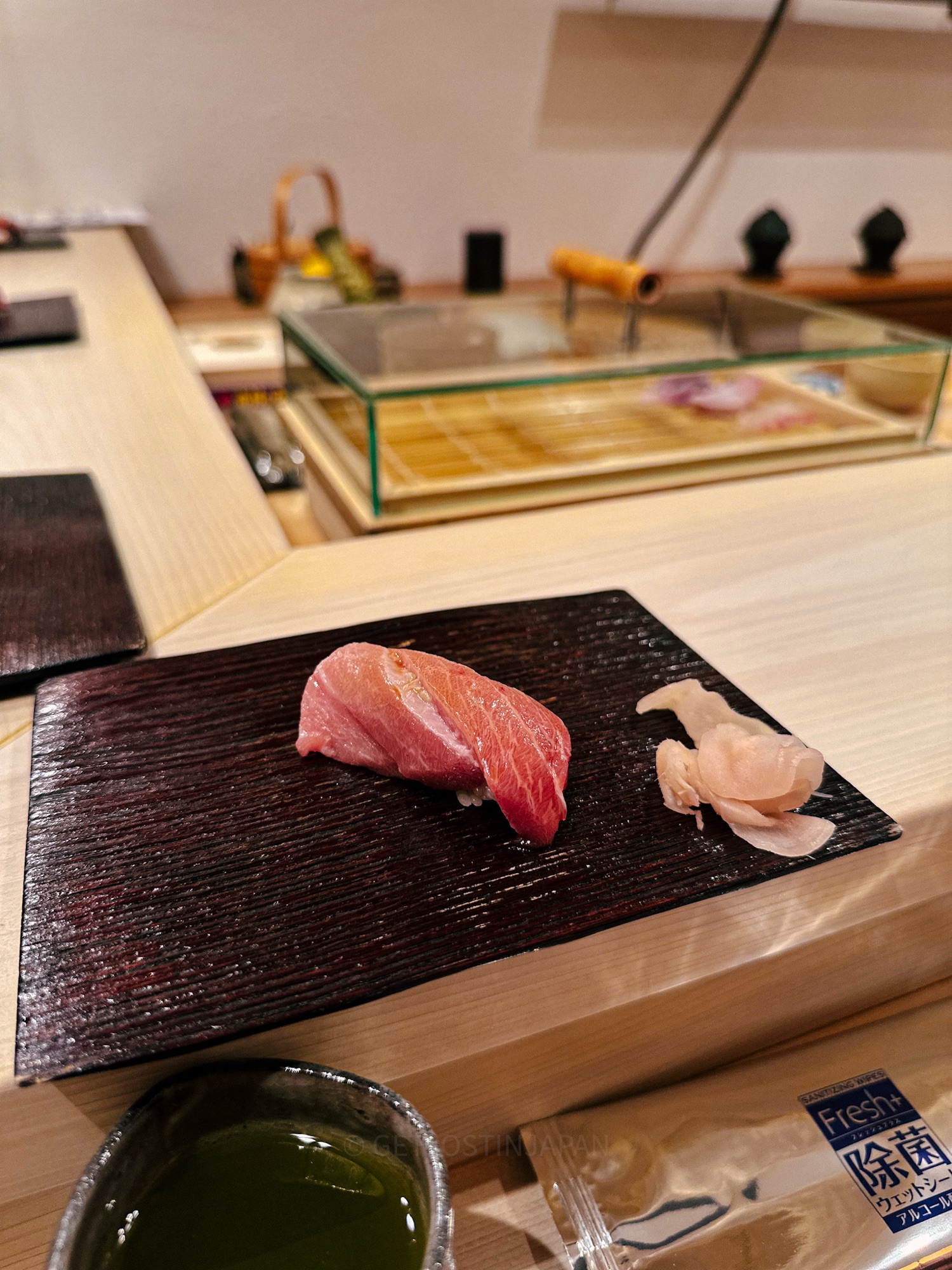
Many omakase restaurants will charge $100-$200 on average. Sushi Tokyo Ten is a fantastic alternative that’s affordable and conveniently close to Shinjuku.
Evening: Omoide Yokocho
Now, omakase is known for its delicious flavors and being quite satiating. However, there’s a fair chance that you might still have room in your stomach. If that holds true, I recommend checking out Omoide Yokocho, affectionately coined “Piss Alley” by tourists.
This atmospheric alley is famous for its old world charm and quaint, cozy restaurants. Each restaurant usually only accommodates 4-8 people, serving up yakitori and izakaya dishes in a casual atmosphere.

If you’ve never visited, then I do recommend seeing it at least once. It’s pretty touristy, but has the quintessential Japanese charm of small, buzzing alleyway restaurants.
Drinks at Golden Gai or New York Bar
Thinking about ending your last night in Tokyo with a drink? I couldn’t have thought of a better ending myself!
Around the Shinjuku area is Golden Gai, a narrow alley packed with tiny bars perfect for bar hopping. I especially liked Deathmatch in Hell, a horror-themed bar that plays scary movies in the background. You can start anywhere and see where you end up when the night ends. People party every day in Tokyo until the trains start running again at 5 am, after all!

Although it’s temporarily closed, New York Bar is also another popular spot, famous for being featured in “Lost in Translation”. It’s an upscale bar on top of Park Hyatt Tokyo with incredible views of Tokyo’s skyline. It’s set to reopen in October 2025!

Day 5: Kyoto
Today will be a transfer day as you head to Kyoto, so leave your morning pretty free to accommodate for travel time and fatigue.
Kyoto used to be the capital of Japan, and is home to 17 UNESCO World Heritage sites, one of the world’s largest collections. It’s one of my favorite cities here. There’s an incredible amount of history and culture, and it’s a bit slower paced than Tokyo or Osaka, so it almost feels like a nice breather.
Morning: Head to Kyoto
You’ll be taking the Shinkansen bullet train for around 2.5 hours to get to Kyoto. It can be hectic looking for the Shinkansen area, so come early. You’ll be taking either the Hikari, Nozomi, or Kodama trains, so make sure to note your train name and number.
💡 Pro tips
- Arrive early (30-45 mins prior), as it can be tricky getting to the Shinkansen.
- Make sure to ask for assistance if you’re lost, the train staff are very resourceful!
- Bring food, as there is no longer food served on the bullet train. I like to grab convenience store food inside the train station.
Using Japan’s Luggage Delivery Service
I mentioned this before, but if you have a full sized check in luggage you’ll either have to ship your luggage (recommended), snag a reserved seat with oversized luggage space (hard to do), or be able to put your luggage on the overhead space (very hard to do for common mortals like myself).
Now that you’ve gathered up some souvenirs and your luggage is starting to pack on weight, I recommend shipping your luggage versus hauling it around the train station. It’s a pain to bring full-sized luggage around the train station because the chances of having to haul it up and down stairs are extremely high.
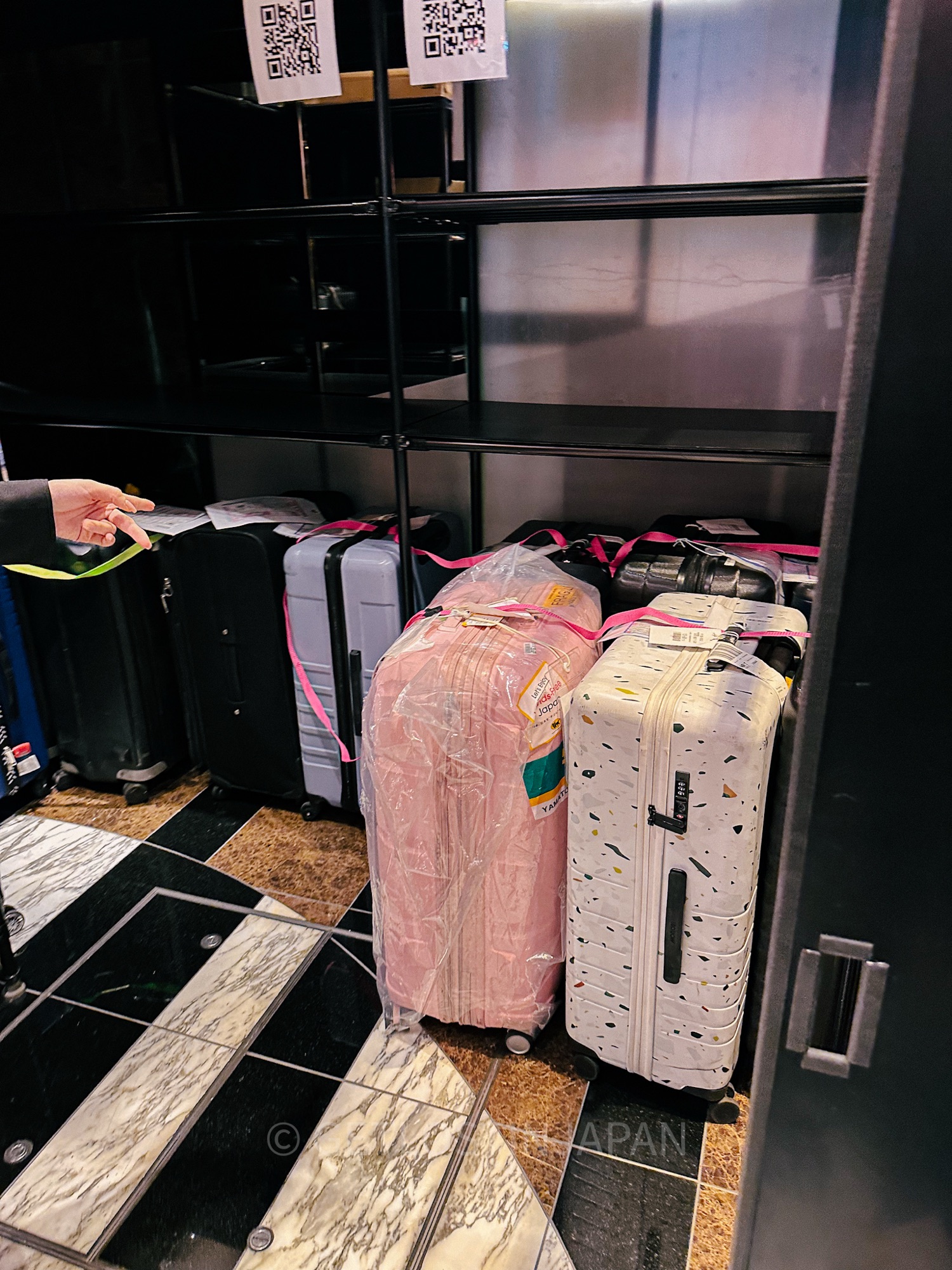
For an in-depth guide on how to ship your luggage with Japan’s luggage forwarding service, click here.
Hopefully, you don’t have your luggage with you, so you can explore Kyoto immediately! If you do have your luggage with you, you can either look for available lockers at the train station or drop your bags off early before heading out.
Most hotels will let you drop off your luggage before check-in, but some budget hotels, hostels, and Airbnbs won’t, so make sure to confirm with your accommodations.
Lunch: Ramen at Honke Daiichi Asahi Honten
For lunch, I recommend grabbing something around Kyoto Station. The restaurants inside the station are usually very good, but if you’re willing to walk just a few minutes, you can enjoy some excellent ramen at Honke Daiichi Asahi Honten, which is ranked #1 for ramen in Kyoto!

This tremendously popular ramen shop serves Kyoto-style ramen, tonkotsu broth with locally sourced ingredients, including soy sauce from Fushimi. Just be aware that there can be a very long queue during popular hours, so keep your day flexible if you intend to eat here.
Afternoon: Nijo Castle
If you’re not too tired, you can squeeze in a visit to Nijo Castle today.
Nijo Castle was the former residence of the Tokugawa shogunate during the Edo Period in the 1600s. It was built in 1603 and has stood the test of time due to its beauty and cultural significance, such as the rise and subsequent fall of the Tokugawa family.
🏯 Book your tour to Nijo Castle and Kyoto Imperial Palace! 🏯
Now, Nijo Castle is a World Heritage site famous for its elegant gardens, the Honmaru Palace, and the Ninomaru Palace, which is the only surviving example of a fortified palace complex.
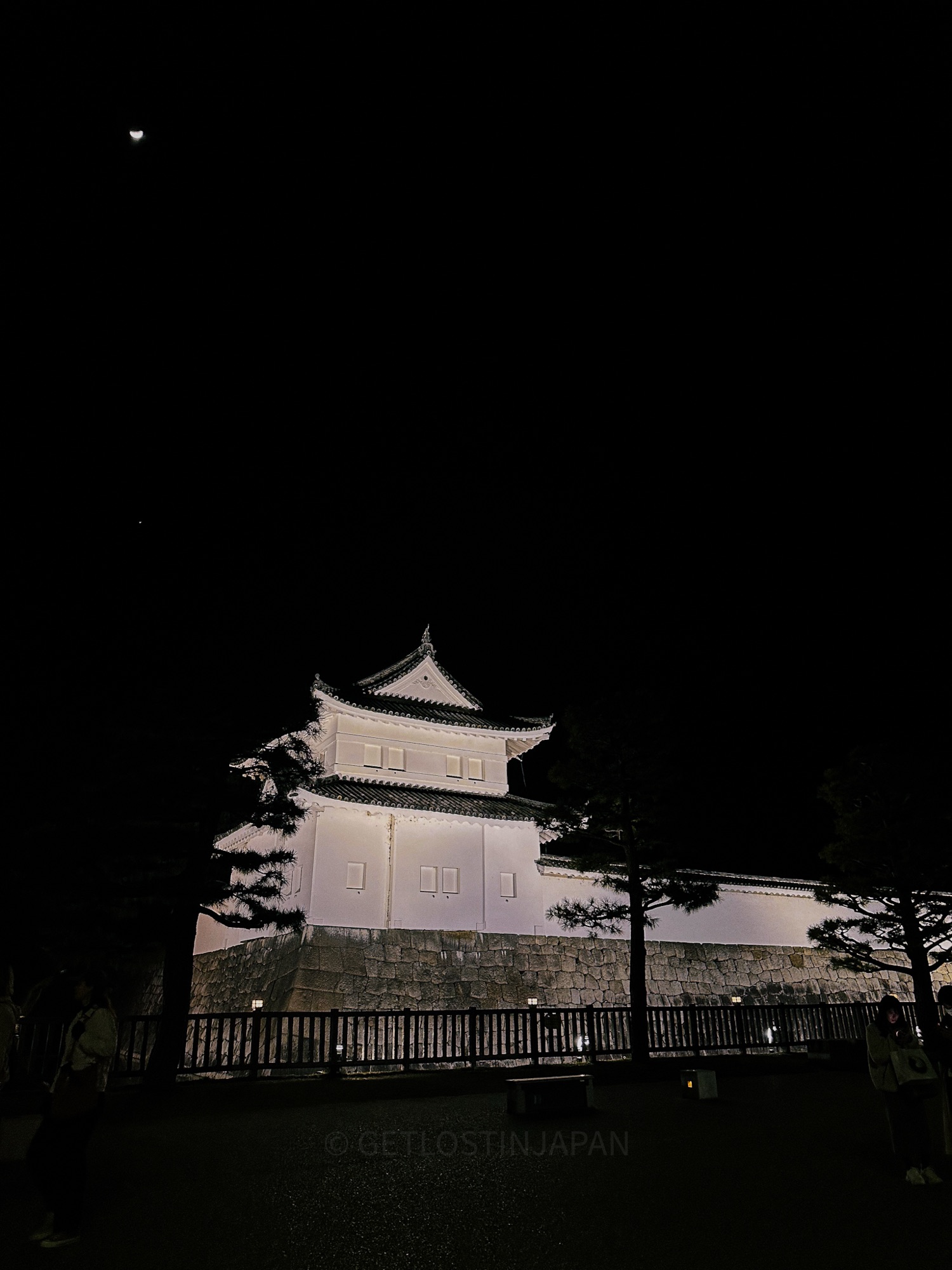
I highly recommend including either the Honmaru or Ninomaru Palace during your visit. The Honmaru underwent a full-scale renovation and reopened to the public for the first time in 18 years last year in 2024, so you’re able to see the architecture and art in all its splendour.
You can book a tour that includes admission to the Kyoto Imperial Palace along with Nijo Castle if you’d like to learn about the history in-depth from a knowledgeable guide.
Evening: Gion District Geisha Tour
Take the rest of the day exploring Gion (祇園), Kyoto’s most famous geisha district. We took a 3-hour walking tour and it was one of our favorite things that we did on the trip. We were able to learn about geisha history and culture, and even spotted a geisha!
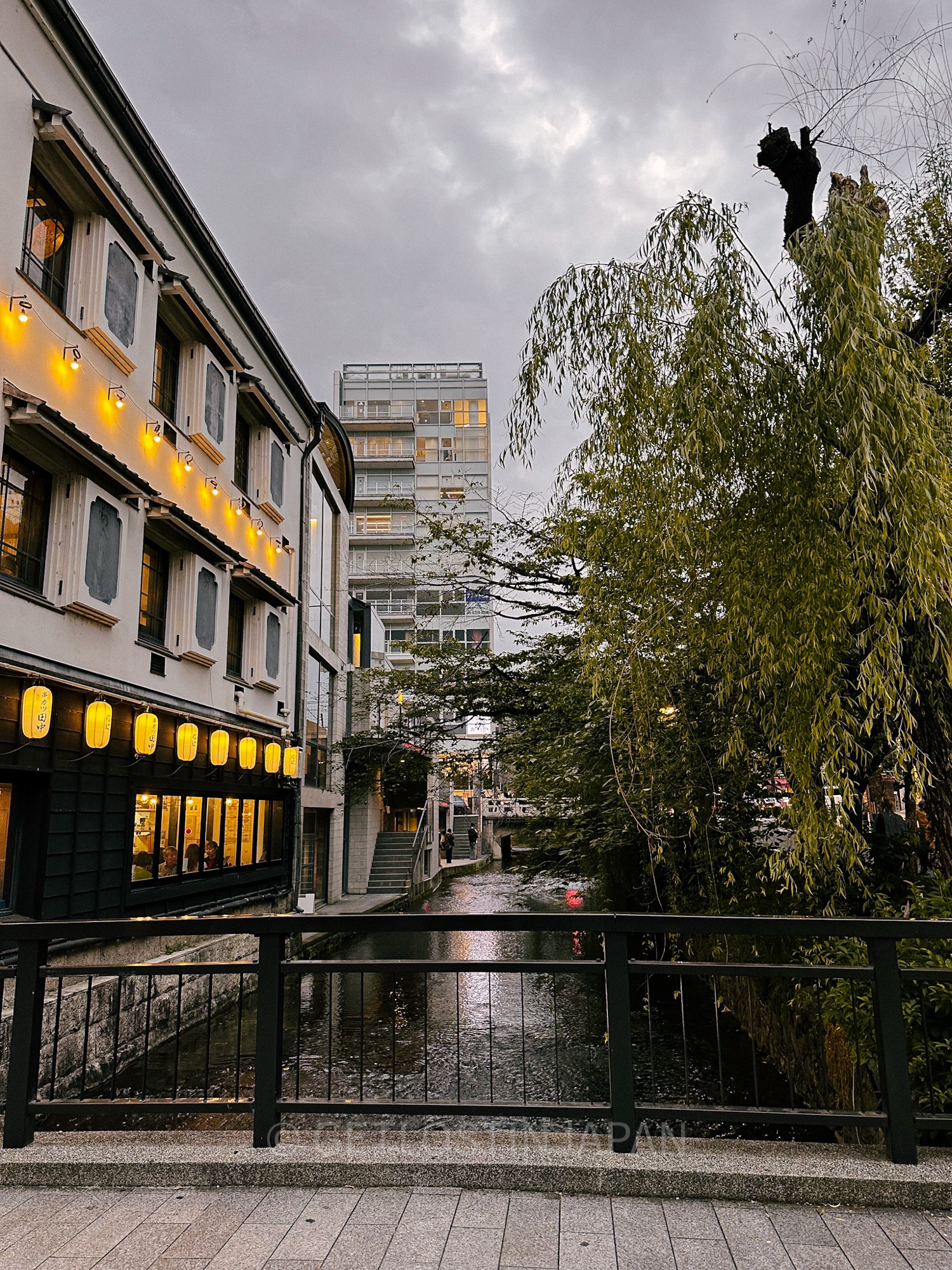
We ended the evening with an incredible 10-course kaiseki meal at a locally-loved restaurant. It was amazing learning about Kyoto's history and enjoying kaiseki dining from the city it originated from! Our guide, Thomas, was so knowledgeable and demonstrated proper kaiseki etiquette as well as how to take proper photos of geishas without being rude.
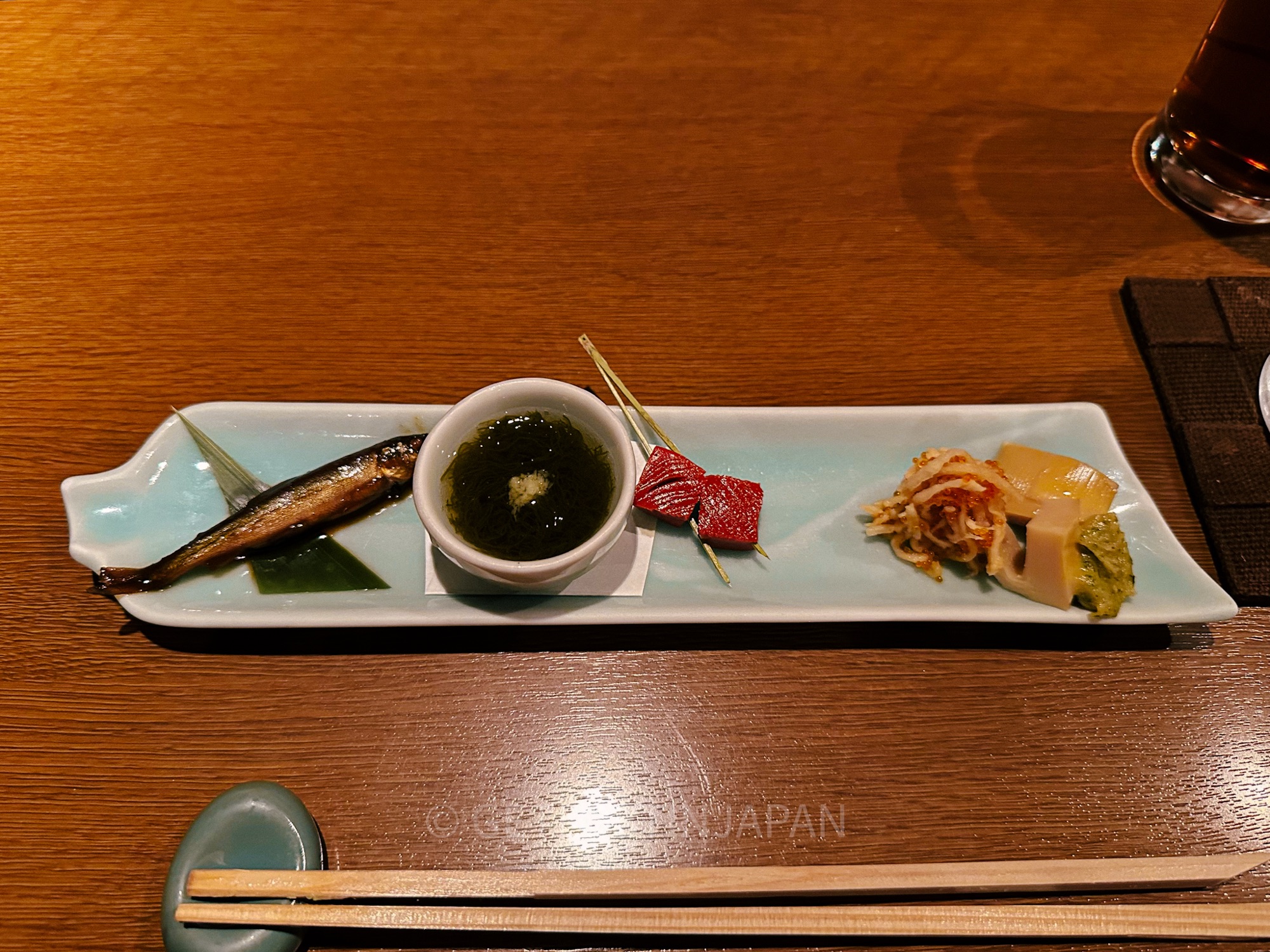
If you take this tour, dinner is included, so you can enjoy Japanese haute cuisine and spend the rest of the evening exploring Gion!
Book your geisha tour of Gion and enjoy FREE cancellation!

Where to Stay in Kyoto
Kyoto has a lot of great attractions, but unfortunately, they’re pretty spread out. I’ve stayed near Kiyomizu-dera and in Gojo, and I personally think that it was more convenient to stay central and closer to Kyoto Station. However, I loved both the hotels I stayed at and wholeheartedly recommend both.
M’s Hotel (Central)
I recently stayed in M’s Hotel Gojo Odawara just a few weeks ago, and loved it. The room is very spacious compared to Japanese standards, and the beds were super comfortable! The hotel is quite modern with keyless entry, and it’s located in a central location just a 6-minute train ride from Kyoto Station.
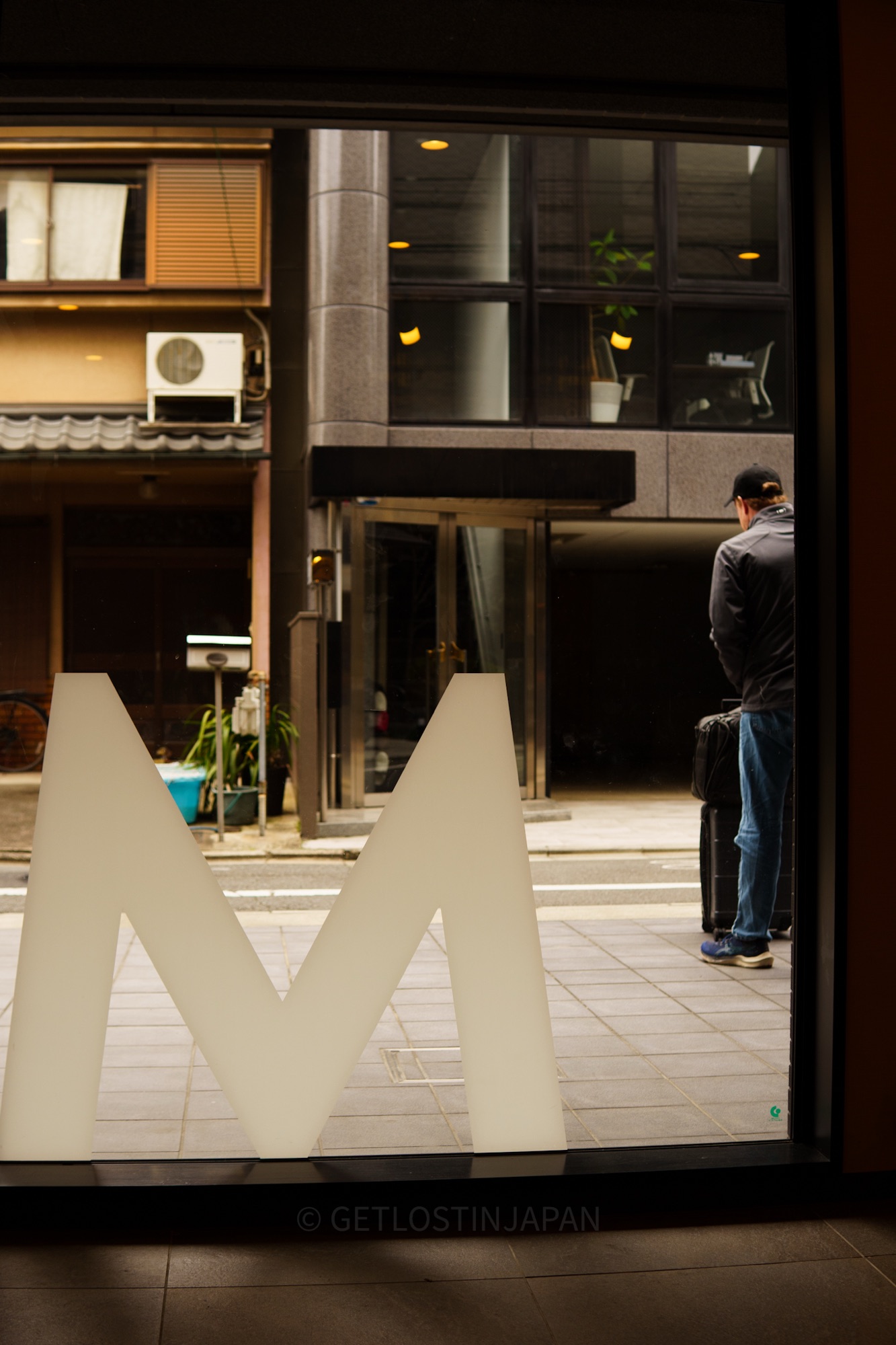
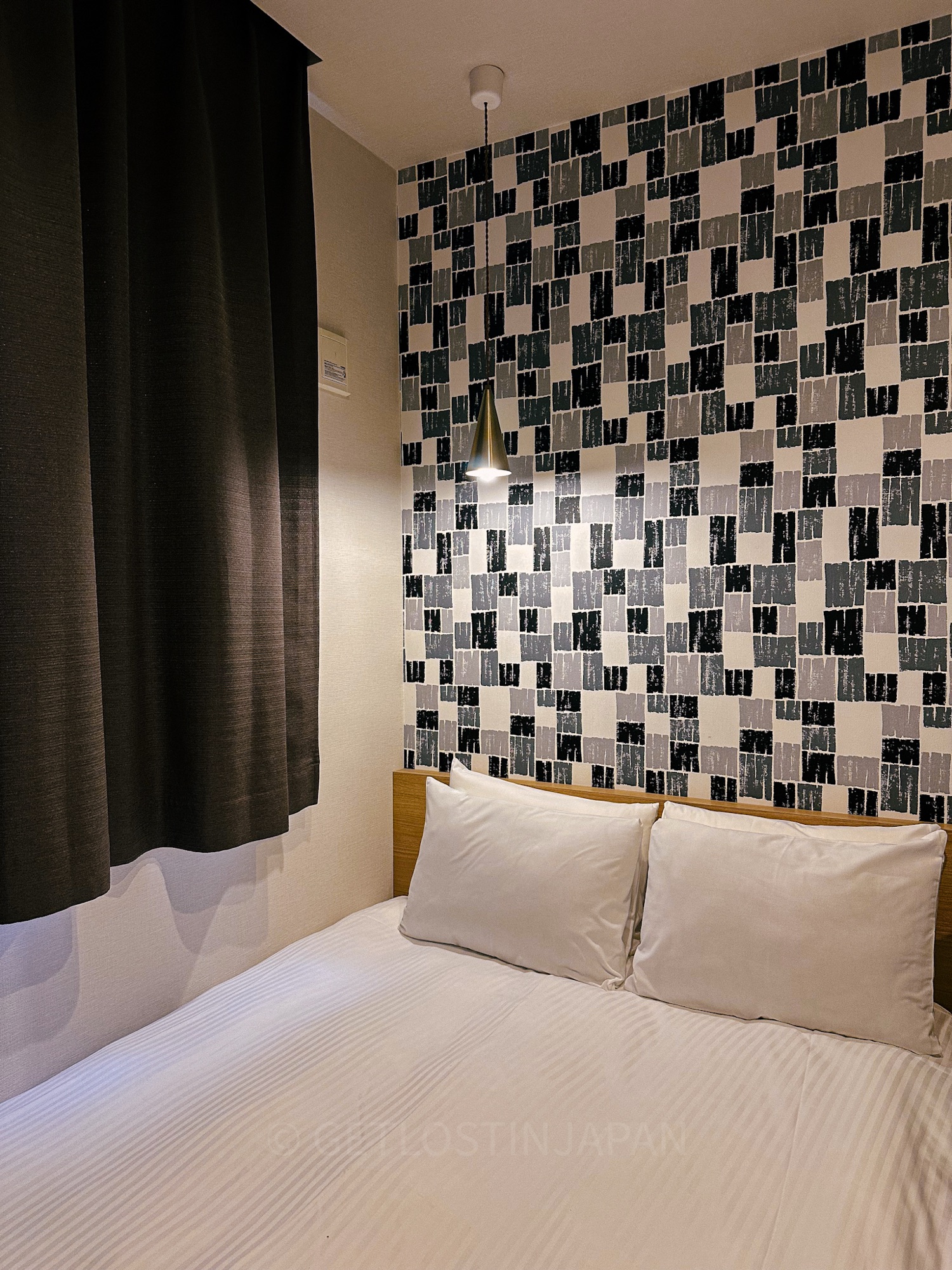
The only qualm I had was that the only mirror was in the bathroom, but compared to the quality of the rest of the stay, it’s a pretty small complaint.
The entire hotel is very clean, and there’s a small area with games and books in the lobby. I found that the hotel staff were very helpful and kind as well.

Saka Hotel Kyoto (Kiyomizu-dera)
Saka Hotel Kyoto is located near Kiyomizu-dera, my favorite temple in Kyoto. This hotel is a step up from M’s Hotel and exudes a quiet luxury. If you can afford the price point, it’ll be worth it.
Saka Hotel provides the same outstanding service that you would expect from a ryokan, but has a modernized twist with western beds. It felt like a middle ground between traditional Japanese ryokan and modern luxury hotels.
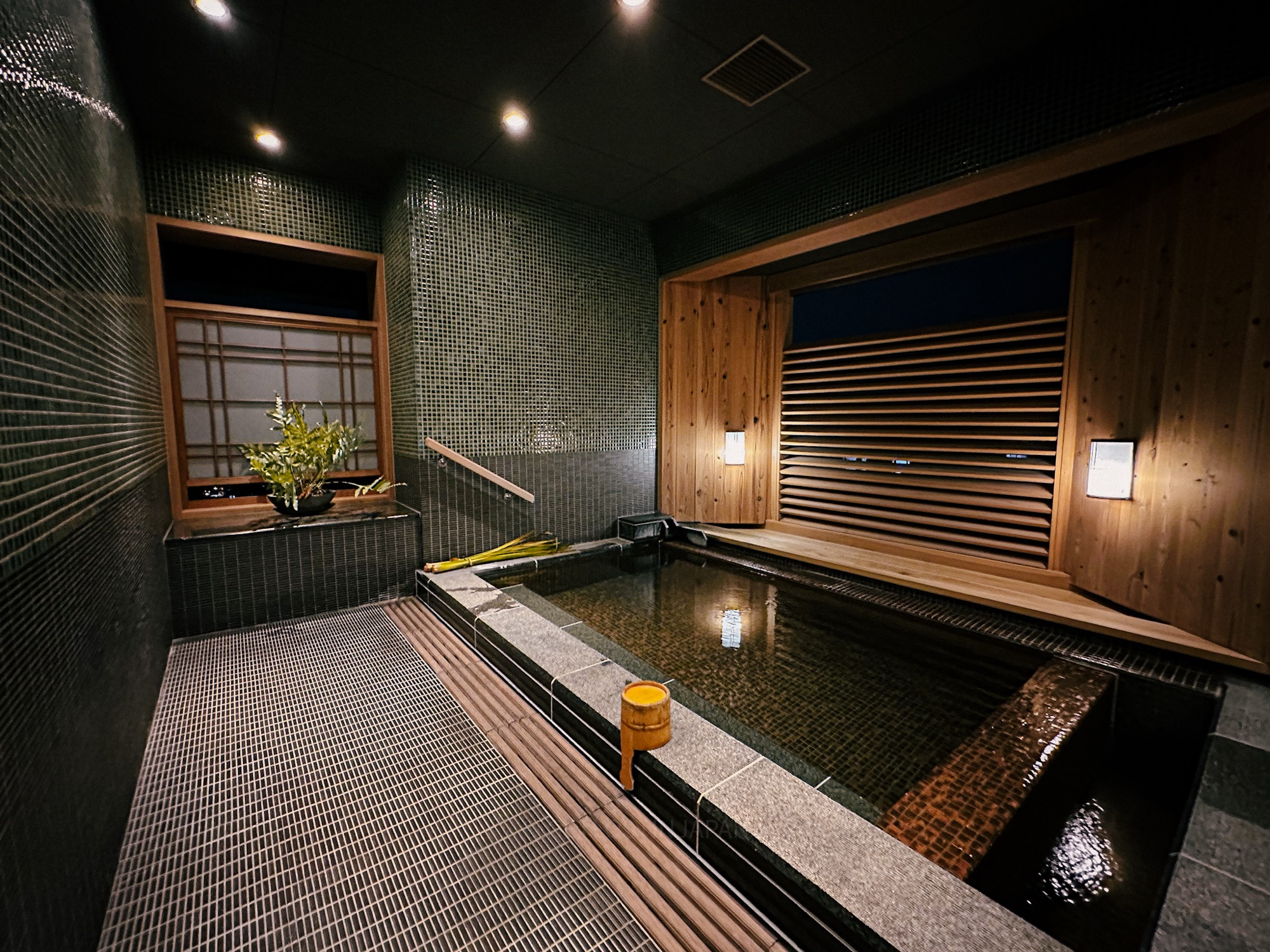
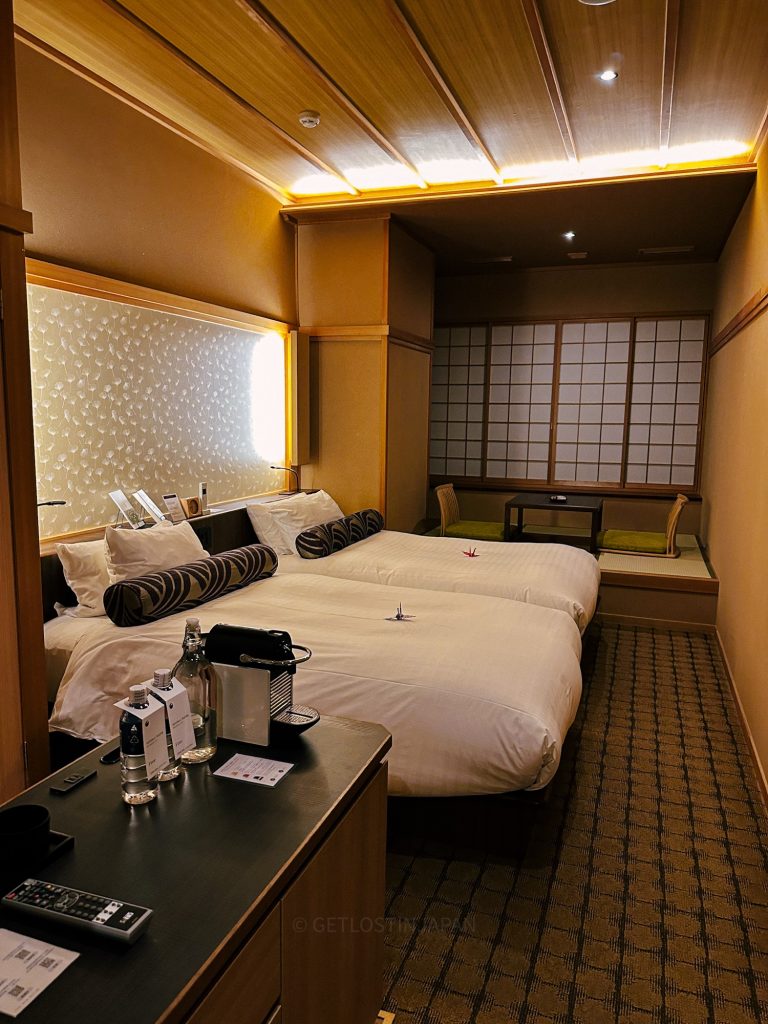
The rooms are incredibly spacious and are beautifully designed. The standout features are the private onsen you can rent and their kaiseki dinner. We booked a kaiseki meal and got a private room for ourselves. The dinner was sooo delicious, with Spanish mackerel and hot pot with Japanese black beef.
There’s also a lounge area with free ice cream, snacks, and coffee that’s always open! I grabbed snacks there every night, and I have no shame about it. If you want to learn more, I have a full in-depth review on Saka Hotel here.

Day 6: Arashiyama
Today is going to be a pretty packed day exploring Arashiyama, so I hope your feet are ready. You’ll hop on the Hozugawa boat ride, visit Tenryu-ji, and the Arashiyama Bamboo Forest.
Morning: Hozugawa Boat Ride
The Hozugawa Boat Ride is a very popular activity that showcases Kyoto’s natural landscapes in a relaxing two-hour river route. I recommend booking an early morning ticket for the Hozugawa Boat Ride and booking at least 1-2 months prior on Klook.
The boat ride ends in Arashiyama, but to get to the starting point, you’ll have to take a train ride to Kameoka, which can take 45 minutes to 1 hour depending on where you’re staying in Kyoto.
💡 Pro tip: Make sure to check the official website before arriving, as there can be cancellations based on weather conditions.
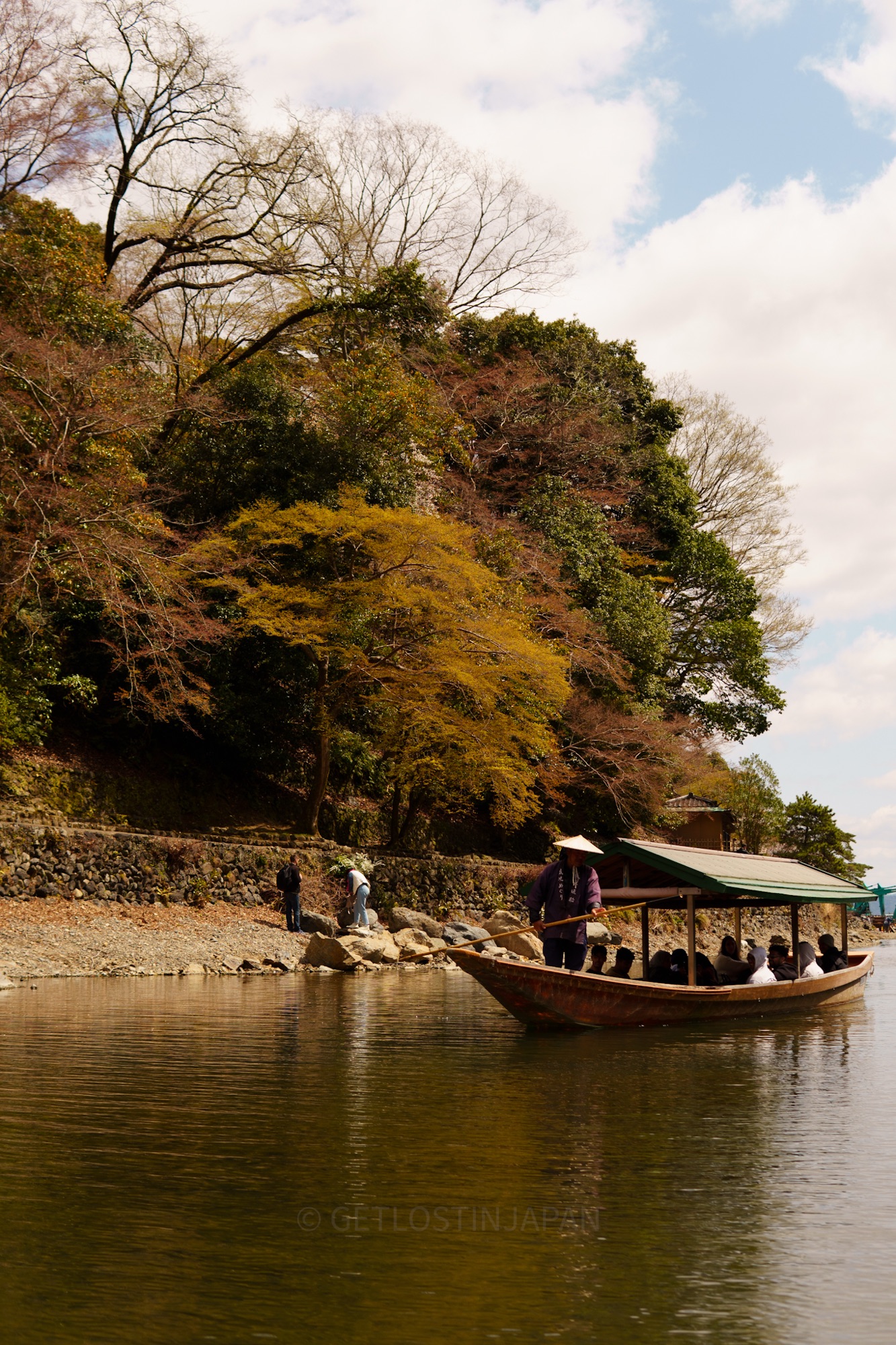
The boat ride was super relaxing, and the boatmen were fun and entertaining, pointing out landmarks all along the ride and cracking jokes with us, even with their limited English! They made the ride very enjoyable.
When I went on April 4th, the cherry blossoms hadn’t bloomed along the river yet. That was a bummer, but we enjoyed full bloom around the rest of the city, so we weren’t too upset.
💡 Pro tip: The best times for the boat ride are in mid-April for cherry blossoms and November for colorful foliage.
Lunch: Arashiyama
The boat ride will drop you off in Arashiyama, where we’ll spend the rest of our day. There are a couple of themed cafes here, like the Miffy Kitchen and Rilakkuma Tea House you can check out.
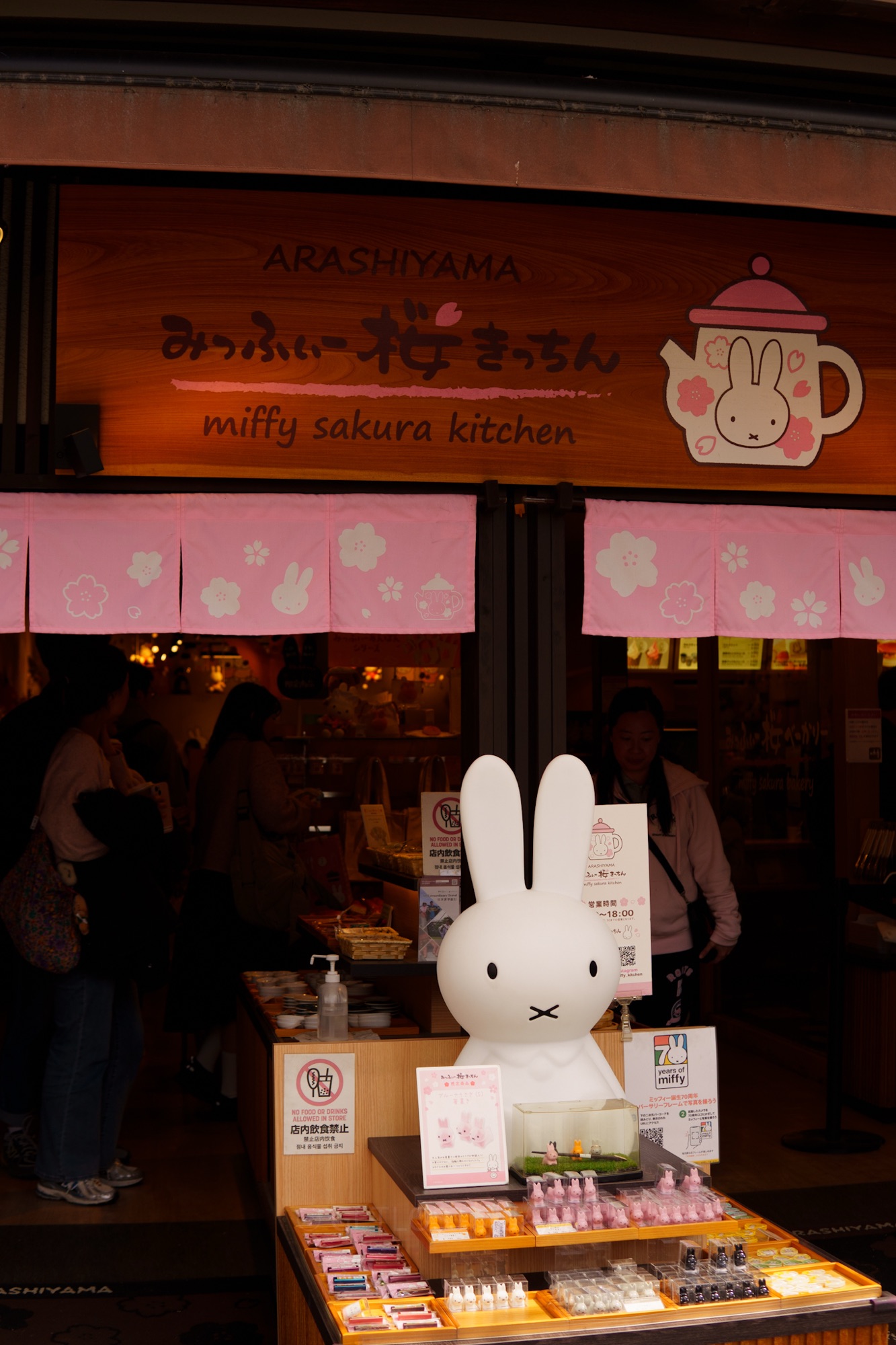
I traveled in a large group, so we ate at Arashiyama Gourmet Yokocho, a large food court with a variety of dishes including curry, udon, and donburi. I got a salmon tuna donburi and also tried out Mont Blanc ice cream! While the Mont Blanc is interesting and aesthetic, I think trying it just once is enough.
Afternoon: Explore Arashiyama
There are many amazing attractions in Arashiyama that you can check out. I'm going to add the main attractions to see here, but for more details you can check out my Arashiyama 1-Day itinerary.
Tenryu-ji
If I had to choose one place to visit in the area, I’d go to Tenryu-ji, also known as the Silver Pavilion. Tenryu-ji is a Zen temple that was built at the previous site of Japan’s first Zen temple and was used as a detached palace at one point. It’s also one of the 17 UNESCO World Heritage Sites in Kyoto.
I haven’t visited since 2019 so my memory is a little fuzzy, but I remember how utterly serene and beautiful the outdoor gardens were. It’s the perfect way to experience the quiet beauty of Arashiyama forest.
Tickets to just the gardens are 500 yen, and if you want to see the buildings, it’s an additional 300 yen. You can buy tickets when you get there; no need to purchase in advance.
Arashiyama Monkey Forest
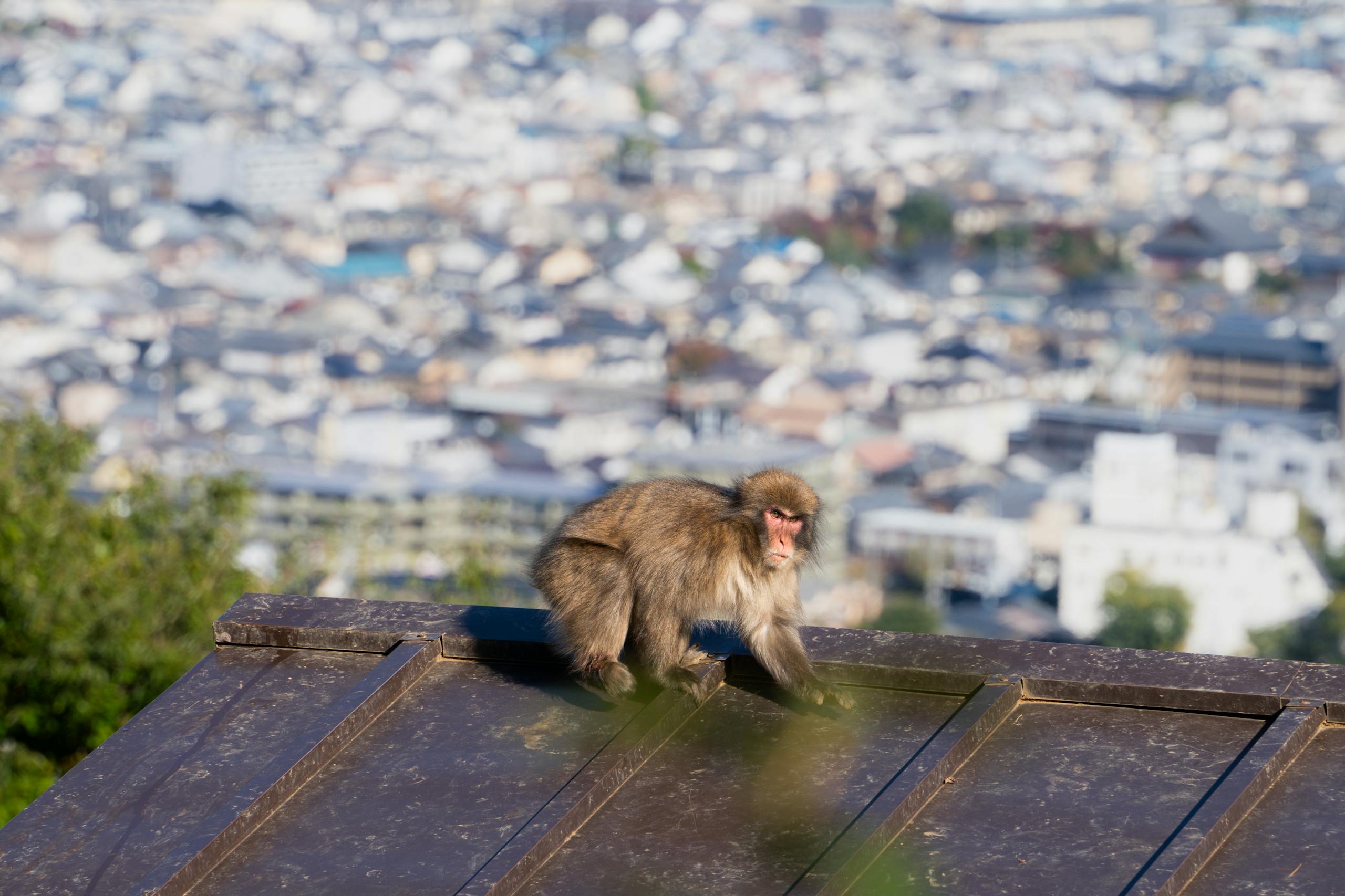
The Arashiyama Monkey Park is home to 120 wild monkeys, where you can enjoy meeting them in their natural habitat. While they are wild, they are used to humans and aren’t dangerous. You can even feed them snacks like peanuts and apples in designated areas!
Keep in mind you’ll have to hike for about 20 minutes up the mountain to reach the Monkey Park! Plan to wear comfortable clothes for this visit. My friends did the trek in kimonos, and I assure you, they don’t recommend it. At the top, there is a playground and a great view of Kyoto City.
Arashiyama Yusei-Tei Gallery
This gallery has a longstanding history from the Meiji era, approximately 150 years ago, and exhibits works made from a unique dyeing method called ‘Yume-kôrozome’ by the host Yusai.
In this tranquil space, guests are invited to admire the beauty of Japan’s changing seasons paired with the whimsical works of art. There are dyeing courses as well, where you can create your own original scarf or jeans.
I didn’t get a chance to visit, but I’ve heard opposing reviews. Some say it’s utterly serene and a fantastic photo spot, while others think it wasn’t worth the money, so I suggest looking into it a bit more.
Arashiyama Bamboo Forest
The Bamboo Forest is one of Kyoto’s most famous sightseeing spots, a 400-meter (or 0.3 miles) road lined with scenic rows of fully grown bamboo. It’s a popular photo spot, and is just as busy as it is popular.
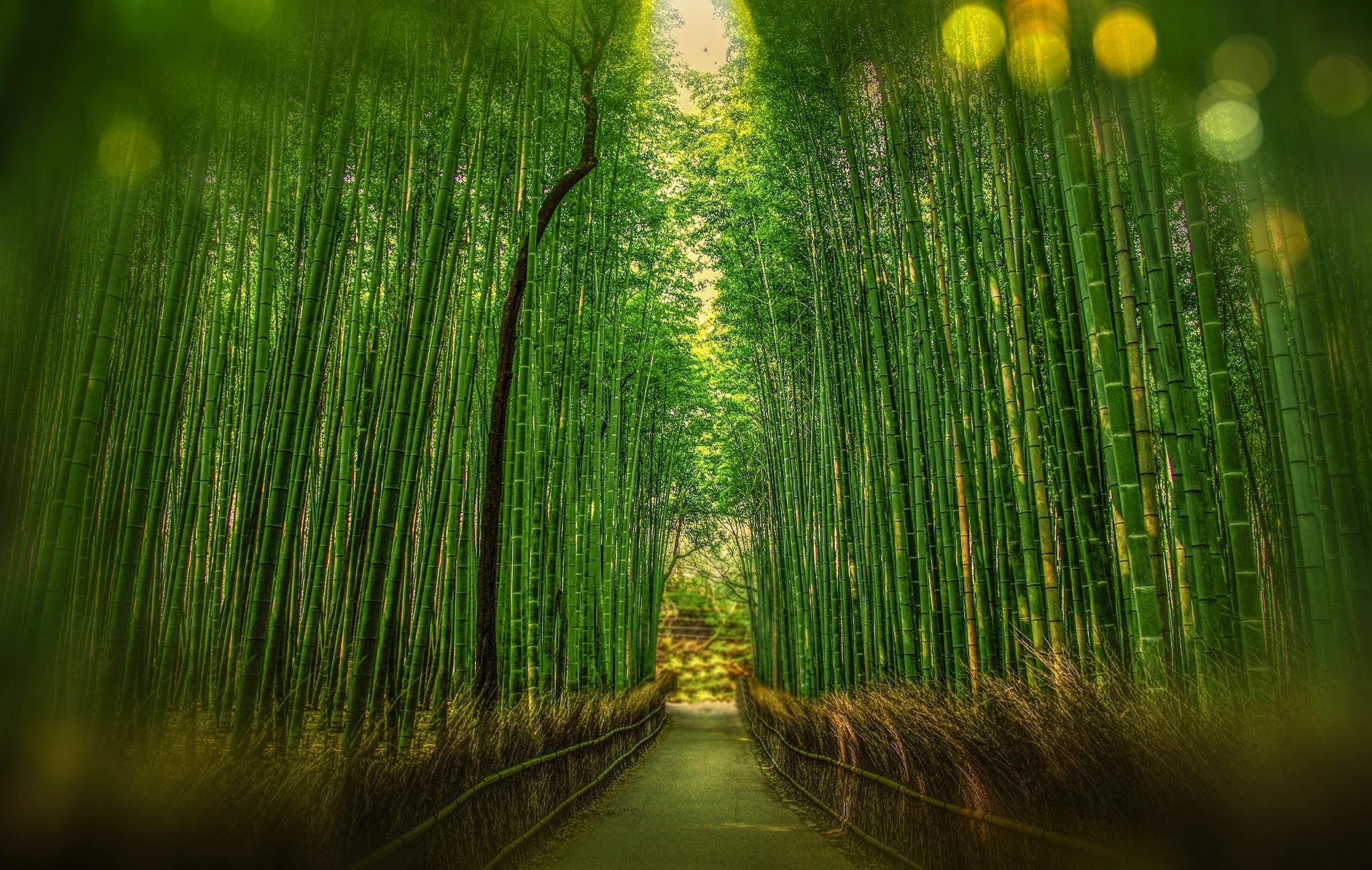
Personally, I thought the Bamboo Forest was a little overrated due to how crowded it was, but I can't deny it's a prime photo spot.
If you're interested in staying in one of the nearby ryokan, you'll be walking distance to the bamboo forest and can beat the crowds.
Make sure to visit on a sunny day, though, as on cloudy days the area looks very dark due to the bamboo blocking the light.
Dinner: Yakitori Torikizoku
For dinner, you can try yakitori, simple Japanese skewers cooked over a charcoal fire. Traditionally, it’s various types of skewered chicken, but you’ll find beef, pork, and vegetable skewers too.
Yakitori is very affordable, with each skewer usually costing 300 yen to 700 yen. There are a ton of yakitori restaurant options both in Arashiyama and Kyoto, but I recommend Yakitori Torikizoku back in Kyoto.
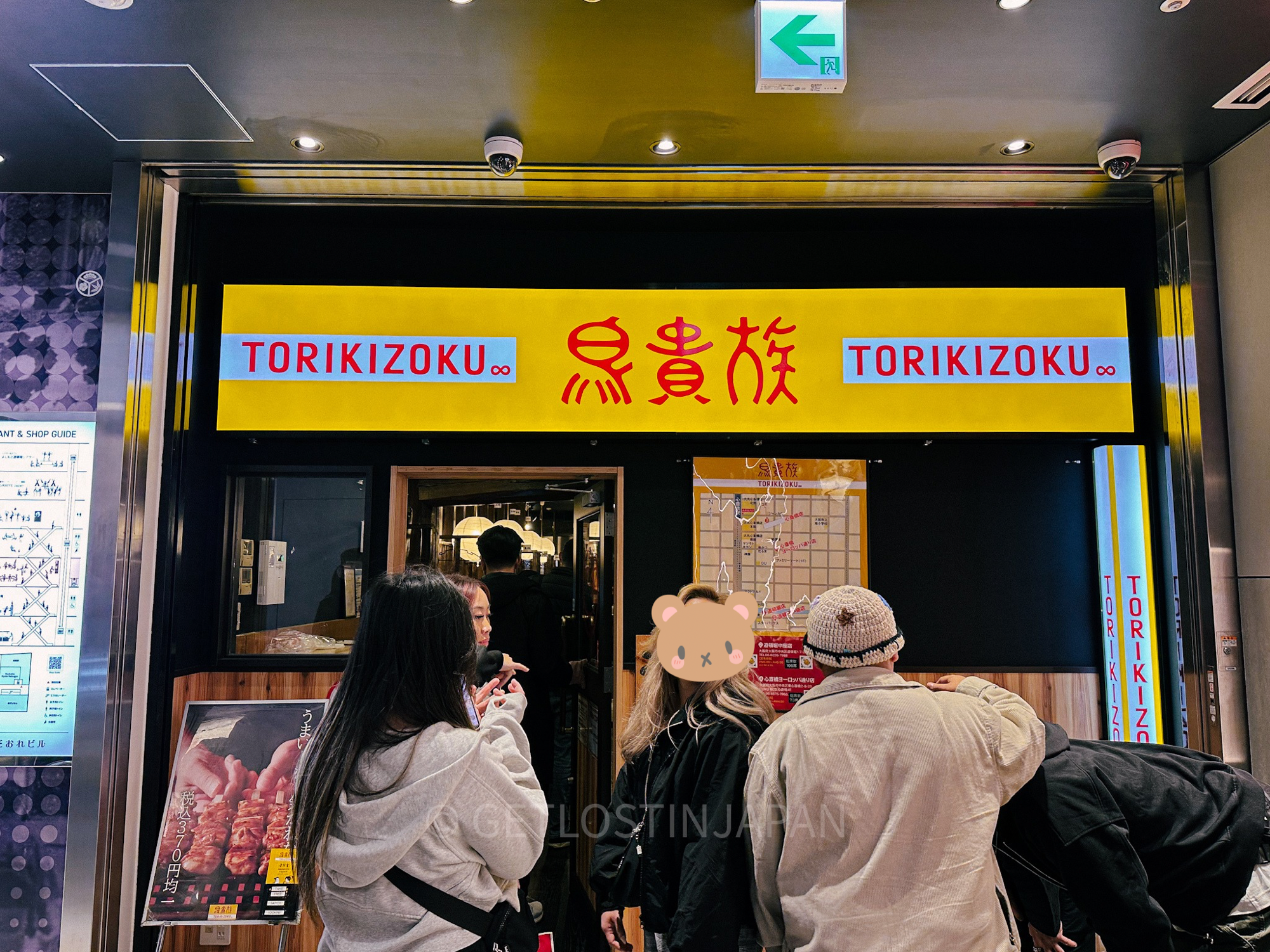
I ate here and really enjoyed it. The food was delicious, we were seated quickly, and all in all, it was a great value!


Day 7: Fushimi Inari and Kiyomizu-Dera
Now that our time in Kyoto is coming to an end, we have to hit a few more must-see spots before we can head over to Osaka. Today, you’ll visit Fushimi Inari, Kiyomizu-dera, and Nishiki Market. Today is also a good day to rent a kimono if you’d like.
Want to rent a kimono?
If you’re interested in renting a kimono while you’re here (yes, foreigners can do it too!) I highly recommend doing so in Kyoto. There are an abundance of beautiful temples that will be a nice backdrop for you, and tons of kimono shops are around.
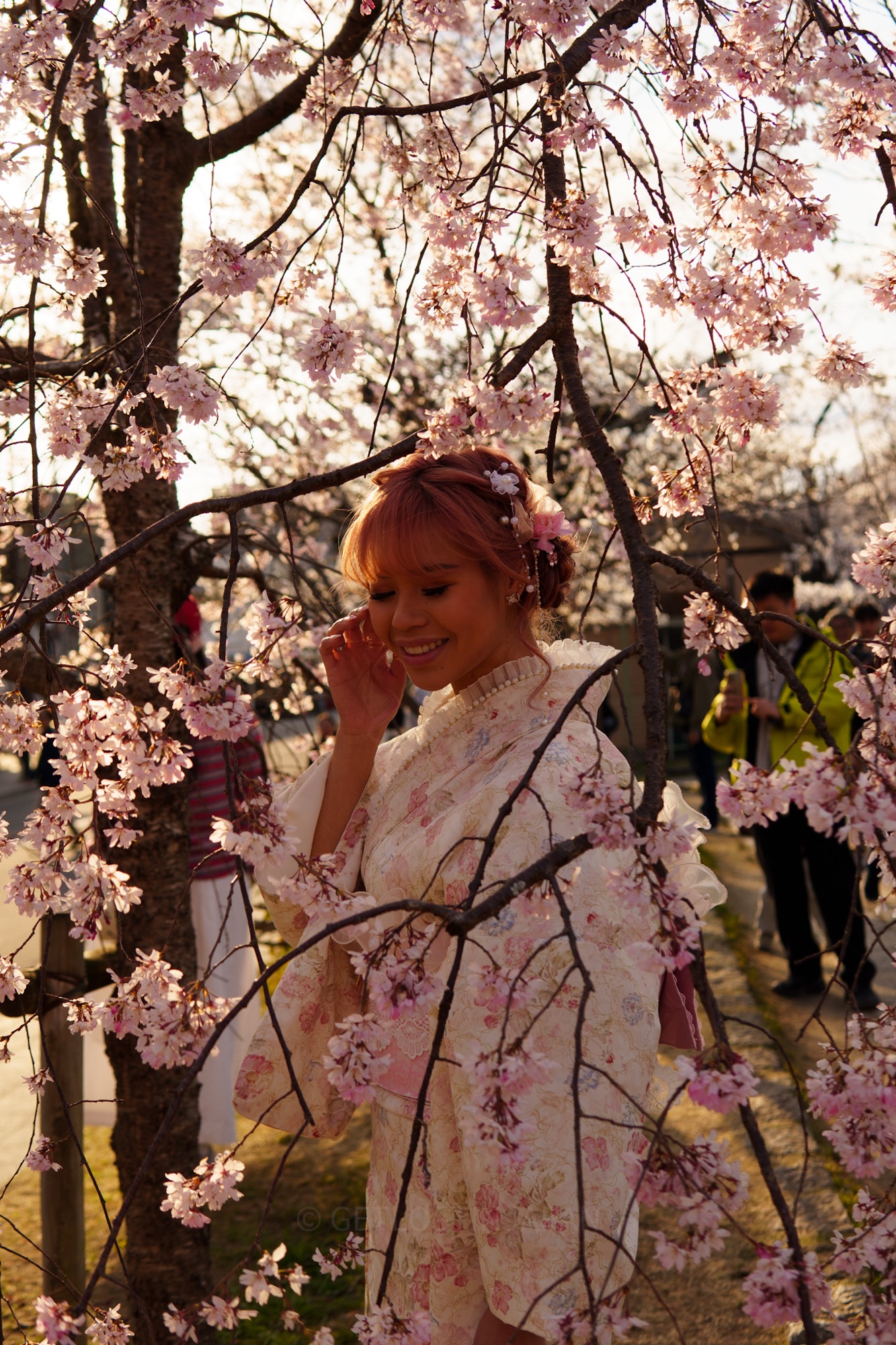
While making a reservation isn’t required, it is recommended. It’s also better to come in early for a larger selection of kimonos to choose from. Keep in mind that getting dressed and getting your hair done can make the entire process over an hour, and most kimono rental shops close at 17:00!
Dreamy Kimono Rental Kyoto Gion Shijo
I’ve rented a kimono a couple of times, and fell in love with this shop the last time I visited Kyoto. Dreamy Kimono looks unassuming and small at first glance, but there are actually a ton of styles, even though I came at 14:00.
The owners are a couple, and they speak Japanese, Chinese, and English! They’re super sweet, and very good at styling hair, too! We made a reservation through Instagram about 1-2 days prior, and they were able to accommodate our large group of 8 and let us return our kimonos a bit later at 18:00. I can’t recommend this hidden gem enough.
Fushimi Inari and Kiyomizu-dera are both great photo spots to visit while dressed in a kimono, though there are a lot of stairs at both locations. I’ve been to Bishamondo Temple and the Philosopher’s Path, and found that Bishamondo is beautiful and best visited in Autumn, while the Philosopher’s Path was a bit too crowded and had cars in the background.
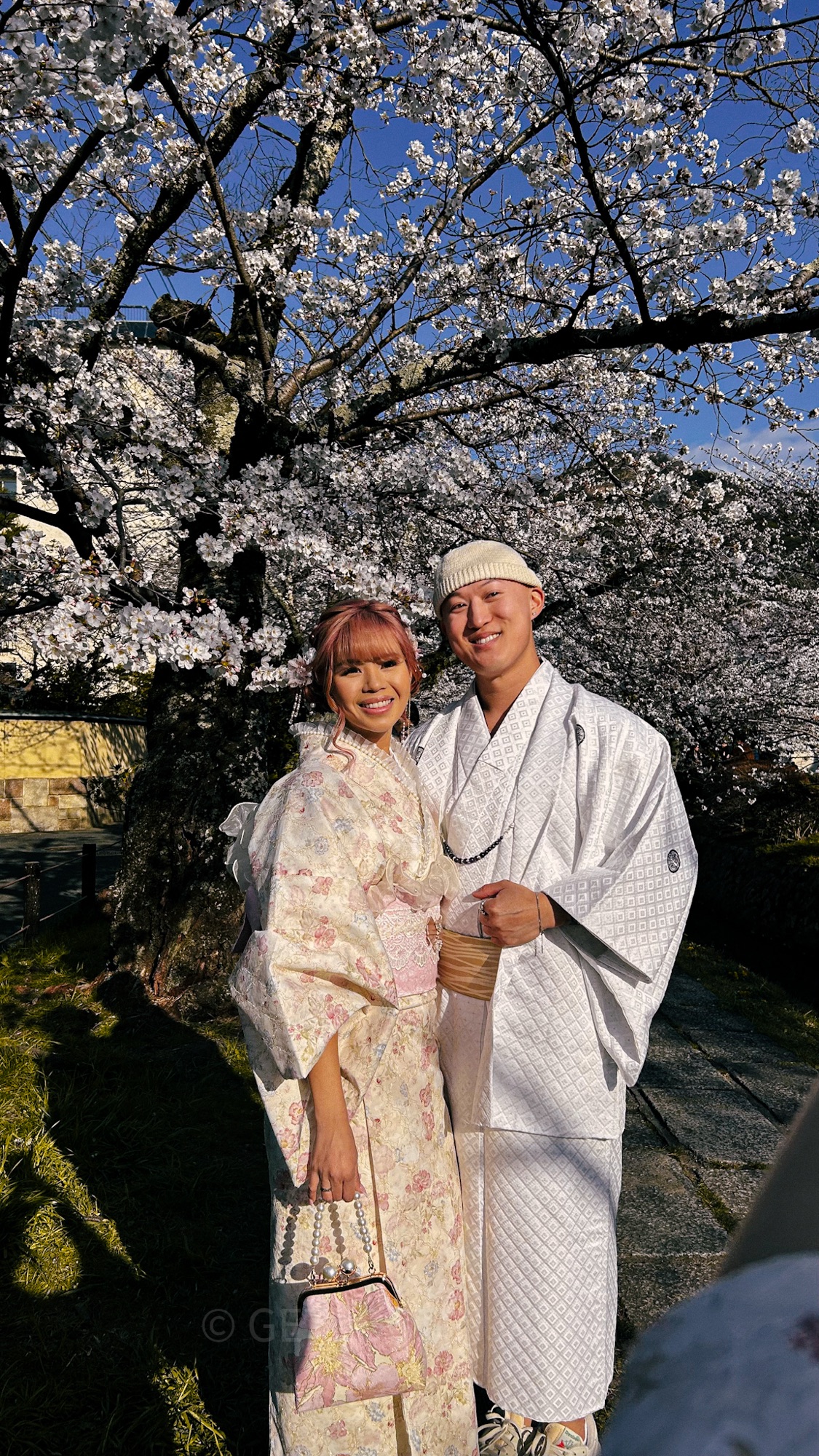
Morning: Fushimi Inari Taisha (Thousand Torii Gates)
We’ll start with Fushimi Inari first, since it’s a bit of a hike and gets super crowded. This is the famous 1000 torii gates that you’ve seen all over social media. I’ve hiked Fushimi Inari Taisha three times now, though I don’t think I’ve ever gotten to the end because it’s super long.
At the beginning, you’ll see lots of souvenir shops, with cute fox and torii-themed goods. Most of the shops close in the afternoon, so you can save it for when you return after visiting the shrine.

It’s usually crowded no matter what time of day you arrive (unless we’re talking 6 am), but don’t sweat it. You’ll attain the perfect picture that you so desire, I know it. Just keep walking further down until the crowds start to disperse a little bit.
Fushimi Inari and its surrounding shops should take up most of your morning, and potentially the afternoon, depending on how long you stay there.
Optional: Nishiki Market
If you have the energy, you could squeeze in a quick visit to Nishiki Market for lunch and souvenirs if you leave Fushimi early. This popular market has been operating for over 400 years, and has tons of stalls with seafood, produce, desserts, ceramics, and more.
We bought loose-leaf Hojicha tea, miso, and sampled lots of different snacks while wandering around the market.
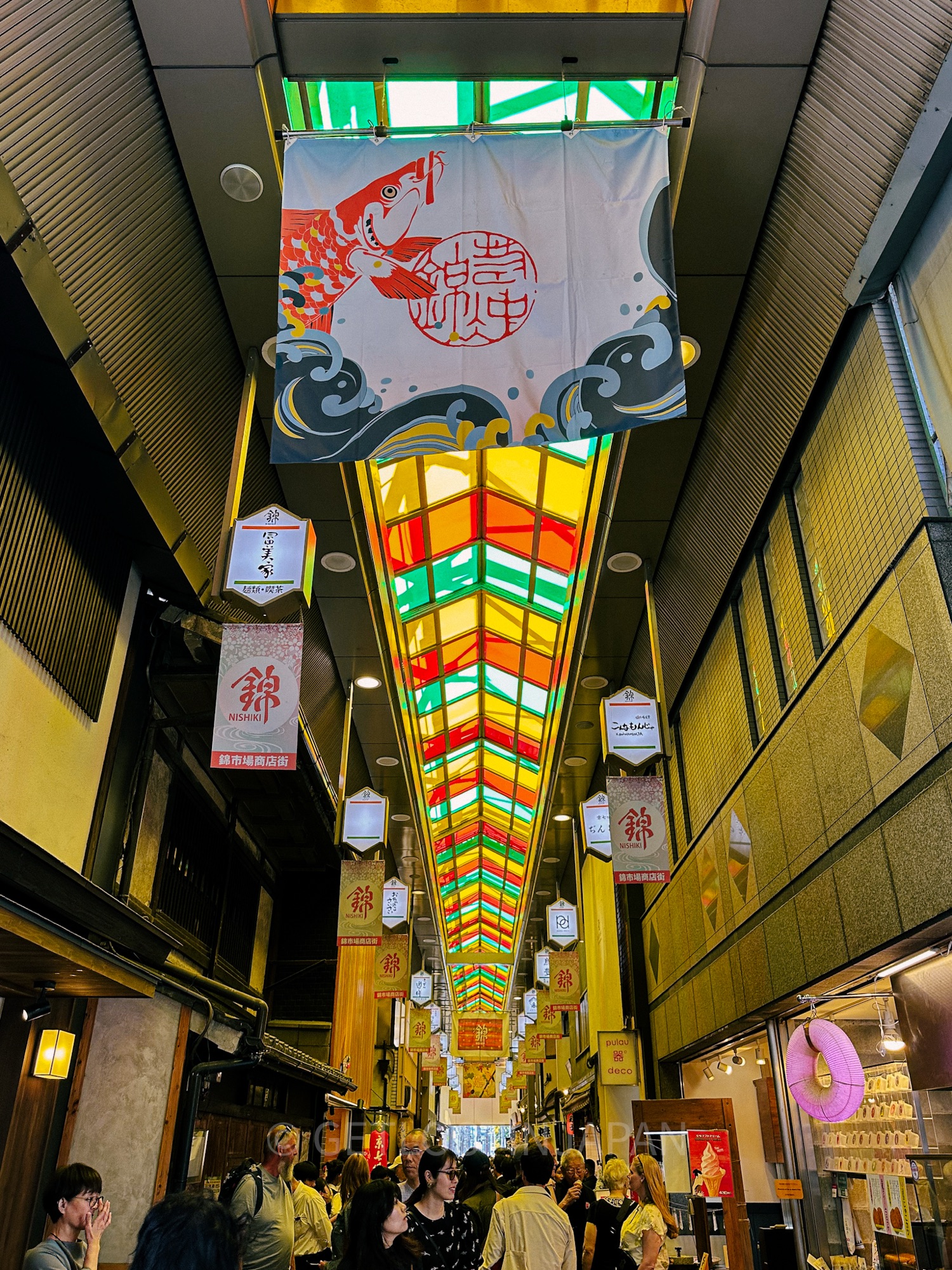
Stores here generally operate from 10:00-17:00, so I recommend visiting Fushimi Inari first and making a backtrack for the market if you’d like to visit.
Afternoon: Kiyomizu-dera
We have to save the best for last, right? Kiyomizu-dera is my favorite temple in Kyoto due to its utter beauty and incredible landscape, and I can’t wait for you to experience it. This magical temple sits halfway up Mount Otowa, and is lined with cute shops and restaurants that you can browse through as you make the trek up.
Once you get to the top, the temple is utterly beautiful. You can pay your respects to Kannon, the temple deity, and walk along the tranquil cherry blossom trees. You also get a magnificent view of the city down below.
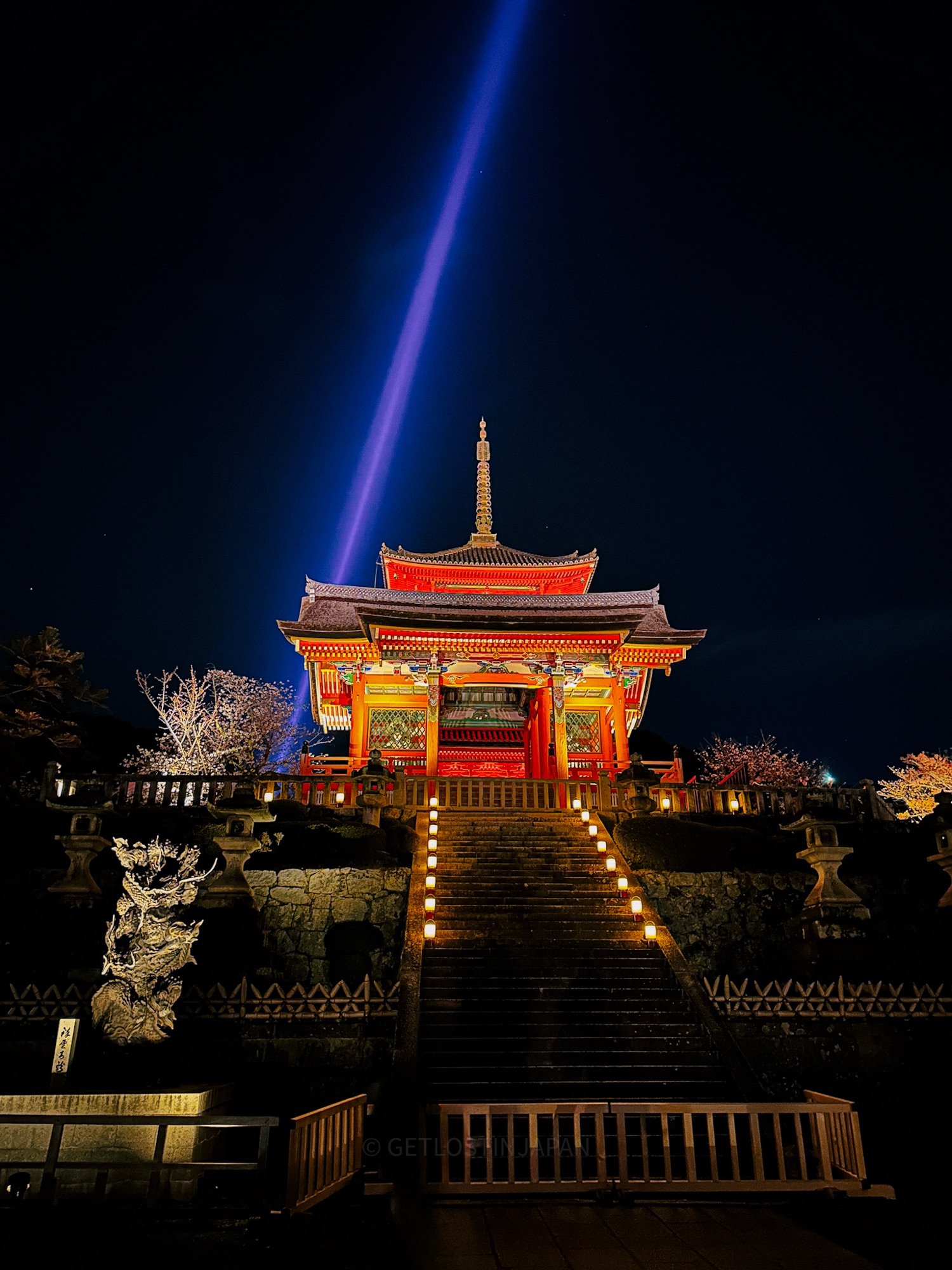
The temple is usually open until 18:00, but during special events it will stay open until 20:30. I’ve visited Kiyomizu-dera both during the day and at night. If you have the option to visit during day or night, I recommend going during the day when all the stalls are open.
If you visit at night, be aware that although the official website may say 21:30, starting at 20:30, they start announcing the temple’s closure numerous times, so plan to leave by 20:30 before the announcements get too bothersome.
Dinner: All you can eat Yakiniku with unlimited Drinks
For dinner, I recommend visiting one of my favorite Japanese barbecue spots, 0 Byo Lemon Sour!
This AYCE yakiniku restaurant has unlimited lemon sours on tap, and you get to choose 2 flavor syrups per table. I loved the lemon-shaped tap to go along with it. All the meats were delicious, but my favorite was the sukiyaki. The meat was super tender and sweet and it came with an egg to use as a sauce.
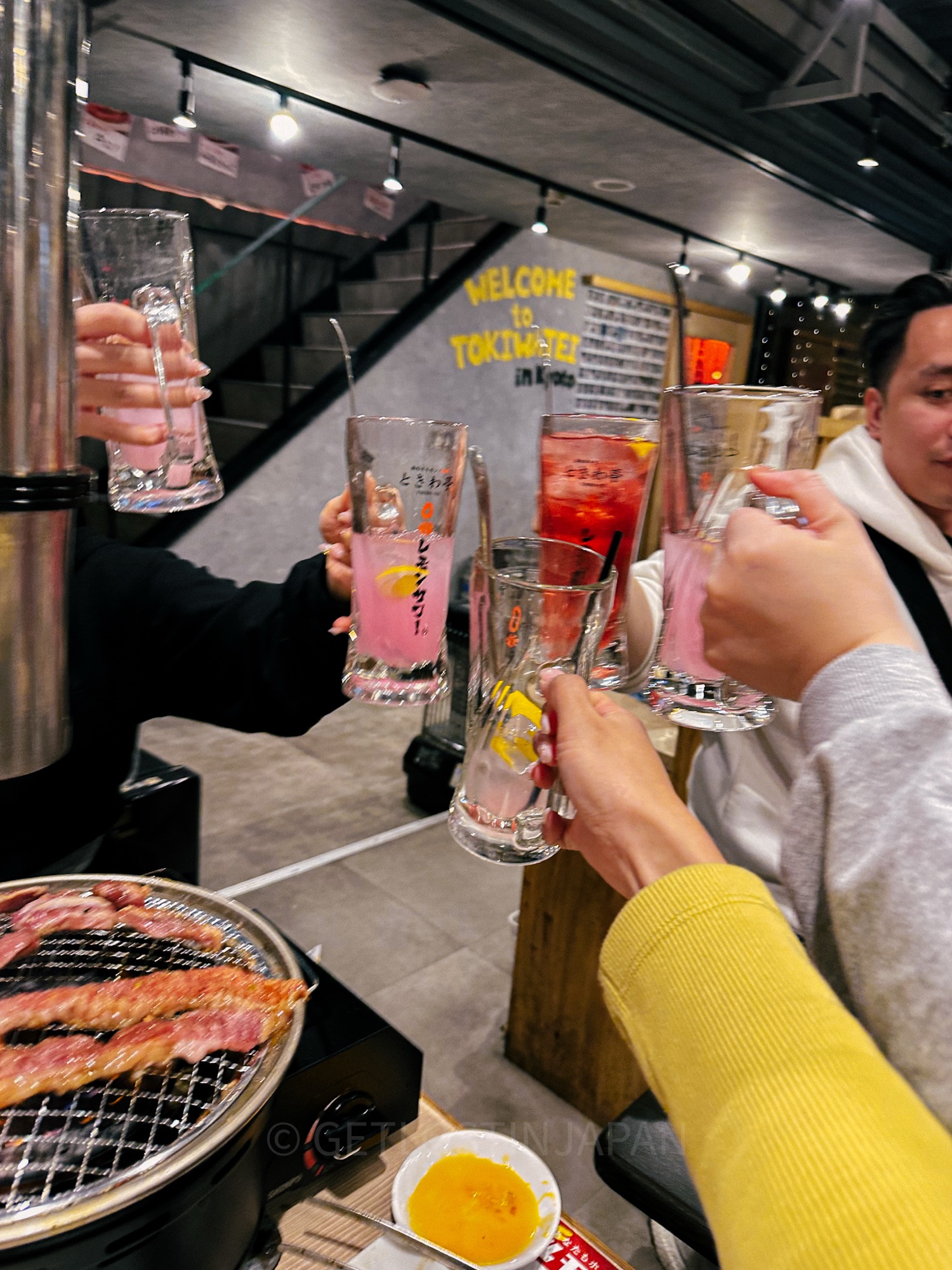
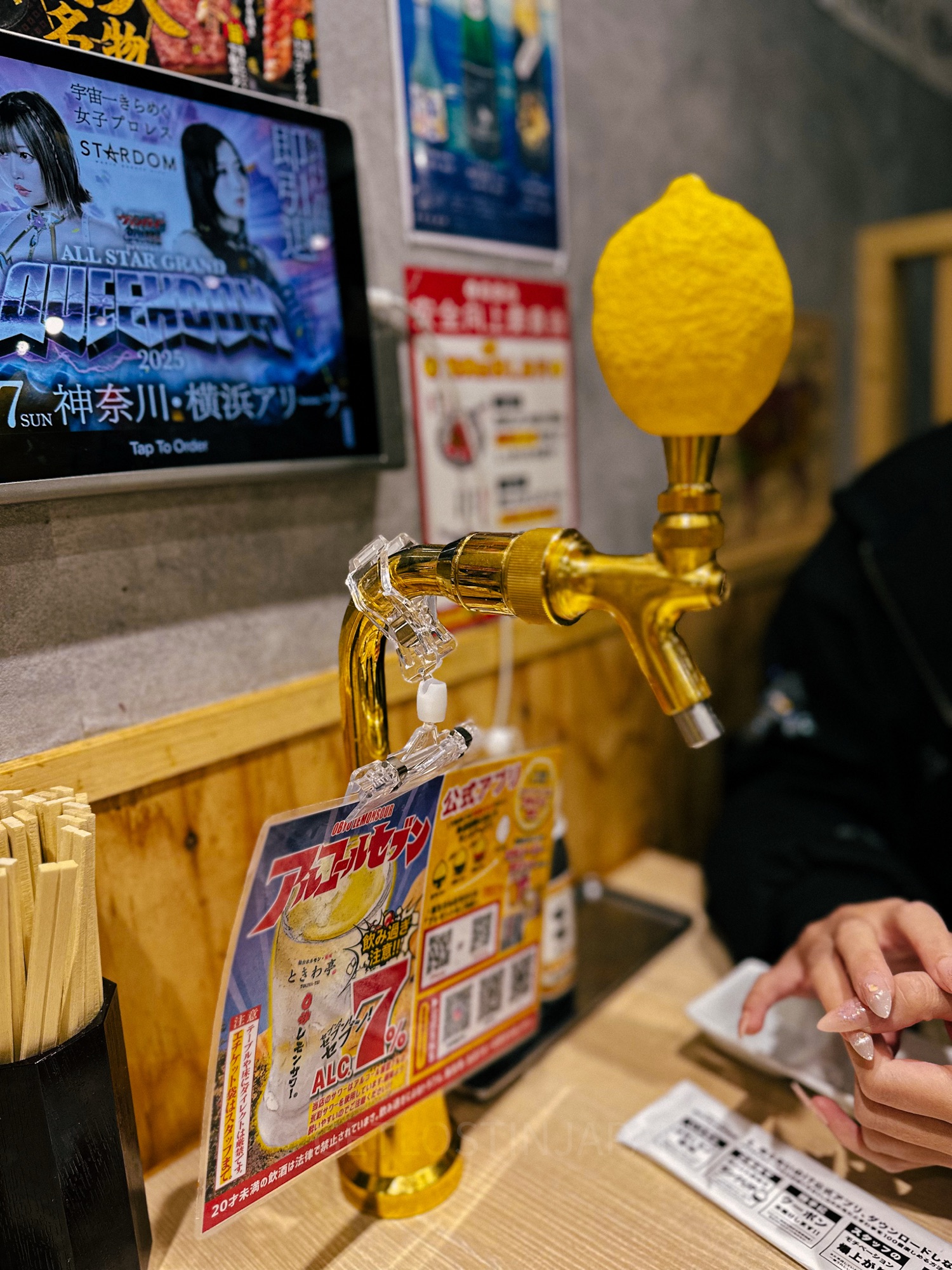
We made a reservation, but the restaurant surprisingly wasn’t that crowded. I think it’s more popular in Tokyo, which was lucky for us because it felt like a hidden gem!

Day 8: Day trip to Uji or Nara
Now, I’ve put a day trip on day 7, but feel free to switch it up according to your trip preferences.
Most first timers to Japan opt to include a day trip to Nara to see the bowing deer. It’s such a unique experience, and I definitely encourage going at least once, although admittedly it is pretty touristy. Uji is a bit harder to get to, and took me about 2 hours to get there and involved 3 different trains, but was completely worth it. I actually prefer Uji over Nara.
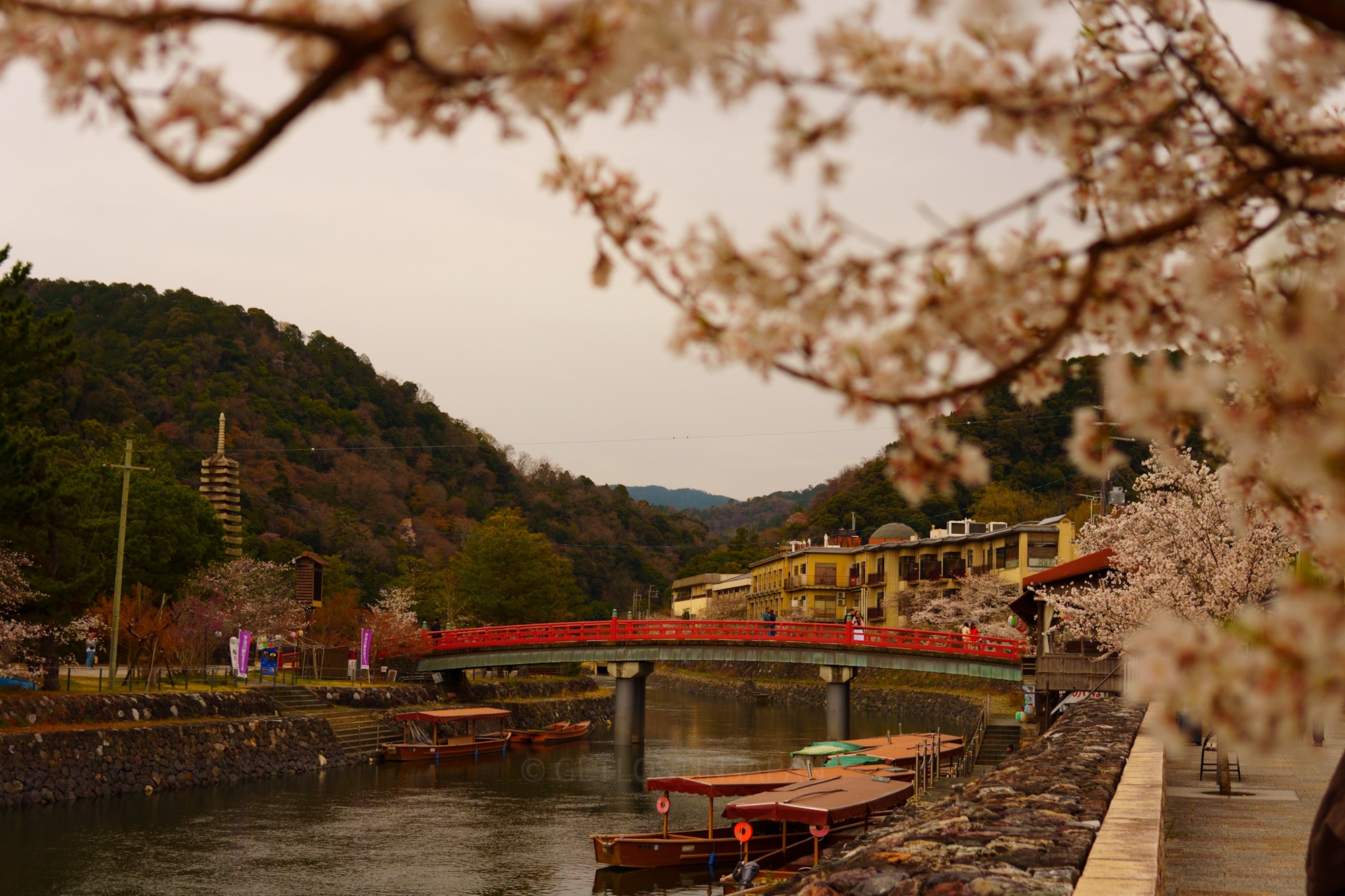
Both cities can be a day trip from either Osaka or Kyoto, and if you’re a real go-getter, you could even do both in the same day.
I’ll have to make a post with all my day trip details, but here are some highlights from each city so you have an idea.
🍵 Uji 🍵
- Handmade ceramics
- Traditional tea ceremony
- Matcha products
- Byodo-in temple
🦌 Nara 🦌
- Bowing deer
- Great Buddha of Nara
- Kasuga Taisha Shrine
- Mochi Pounding

Day 9: Osaka
Oh man, your Japan trip is almost over! Feel like planning your return trip already? Believe me, I feel you. I can’t help myself from returning to Japan year after year.
Anyway, today will be a transfer day from Kyoto to Osaka. It won’t be too bad, though, since the two cities are only 30 minutes apart, so you have plenty of time to explore Osaka!
Morning: Head to Osaka
It’s super easy to go between Osaka and Kyoto, which is why visiting these two cities is usually clumped together.
You don’t even technically have to move hotels between Osaka and Kyoto if you prefer to stay in one place for a longer duration, since the commute is so short.
I’ve stayed in Kyoto and commuted to Osaka before, as well as the other way around. If I had to choose, I’d rather stay in Kyoto and commute to Osaka because Kyoto has more sightseeing landmarks that close early, while Osaka’s shops stay open until 8 or 9 pm. However, in my personal opinion, hotels in Kyoto tend to be more expensive than Osaka, so you should consider that as well.
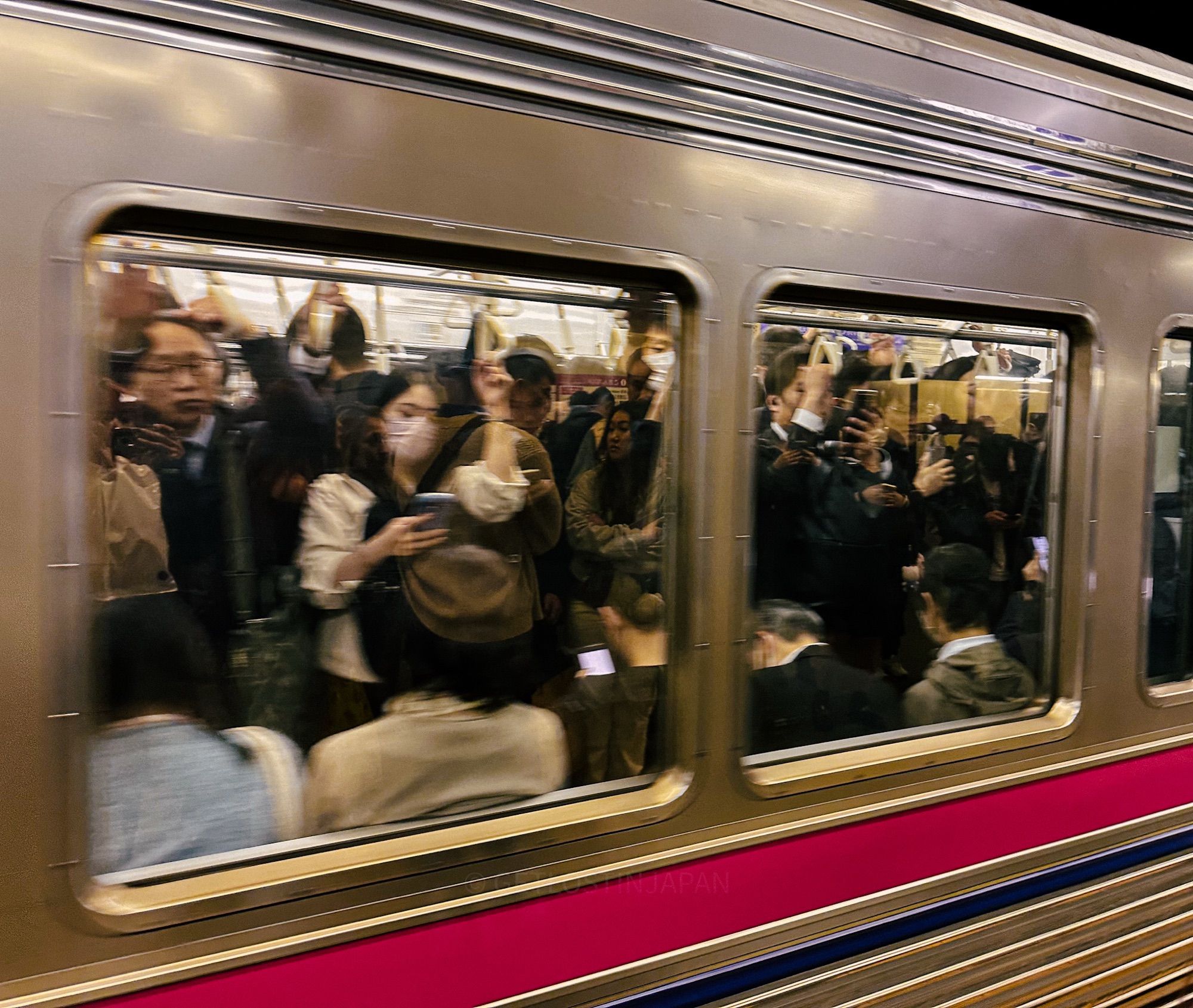
Take the Shinkansen to Osaka
I recommend hopping on an early train to Osaka since you only have two days to explore.
Getting to Osaka from Kyoto
There are a couple of ways you can get to Osaka. You can take the Shinkansen, which will take less than half an hour, or you can take the local train.
I’ve done both, and if you don’t have the Japan Rail Pass, which lets you use the Shinkansen for free, then the local train is a perfectly fine option as it’s also around 30 minutes. You’ll take the Limited Express A train from Kyoto Station to Osaka Station, and it’ll run you about 580 yen.
After dropping off your bags either in the train station or at your hotel, I recommend spending the rest of the day exploring Shinsaibashi and Dotonburi, which are within walking distance from each other.
Lunch: Dotonbori Street food
You should definitely take some time to try the street food in Dotonbori. It’s a buzzing street with lots of stalls and restaurants serving delicious snacks, and it’s fun walking around and looking at the crazy storefronts. You’ll know what I mean when you see the giant gold baby.
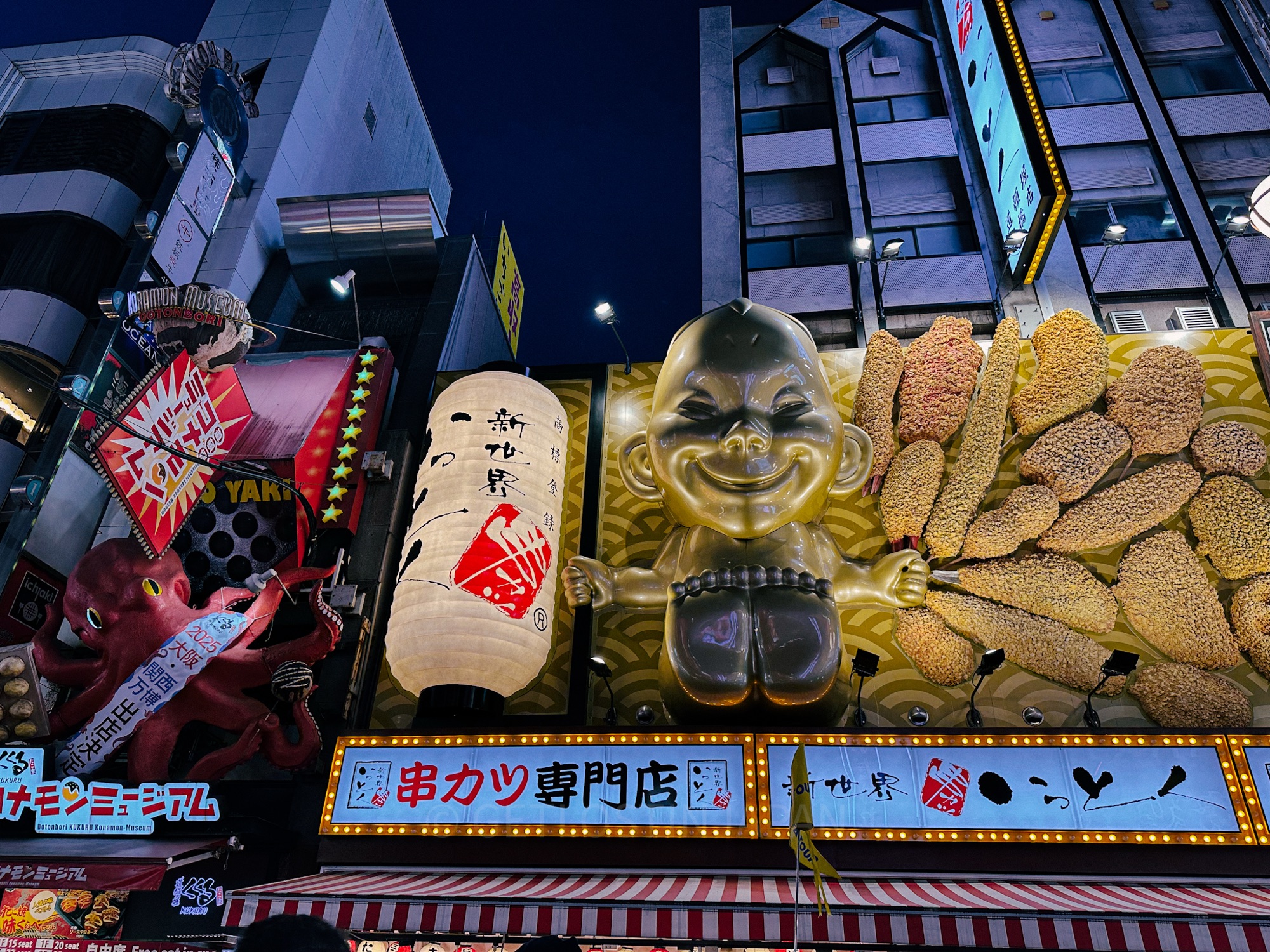
There’s high-grade Wagyu, sashimi, and other snacks you can buy as you walk around.
💡 Pro tip: Make sure to keep some cash on hand as many street vendors do not accept credit card.
My favorite foods in Dotonbori
- Takoyaki: The mentaiko takoyaki from Takoyaki Juhachiban was my favorite!
- Kobe Wagyu Skewers: You’ll find many street vendors, so take your pick.
- Melon Bread Ice Cream: We got the vanilla ice cream sandwich from a street stall, and it was delicious.
- Cheese Tart: Pablo’s is actually in Shinsaibashi, but it’s so good I can’t help but include it. There is a line, but it moves fast.
Afternoon: Shop in Shinsaibashi
Osaka is famous for its shopping areas, and Shinsaibashi is the iconic favorite due to its colorful screens, endless stores, and amazing street food nearby in Dotonbori. I’ve spent days browsing and wandering the shops here. This can easily take up the entire rest of your day if you want it to.
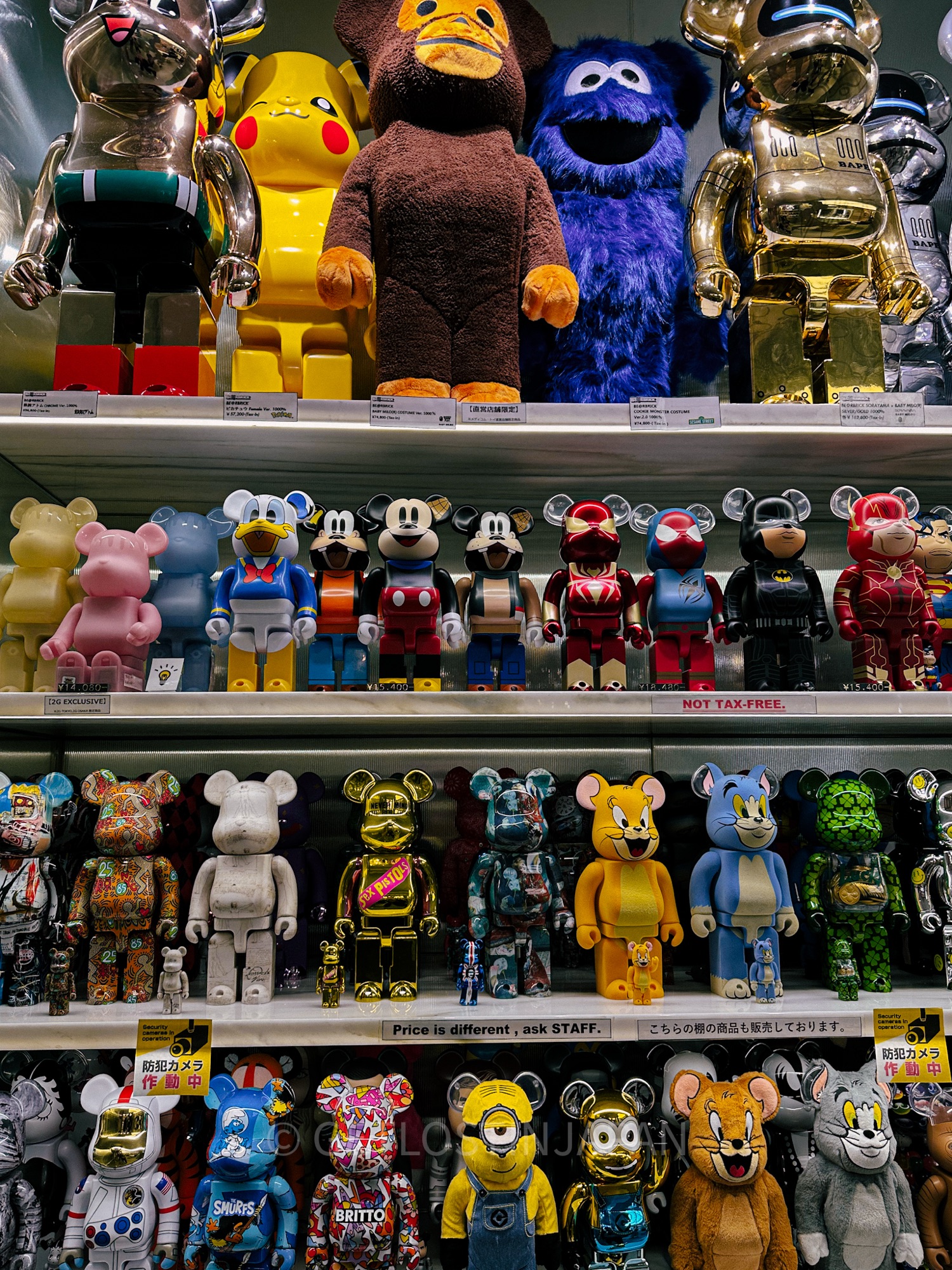
My favorite shops in Shinsaibashi
- Parco: A shopping mall that sells an array of clothing and goods like POPMART, Sanrio, Rilakkuma, Studio Ghibli, CAPCOM, and so much more. We bought a BearBrick from 2G here for around $95!
- BOOK OFF (PLUS): BOOK OFF+ is a huge thrift store selling lots of brand new clothing items at a discounted price, along with preloved luxury, tech, backpacks, you name it. I found great brands like North Face, Lily Rose, and some great skirts here for $8-10. I’m talking qualityyy pieces for great discounts.
- WEGO: A youth store selling Y2K and trendy streetwear for all genders. There are actually 2-3 WEGOs here, make sure to stop by the large one with multiple floors!
- GU: I love shopping at Uniqlo’s sister store whenever I’m in Japan. GU is connected to Uniqlo, so you can browse both while you’re here.
Dinner: Okonomiyaki
I highly recommend trying okonomiyaki while you’re here, as it originated from Osaka. There are a ton of okonomiyaki restaurants in the Dotonbori area, so take your pick.
I unfortunately can’t give a recommendation, as we accidentally went to the wrong restaurant and didn't love it. However, Ajinoya Honten has tons of reviews and is very highly rated.
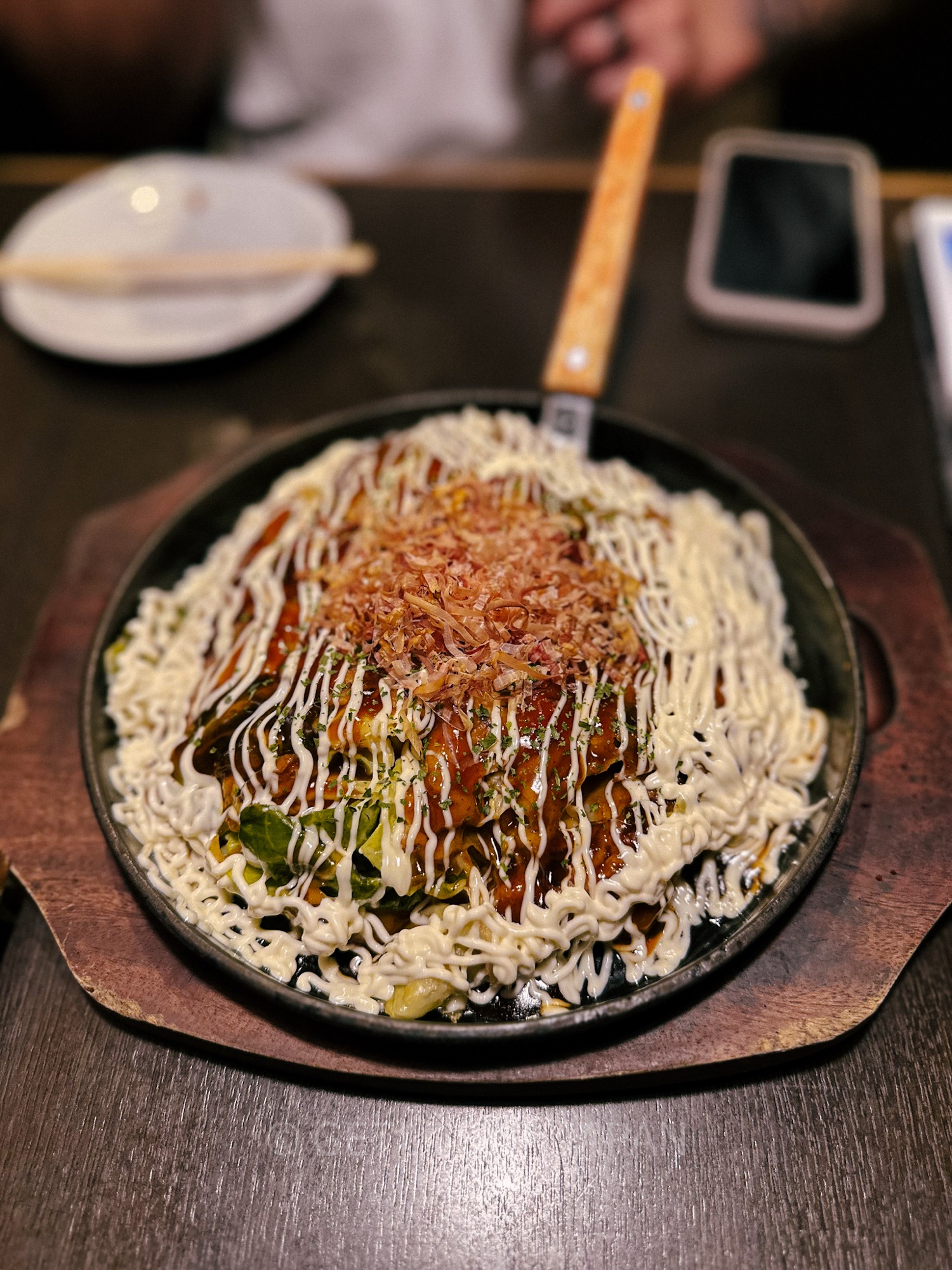
💡 Pro tip: Don’t follow the people holding restaurant signs and menus outside. There was a super popular restaurant we saw with someone holding a menu outside. When we followed him, thinking we’d be seated, he ended up taking us up 6 floors to a dead restaurant that wasn’t that good.
Evening: Nightlife in Osaka
As the night draws on, there are a lot of things you can do in the area. There are tons of bars and clubs around Shinsaibashi, and there are frequently live performances around the Ebisu River. Here are a couple of suggestions for nightlife in Osaka.
Walk along Ebisu Bridge
There’s always a lot happening around the Ebisu Bridge, due to all the foot traffic and restaurants. Last time I watched a live performer sing and play the keytar, all while wearing a furry dog mask. I don’t know how he managed to sing in that thing, but he was really good at it!
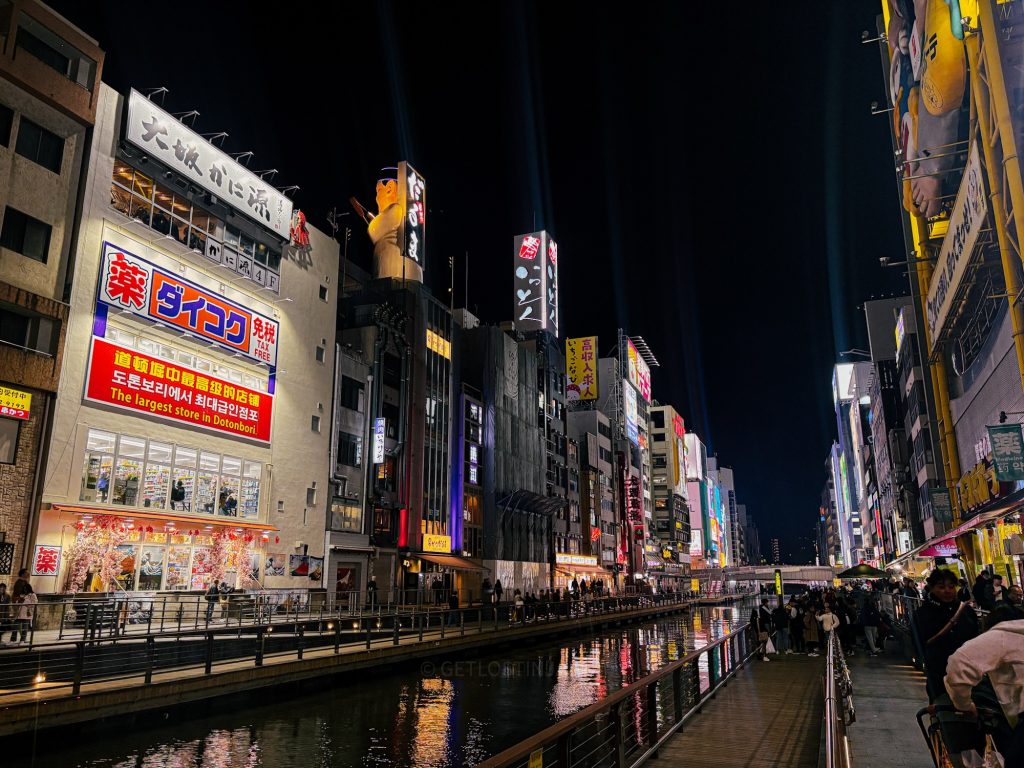
If you didn’t get a chance to see the famous Glico Man sign, nighttime is the best time to view it.
Clubbing in Osaka
There are tons of clubs in Osaka! I haven’t gotten the chance to go yet, but The Pink and Pure are on my list to visit.
Don Quijote
If you haven’t visited Don Quijote yet, there’s one in Dotonbori! This crazy convenience store has everything you could ever want or need. Japanese snacks, skin care, electronics, anime merch… the list is endless. Just try not to get the theme song stuck in your head by the time you leave.
Teamlab Osaka
While Teamlab Osaka is a bit out of the way, it’s a relaxing outdoor park that incorporates colorful light art. It’s not as good as the Teamlab exhibits in Tokyo, but it could be a fun activity if you don’t have anything to do at night.
The theme? Eggs. That’s just me assuming, but you’ll understand if you go…

Where to Stay in Osaka
There are a couple of great areas to stay in Osaka. My personal favorite is around Shinsaibashi. It’s the liveliest part of the city, in the middle of everything, and has tons of amazing restaurants and shops.
However, staying around Umeda or Namba would also be a great choice. Anywhere near a train station with lots of shops and restaurants are fine to stay at.
The Bridge Hotel Shinsaibashi
Now, I’ve had a string of bad hotel stays in Osaka, and I don’t want you to go through the same thing. The last hotel I stayed at was a 17-minute walk to Shinsaibashi with no good metro line, and while it wasn’t super far, it was kind of annoying to make the trek every day.
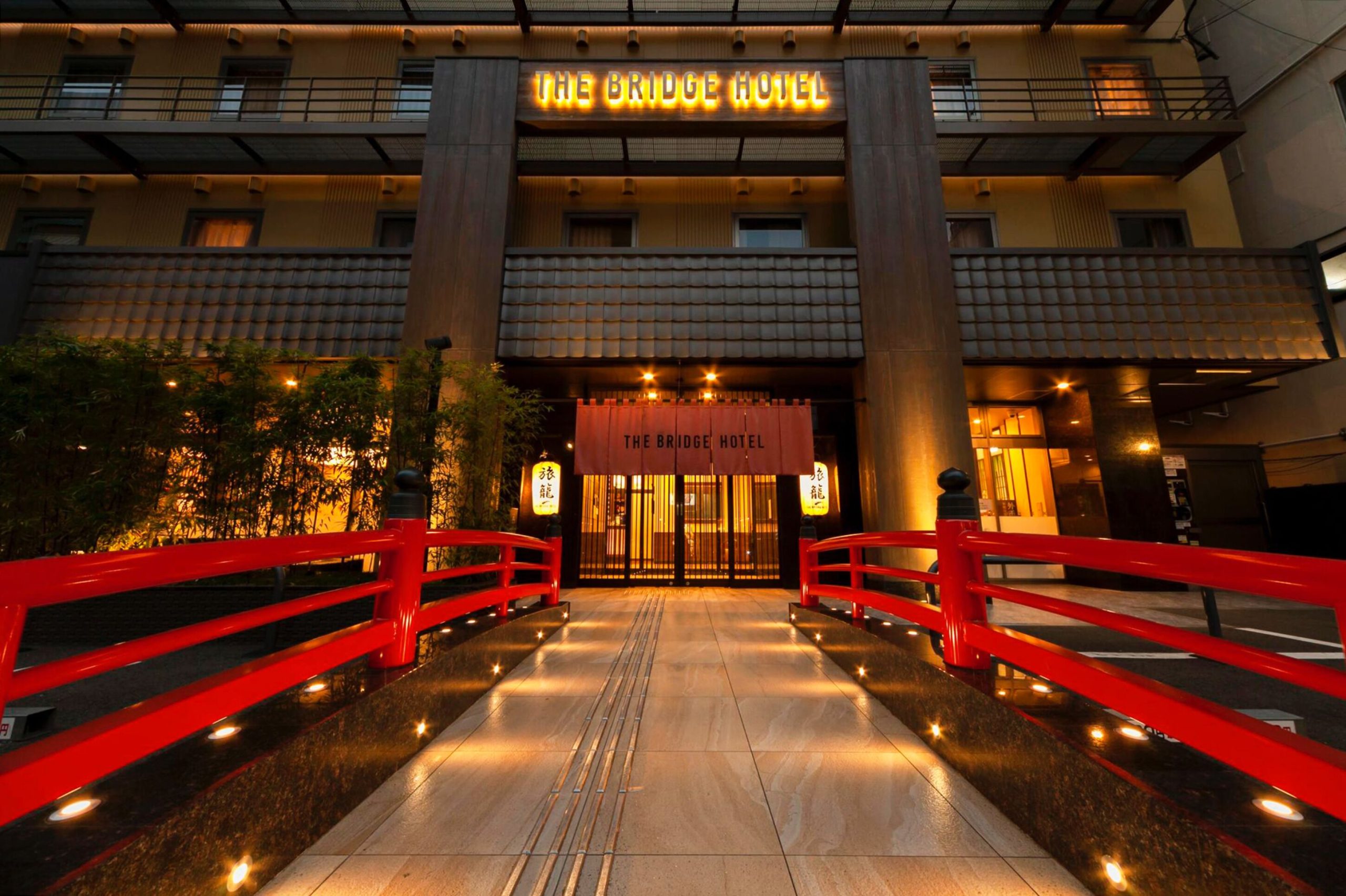
The Bridge Hotel is highly rated with almost 3,000 reviews, known for their abundant freebies and close proximity to Shinsaibashi. You’ll only be a 3-minute walk away from the Shinsaibashi train station, and right next to Parco where all the Shinsaibashi shops begin.
While the hotel rooms are clean and modern, the real highlight to this hotel is all the amenities you get. Free pocket wifi, a complimentary phone to make local calls (and some international calls!), free massage chairs, ramen and drinks, and even bicycle rentals! All! For! Free!

Day 10: Osaka
It’s our last day in Japan!! Although the trip is ending, I believe in my heart that you’ll come back again in the future. Let’s end our last day with a trip to Osaka Castle and Umeda Sky, with some shopping sprinkled in between.
Morning: Osaka Castle
Osaka Castle is a stunning monument that has stood the test of time, considering it was built back in 1583! It got a major renovation in 1997 and has been captivating visitors with its charm ever since.
To get to the castle, you’ll head to Osaka Castle Park, which is especially beautiful during cherry blossom season and is one of Osaka’s most popular hanami spots. You can visit either Osaka Castle Park or the lesser-known (but equally scenic) Nishinomaru Garden. Just note that there’s a small entrance fee for Nishinomaru.
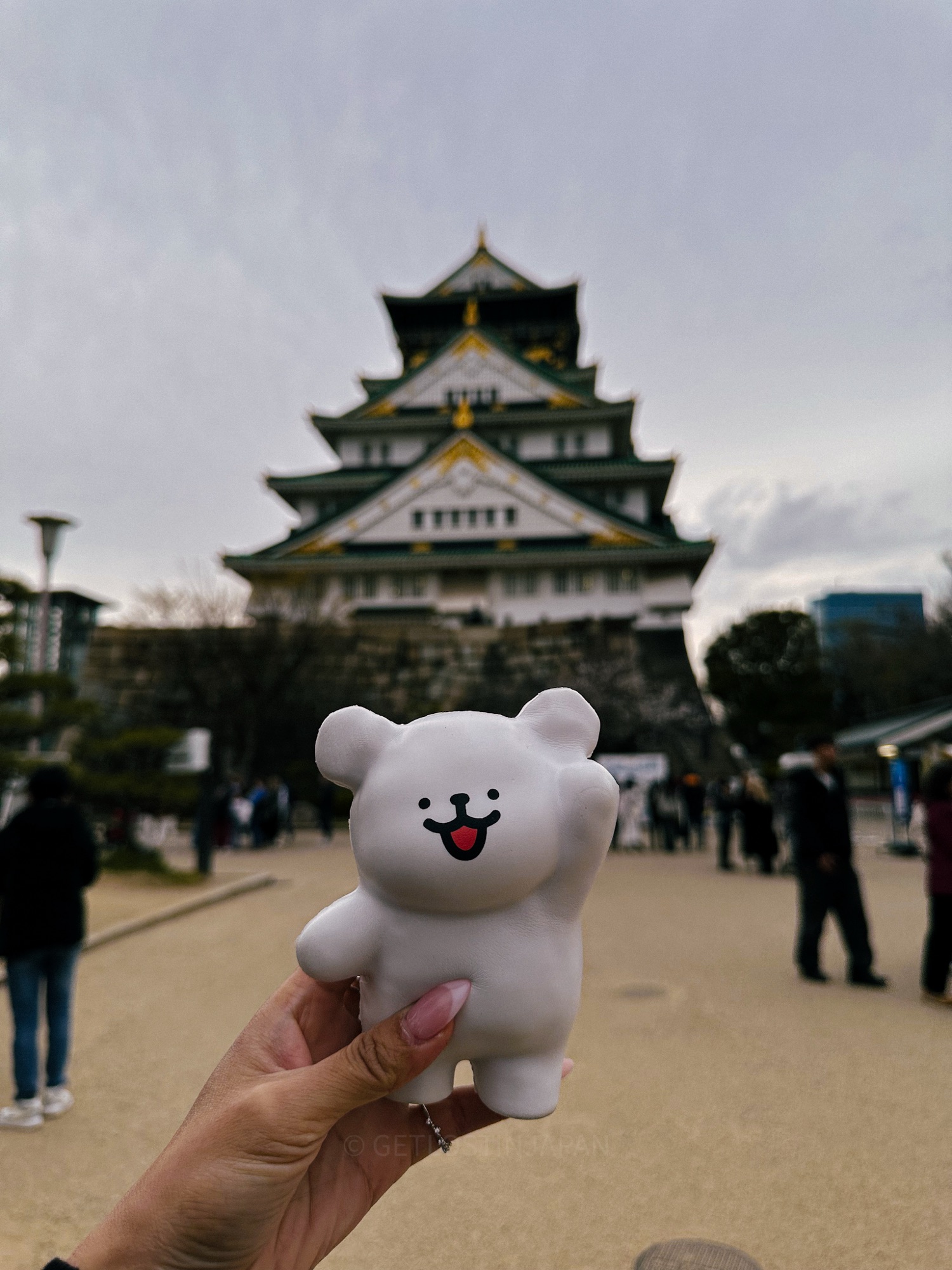
I ended up going to Osaka Castle Park because we saw lots of street vendors there, and I wasn’t sure if there was any food inside Nishinomaru Garden.
Around the park, you’ll find street stalls selling yakisoba, sausages, sweet corn, mochi, and all kinds of desserts—and you’ll also get an amazing view of the castle!
I didn’t go inside the castle because I planned on going to Nijo Castle instead. The interior of Osaka Castle has been completely modernized, and it has a small museum where you can learn about the castle's history.
Lunch: Italian Fusion
If you start getting hungry but don’t want to leave the Osaka Castle area just yet, you can visit Crossfield inside the Miraiza mall.
Crossfield with TerraceLounge is a stylish Italian/French/Japanese fusion restaurant that serves modern course meals with a relaxing view of Osaka Castle.
This restaurant is located on the 2nd floor of the mall, and has a chic, classy atmosphere. The lunch course sets aren’t too expensive either, starting at 2,500 yen. They also serve afternoon tea with an array of sweets!
Eating lunch here would be perfect so you can spend a few hours in the afternoon exploring the Miraiza Mall afterwards.
Afternoon: Miraiza Osaka-Jo
The Miraiza Osaka-Jo mall is conveniently located right next to Osaka Castle, and has a unique capsule museum and tons of fun shops that you can spend some time browsing.
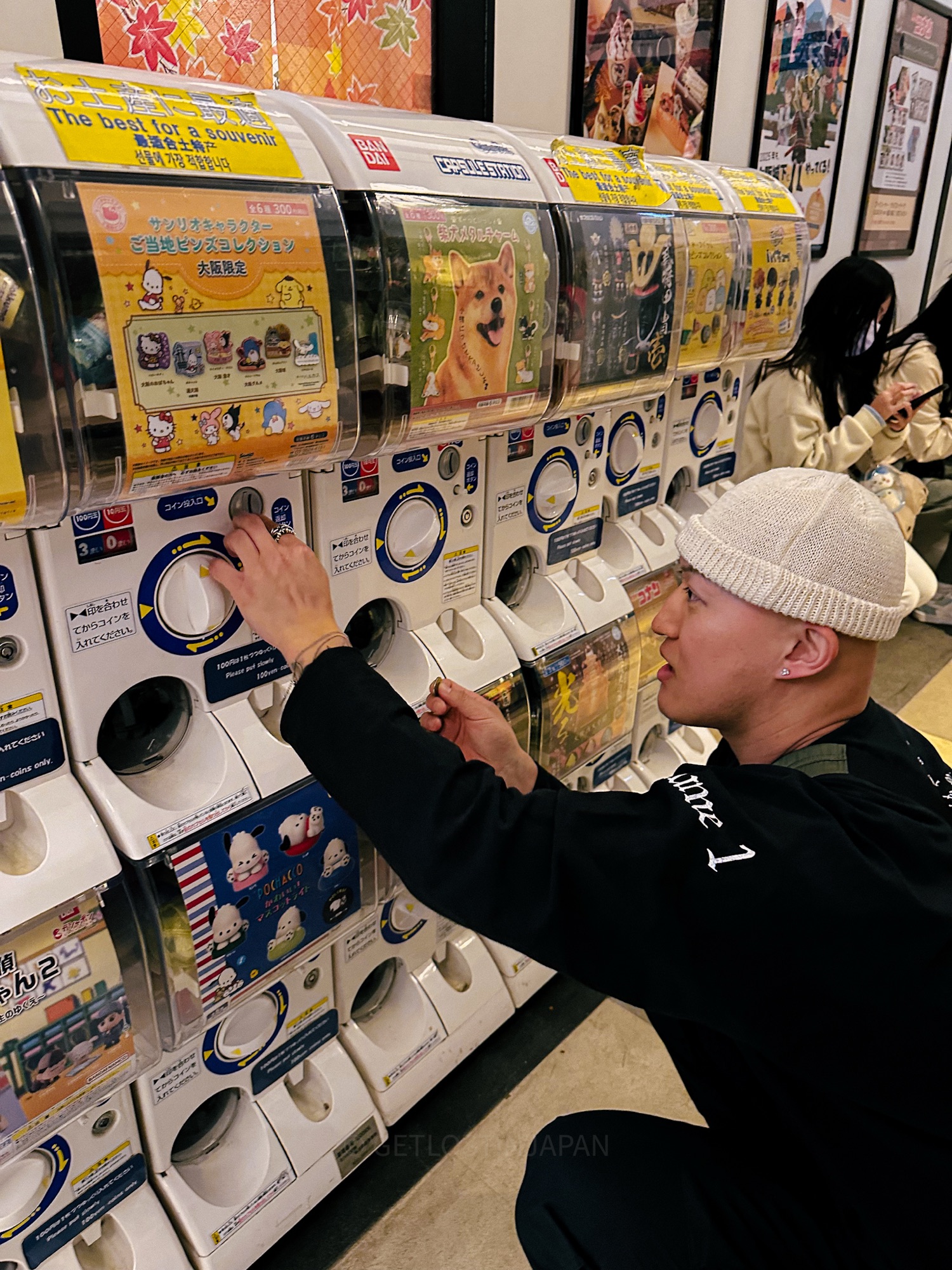
The building already looks alluring from the get-go, with its historic features.
I wanted to check out the Kaiyodo Figure Museum, which features over 3,000 Kaiyodo pieces, but we came around too late. We wandered into the mall around 16:00 when all the stores were closing, so we didn’t get to explore it thoroughly. I had no idea such an interesting place would be next to the castle, but at least you’ll be better prepared!
Once you’re ready, start heading to Umeda, where we’ll do some shopping and end our day at Umeda Sky.
Evening: Umeda
There are a lot of great malls to visit in Umeda for last-minute souvenirs and purchases. I personally recommend Yodobashi, Grand Front, and LINKS. These malls have a variety of items and have a good mix of bargain items and luxury items.
When I visited, I didn’t know which mall to go to, so I ended up going to Hankyu. Hankyu is a very nice mall too, but it’s almost exclusively for luxury, and all the storefronts are very high-end.
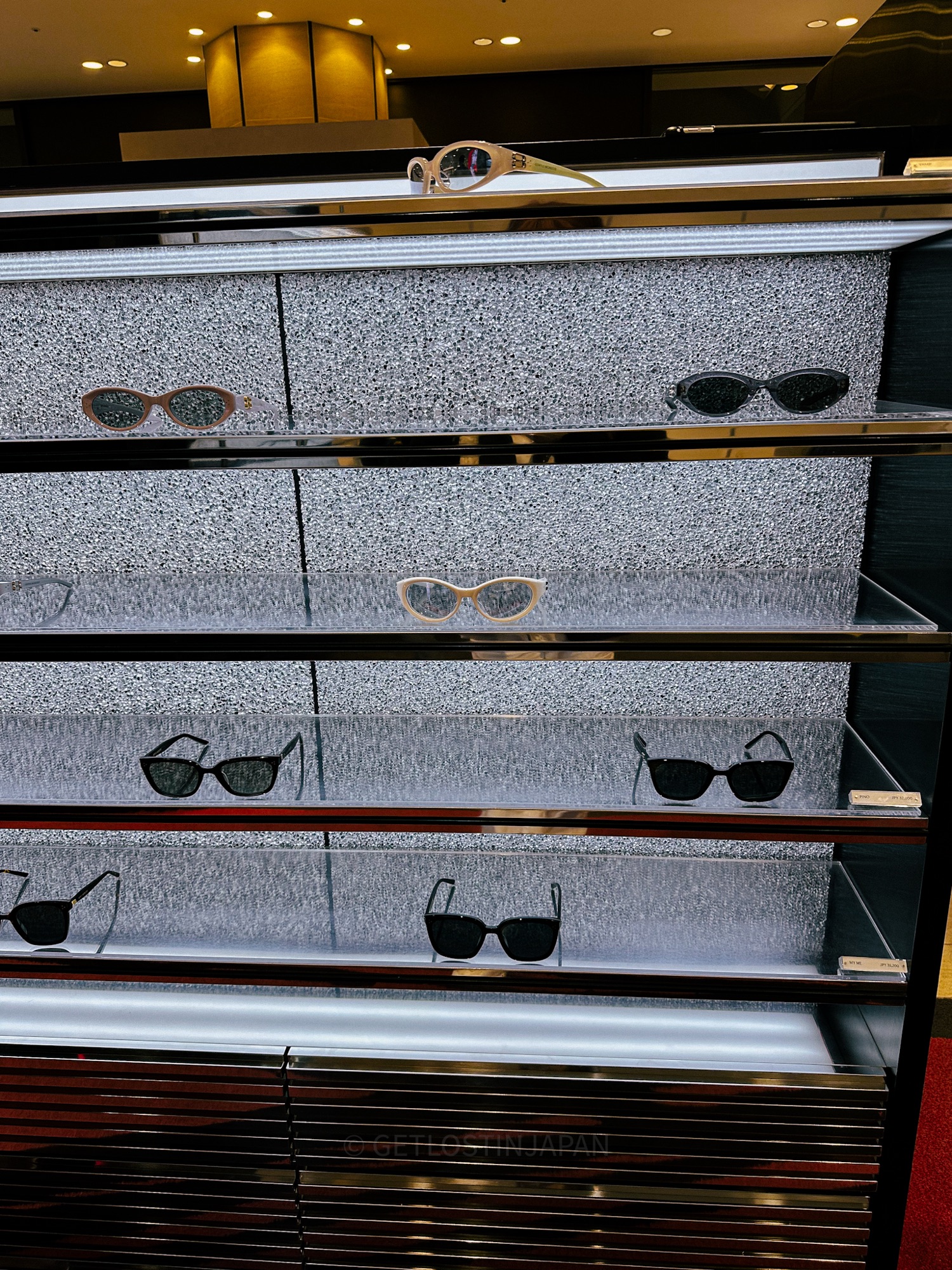
We got to visit the Gentle Monster, and my friends bought some sunglasses for a great discount compared to America, but I would’ve preferred to shop somewhere with a wider range of prices—not just luxury, but more budget-friendly options too.
Dinner: Sukiyaki or Omakase
We were exhausted after walking around all day, so we didn’t wander too far for dinner. I had chewy udon and sukiyaki from Nishiya on the 7th floor of Grand Front, and it was really good! The 7th floor is almost all restaurants, and many of them looked very tasty.
They were able to seat 8 of us pretty quickly without a reservation.
I recommend getting the double meat portion if you’re a meat lover. I love the sweet taste of sukiyaki, and the raw egg as a topper pairs perfectly. Yes, eating raw egg may sound a little weird, but trust me, it’s so good. Once you have a taste, you won’t look back, my friend.
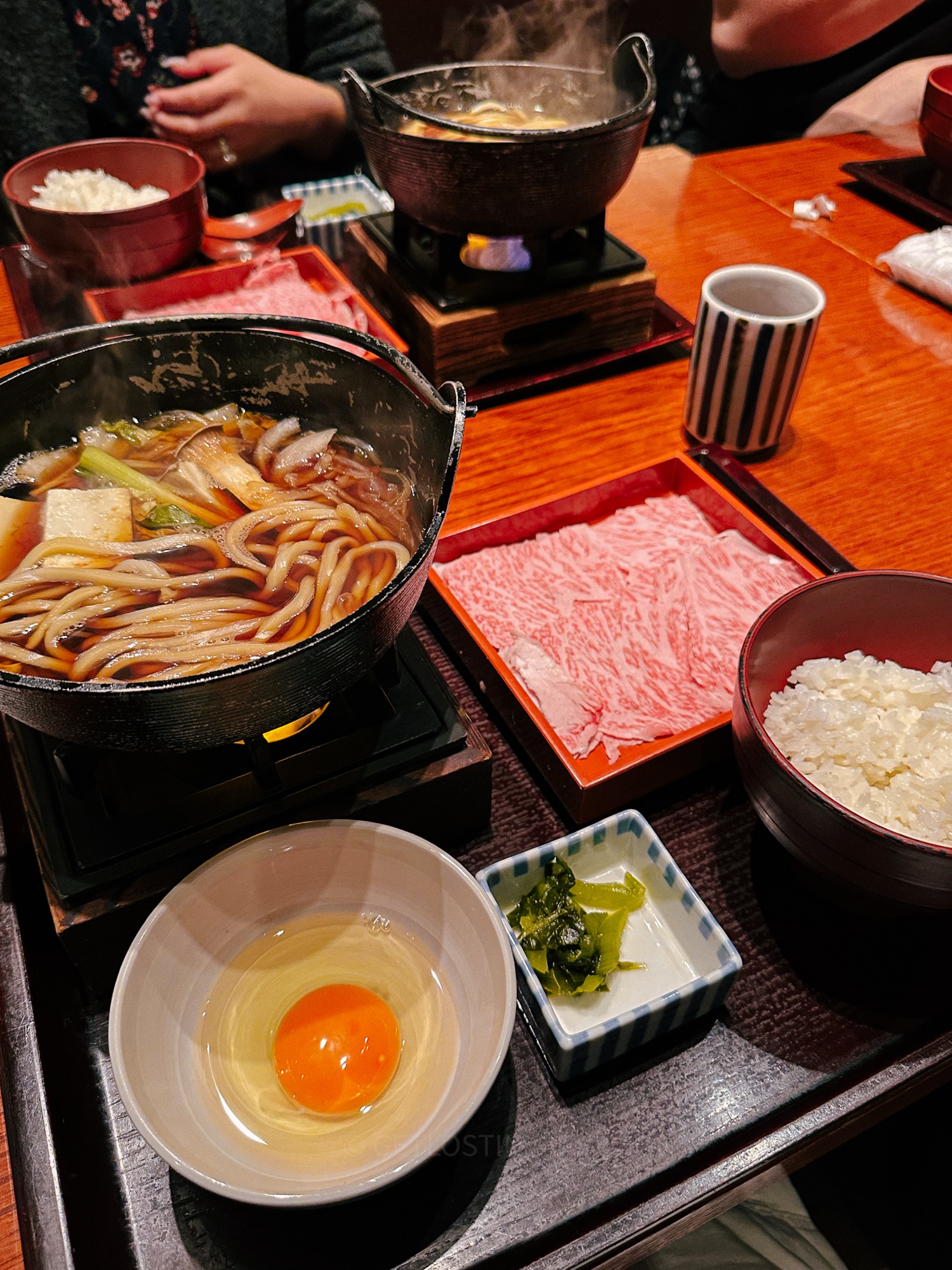
Or, if you’d like a more upscale dinner to commemorate your last night, Sushi Hijiri is a famous omakase restaurant in Fukushima close by to Umeda. While this restaurant is quite difficult to reserve, it’s been gaining popularity increasingly fast.
This restaurant is run by younger chefs who have been consistently praised to be the new stars of the next generation. If you manage to snag a spot at this restaurant, it may be the best dinner of your entire trip.
💡 Pro tip: This restaurant is reservation only, and opens at 12:00 on the first day of every month.
Evening: Umeda Sky
The Umeda Sky building is only a 6-minute walk from Grand Front, so it’s not too far.
When you purchase a Umeda sky ticket, it’s valid for the entire day, so don’t worry about a timed entry.
If you book on Klook, there’s an exclusive offer to purchase couple locks as well! You can add your names and the date, and hang it at the top of Umeda Sky. Don’t feel like you have to be a couple to buy it either, because my single friend bought two 😉 This offer isn’t available in person, only online.
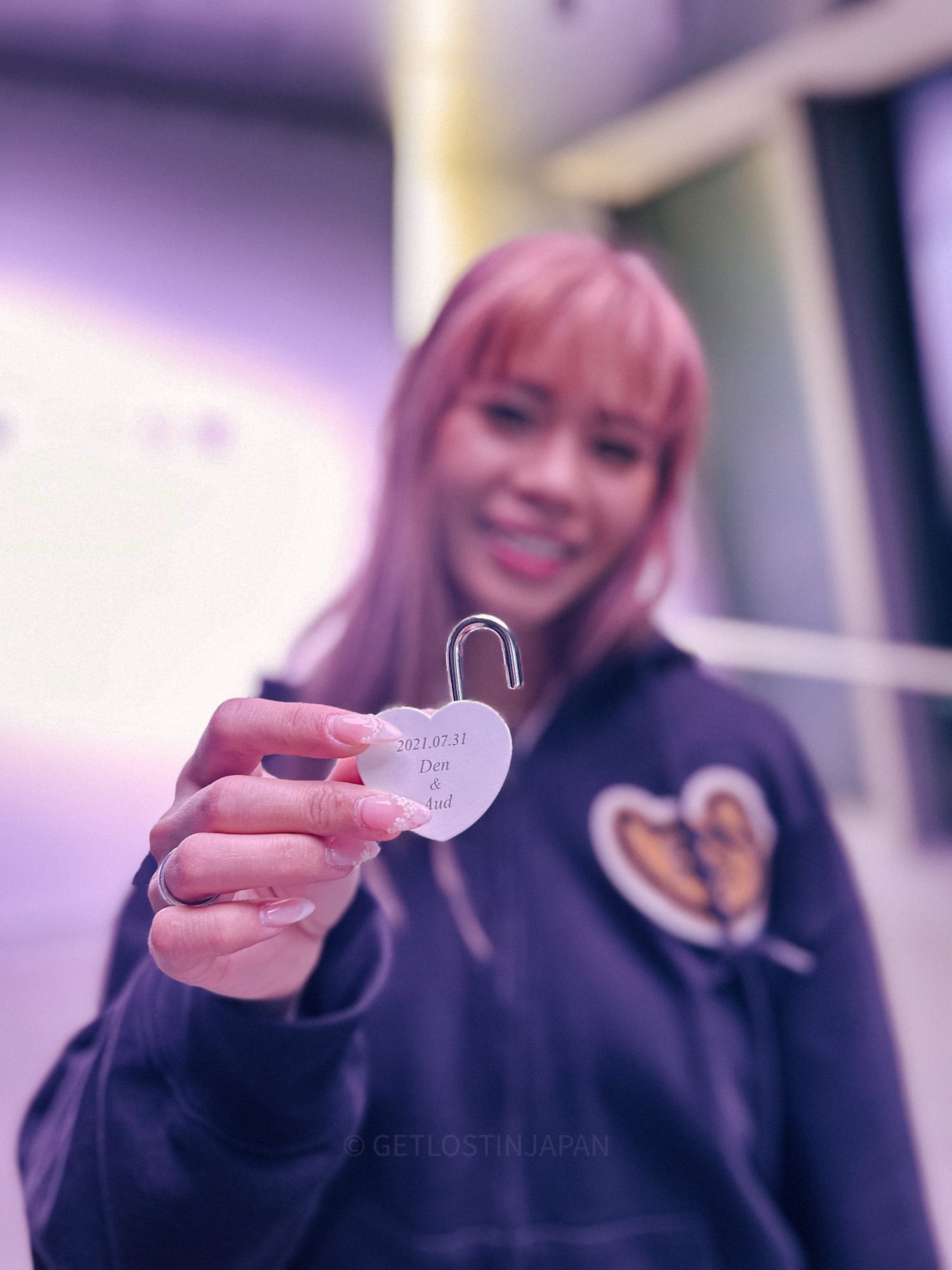
It was pretty chilly when we went, so we didn’t stay for long. But it was a nice view of Osaka, and the glow in the dark floors was a unique touch. I think it was worth a visit, and if you come during warmer weather, it’ll be much more enjoyable.

Trip Variations
- You can add a day trip to any day of your trip, it doesn’t have to be on Day 7.
- I left the itinerary more bare during travel days to accommodate for rest and fatigue, however, feel free to add more to the schedule if you prefer!
- Possible day trip options
- From Tokyo: Nikko, Hakone, Kawaguchiko, Yokohama
- From Kyoto/Osaka: Uji, Nara, Kobe, Katsuoji Temple

Renting a Car in Japan
While Japan's trains are seriously incredible, and you can get by most of the time with public transportation, you can’t beat the convenience a car brings.
I loved renting a car and exploring Japan's scenic routes, and while I don't recommend renting a car in Tokyo or Osaka, Kyoto is spaced out enough that it won't be overwhelming. Plus, if you decide to head off the beaten path driving gets much easier.

We used Orix with Booking and were able to rent our car easily. You can check prices, filter for the type of vehicle you want, and add affordable full coverage insurance.
Tips for Renting a Car in Japan
- Drive on the left: In Japan, you’ll be driving on the left side of the road, and the steering wheel is on the right. It’s not too difficult to get the hang of, but go easy to have some time to adjust before driving in the city.
- Learn the rules: I recommend watching a YouTube video about the rules. You have to come to a FULL stop at the stop signs, big red signs that read “止まれ”. Always remember that pedestrians have the right of way, and make sure everyone in the car wears a seatbelt.
- Get car insurance: Between tiny parking spots, winding mountain roads, and the occasional wildlife sighting, it’s worth the peace of mind. When you use Booking, you have the option to add insurance at checkout.
- Pick a car that fits: Japan isn’t exactly known for wide open roads, especially in the countryside or older towns. A small or mid-sized car is usually best. Booking lets you filter by size, transmission, and even luggage space, so you know what you’re getting.
- Watch out for toll roads: If you’re planning to use the expressways, it’s best to include an ETC car,d as Japan has a lot of toll roads. The card makes paying tolls way faster and way less stressful than having to look for cash.
What you need to rent a car in Japan
- Bring your valid license from your home country.
- An International Driving Permit (IDP) based on the 1949 Geneva Convention (Japan won’t accept anything else!) We got ours in 20 minutes with AAA in the States before we left for Japan.
- A credit card under the driver’s name for the deposit.
- Most rentals require you to be at least 18, but some might want you to have had your license for a year. If you're under 25, there might be a young driver fee.
Ready to give left-sided driving a spin? Click here to book with Booking!

Don’t Forget Travel Insurance
While traveling in a foreign country, it's essential to get full coverage trip insurance just in case of an accident or illness. I recommend VisitorsCoverage for affordable prices and great insurance benefits.
Additionally, if you have the Chase Sapphire Reserve Credit Card, you get automatic trip insurance!

What to Pack for Japan
Less is more when you’re packing for Japan! I like to bring 3-4 sets of clothes and buy/thrift the rest. I recommend putting your carry-on inside your full-sized luggage and checking it in, and only bringing what you need in a personal item onto the flight. It’s much easier to transport once you land.
- Layered clothes
- Walking shoes
- Portable battery
- Cash (I recommend $1000 for a 10-day trip)
What you don’t need to pack
- Umbrella
- Toothpaste
- Body wash
- Shampoo conditioner (unless you prefer your own)
- Slippers
- Pajamas
- Outlet adapter (you’ll use the same as USA unless you need a three-prong plug)

Free Map: 10 Day Japan Itinerary

Japan Itinerary 10 Days: FAQs
Here are some possible questions you may have for your upcoming trip! If your question isn’t listed here, feel free to comment on the post so I can add it.
Is 10 days long enough in Japan?
Yes, 10 days is enough to visit Japan, as long as you’re not counting the days you arrive and depart. 10 full days is plenty to see most of the best sites in Tokyo, Kyoto, and Osaka, though I’m sure you’ll wish that you had more time.
Which month is best to visit Japan?
My favorite month to visit Japan is 100% late March-April for cherry blossom season. The country just flourishes with beautiful blooms everywhere, and it’s simply magical. Secondly, I also enjoy visiting in November for vibrant fall foliage.
Is Japan expensive to visit?
Some people may argue, but I believe that Japan is pretty expensive to visit. The yen-to-dollar conversion is terrific right now, so Japan is definitely cheaper than the United States, but if you’re not too careful, all the prices can start to add up!
It also depends on your interests. If you enjoy luxury goods, lots of shopping, and high-end cuisine, then it’ll definitely get a little pricey. Japan has everything, so it’s easy to get swept up.
It boils down to your preferences, really. You could spend your days eating convenience store food and be perfectly happy, or you could enjoy a Michelin-star restaurant.
Do I need Pocket Wi-Fi?
You don’t need pocket wi-fi as long as your phone carrier supports international data roaming. However, speeds tend to be slower. Pocket wi-fi like Sakura Mobile or buying affordable data like Airalo is preferred so you have fast speed roaming at all times.
How much cash should I exchange?
I recommend pulling out $600-1000 for a 10-day trip. I’ve brought $500 and it wasn’t enough, and I’ve also brought $1000 and it was too much!
💡 Pro tip: 7/11 ATMs do not have any foreign transaction fees, so you can pull cash there for free as long as your bank does not have international fees!

Conclusion: Japan Itinerary 10 days
Now you’re prepared with everything you need for your first trip to Japan! I’m honestly so excited for your travels, and I hope my tips are able to help you have the best time. Even though I’ve been to Tokyo, Kyoto, and Osaka multiple times, there is always something new to explore, and I just can’t get enough of visiting Japan. So I hope you love it just as much as I do!
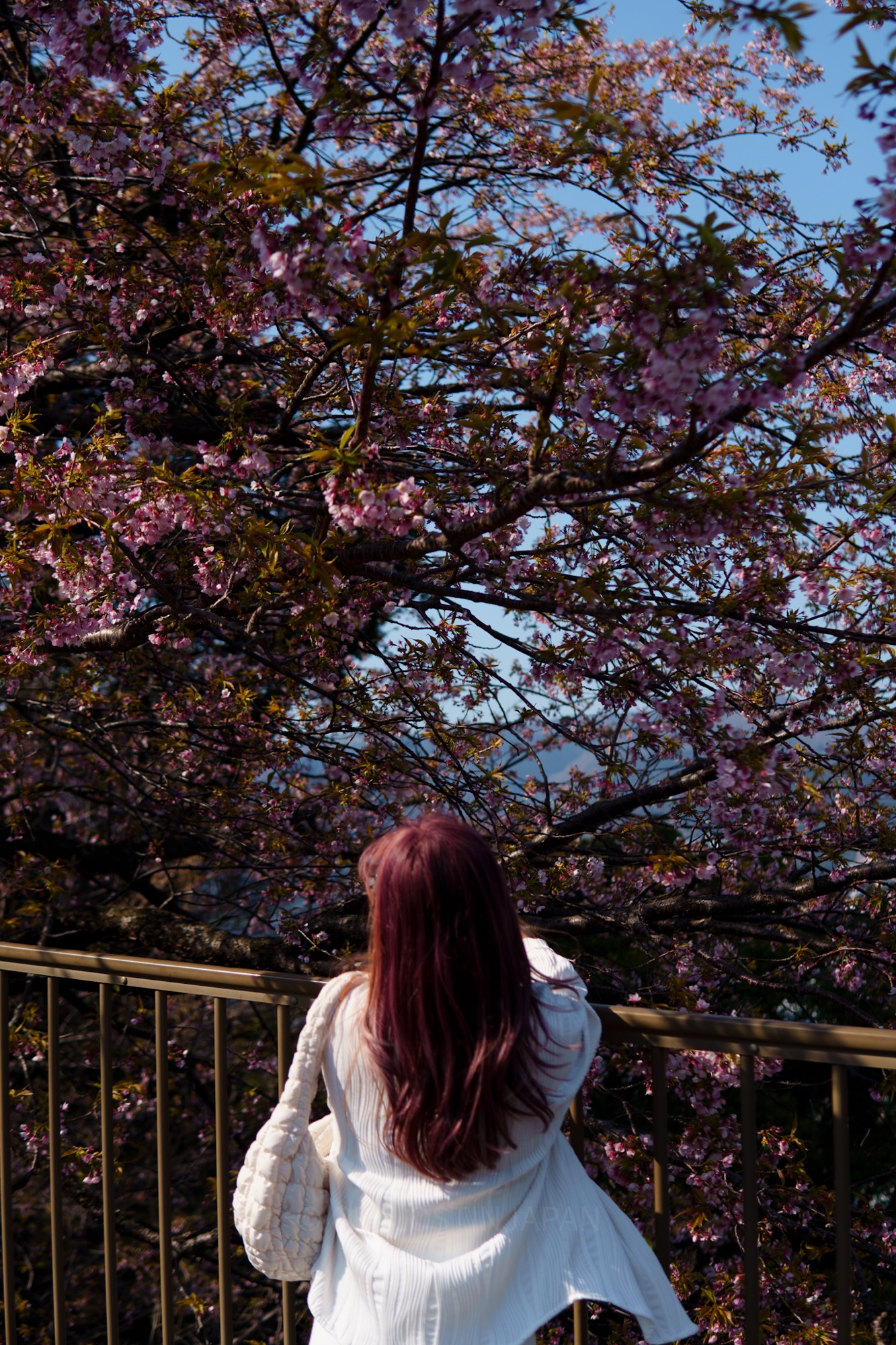
If you need any assistance planning your trip, I’m always available at audrey@getlostinjapan.com. Let me know how things go, what you loved, what you wish you skipped, I want to hear it all!
Related Posts
The Best Area To Stay In Tokyo For First Time Visitors: Ultimate Guide
